Australian
and international
exploratory
performance and
media arts
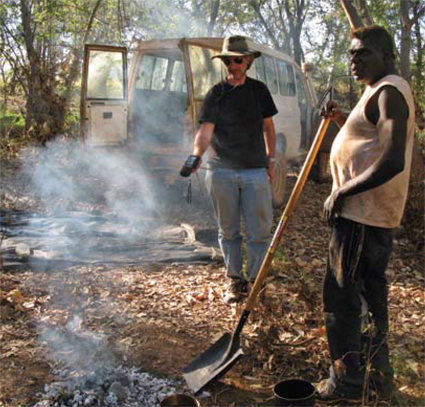
Philip Samartzis and Gabriel Nodea, field recording near Warmun
photo courtesy the artist
Philip Samartzis and Gabriel Nodea, field recording near Warmun
AFTER THE EPIC SCALE OF WARMUN’S DISASTROUS FLOODING EARLIER THIS YEAR, PHILIP SAMARTZIS’ SITE-DETERMINED SOUND WORK, DESERT, OFFERED AN OPTIMISTIC ACCOUNT OF A COMMUNITY RE-BUILDING. SAMARTZIS AND HIS ASSISTANT MADELYNNE CORNISH’S SUPERB FIELD RECORDINGS RETAINED AN IMMEDIACY THAT DERIVED FROM THE RAPID SEQUENCE OF THEIR SOURCING, MIXING AND PRESENTATION WHILE ON LOCATION IN THE EAST KIMBERLY.
Despite the richness of metal and diesel in the work’s composition, reflecting the extensive reconstruction that is underway, it was more suggestive of the gentler comforts afforded by the particularities of daily life. Weightier and more ephemeral elements were juxtaposed in a piece that arose out of human apprehension of the recent calamities rather than from any cosmological vantage point. The work’s relatively even tempo, warm tone and its indexical rather than metaphorical relationship to its context adeptly drew attention to the sonic pleasures of unremarkable things.
Samartzis’ residency was part of Tura New Music’s ongoing Remote Artist in Residence Program and was hosted by the renowned Warmun Art Centre. The five-week residency concluded with an evening outdoor presentation attended by not only the senior Gija painters who advised Samartzis and Cornish but also roadhouse staff, police officers, fellow arts workers from Kununurra and local families. The presentation of the work was followed by a barbecue and a ceremonial dance (joomba) led by elder Patrick Mung Mung in a sung and spoken commentary.
Unlike its presentation in Perth as a work for eight spatialised loudspeakers, the work was not presented in Warmun in an immersive way. Rather it was conveyed through a single speaker and accompanied by Cornish’s photographs taken during the residency at the request of Art Coordinator Maggie Fletcher who was concerned about providing support for the reception of the work. Samartzis did not hesitate to follow her advice and so this first version was mixed with the images in mind while ensuring that image and sound were not synchronised. At the performance, the audience was attentive and there were many moments of animated recognition with even the dogs responding to the canine sounds in the work. In subsequent days, the painters continued to check with Samartzis and Cornish that they had not forgotten to capture particular sounds before their departure.
Samartzis has undertaken residencies all over the world. Like most Australian artists, he has sought to prove himself in institutions, generally located in the Northern Hemisphere, that have an international reputation for their artform before travelling as a more mature artist to destinations such as Antarctica where the production and presentation of art is less prescribed. Despite his experience, however, Samartzis confessed to some anxiety about going to Warmun. He questioned the timing of the residency knowing that his presence would place demands on a traumatised community. Community members have spent most of the year in an evacuation camp in Kununurra and are now back in construction camp lodgings in Warmun awaiting the completion of housing.
Samartzis also felt the weight of the artistic traditions of the region, of which painting has the highest profile. Warmun is home to artists such as Mung Mung, Mabel Juli and Lena Nyadbi who command the attention of curators and collectors across Australia and beyond. Although Samartzis and Cornish connected with the Warmun school and general community as ‘art professionals,’ a feature of this residency was that they enjoyed a relationship with artists of a stature greater than their own.
As these factors were shaping his thinking about the project, Samartzis and Tos Mahoney, Tura’s Artistic Director, conceptualised the residency as creating alternative spaces for the discipline of sound. By framing the residency in this manner, Samartzis imagined himself working alongside artists who are primarily painters while also envisaging that the artists could potentially make sound works in the future. This transactional approach was underpinned by the intention from the outset of the residency that Samartzis’ work would enter the Warmun Art Centre Collection once its extensively damaged paintings have undergone conservation and been restored to the community.
Samartzis also generated his work during a time when there has been a revival of interest in carving and other three-dimensional processes at the Centre. During my visit to Warmun, artists told me of this development and their recent success at the Darwin Art Fair. Accordingly, it is appropriate to consider how Philip Samartzis’ presence might have played a part in the re-emergence of the Centre after the floods or even contributed to these artists’ approaches to innovation. Once Samartzis’ work was presented, the senior artists perceived it as not only confirmatory of their community but of shared artistic concerns. They identified with the representation of their country in the work but also with the sense of place inherent to Philip Samartzis’ methodology. Together with Samartzis and Cornish, they quietly acknowledged the sustaining nature of the artistic processes associated with both rendering sound and expressing Ngarranggarni (Dreaming) images and stories and how from the Warmun perspective they have always intersected.
See also Gail Priest’s review of Samartzis’ surround sound concert in Perth presented as part of Tura’s Totally Huge New Music Festival
Philip Samartzis’ residency was assisted by Tos Mahoney, Artistic Director,Tura New Music, Gabriel Nodea, Warmun Art Centre Chair and Centre Staff, Gary and Maggie Fletcher, Rosie Holmes and Alana Hunt.
RealTime issue #106 Dec-Jan 2011 pg. 40
© Jasmin Stephens; for permission to reproduce apply to realtime@realtimearts.net
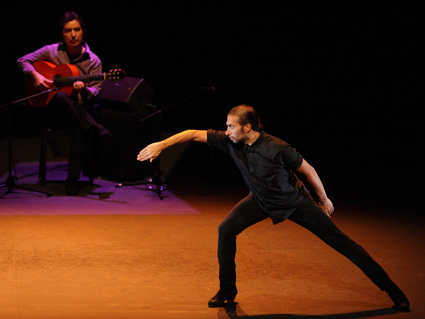
Alfredo Lagos, Israel Galván
photo Felix Vazquez
Alfredo Lagos, Israel Galván
ISRAEL GALVÁN, WHO APPEARED IN SYDNEY’S SPRING DANCE THIS YEAR, IS ONE OF A NEW BREED OF FLAMENCO ARTISTS IN SPAIN WHO ARE ‘RENOVATING’ THE FORM. A PRODUCT OF THE 19TH CENTURY, FLAMENCO IS A DANCE STYLE THAT IS BEING REINTRODUCED TO ITS MODERNITY BY GALVÁN.
The son of flamenco dancers Jose Galván and Eugenia de Los Reyes, Galván created his first work in 1998 and is currently touring a strong repertoire to major festivals. I spoke to him during his time in Sydney which followed my encounter with Galván’s work in France at Montepellier Danse (RT105). There, his 2005 piece Le Edad de Oro (The Golden Age) was an antidote to some dance work that seemed lost in an internally focused discourse, perhaps supporting the charge that contemporary dance is ‘eating itself.’ Translator Gina Marie Shrubsall describes Galván’s manner of talking as haiku-like, suggesting an empathy between his thinking and dancing. As described in RealTime 105 the latter has a refined simplicity of line, form and rhythm that is no less radical in its nature, .
Working with Pedro G Romero who provides dramaturgical support and commentary, Galván’s ‘revolution’ is perhaps best understood not as ‘moving with the times’ but as ‘updating the new aspects’ of the dance form. As Romero puts it, “my idea is that flamenco and the avant-gardes have the same route; they’re equally modern.” The idea that Galván is refocusing on the innovative within a tradition is supported by the way he describes his relationship to the historic avant-garde. “I haven’t worked much with the concepts of the avant-garde and not to the point where I have a nuanced interpretation of these forms. Although, at times, my choreography is influenced by the visual forms of Cubism and Modernism—this can be seen in the line of my dance. I do very much like the idea of being a ‘juggler of forms’.”
References to Walter Benjamin and Gilles Deleuze are peppered through Romero’s texts on Galván’s website, alongside impressive historical detail regarding the form, connections to modern artists working in other forms (Picasso, Lorca, Edgar Varèse, Orson Welles) and also references to some of the icons of modernity: steel, railways and machines. Galván’s art is understandable through this network of people, things and ideas, and his ability to both assimilate and share through choreography is noted by Romero in details like the passing of gestures across piano, voice and dance in Tabula Rasa (2004), and a humility in performance that decentres the star so that other elements can take centrestage; as Romero poetically puts it, “the floor designs itself under the shoe.”
This ability to assimilate and incorporate elements from a broad range of phenomena that sit beneath, or just make it to the surface of, movements and gestures, along with Galván’s ability to share the performance space with other outstanding artists (guitarist Alfredo Lagos, singers Fernando Terremoto and Inés Bacán) and attention-grabbing designs and direction (Pepa Gamboa and Belén Candil), hinges on a stage presence that is a very different from the many other flamenco dancers I have seen who present as ‘stars.’ Asked about this aspect of his performance, Galván describes a productive division between himself and the dancing. “I don’t bring the audience to my terrain, rather ‘I go to’ different personalities. You have to activate your personality during the dance… the steps and the dance will change your personality. It is not something concrete: personality changes and I like to be different things within the dance.”
Ultimately, his influences come either from within flamenco or beyond dance. “I am not directly influenced by particular genres of dance or particular dancers outside of flamenco. I’ve always liked to dance with a sense of freedom, to be influenced by all of the layers of life around us. Sometimes I will take a gesture from an anonymous dancer or draw on the movement of an animal. I’m also influenced by the choreography of the body in film and painting—for example, by Fellini or Rubens. You can see very choreographed intentions in the work of Rubens.” I asked if this could be described as a kind of sampling. He replied, “Because your body is the medium you are not sampling in a concrete way. Your body will change everything and perhaps you can’t even say it is an influence in a conscious way—what you arrive at is more of a ‘feeling’ or ‘air’ of the original sample.”
While cross-artform collaboration can still be seen as novel in contemporary dance, flamenco has always been a form where guitar, song and dance work closely together. This was reinforced in Le Edad de Oro when Galván and brothers Alfredo (guitarist) and David Lagos (singer) swapped roles. I asked Galván why the connection between the three artists seemed so intense in this work. “Musically I like to work in a particular way that is more open to changing the structure of flamenco dance. There is a well-established script that outlines the musical structure of flamenco dance. There is song and guitar made just for dance and then there is flamenco song and guitar which is constructed and performed without dance. I like to change the musical structure and use flamenco music which is not necessarily made for dance. I also search for a more open sonority and a guitar that sounds more classical.”
This playing around with the elements of the form continues right down to the detail of the choreographic language. Romero isolates the proportions, geometry, timing, forms, tonalities and gestures of flamenco as aspects that Galván manipulates, and what is remarkable in performance is the dancer’s ability to combine extreme transitions in several of these in one move. A familiar flamenco shape can be stylised through an attention to angles and perspective, while changing tone from epic to playful, risking balance and referencing a gesture just beyond apprehension. The moments of stillness are welcome amongst all this. “To be quiet in stillness—this is where you recharge the body in preparation for explosive movement and this is characteristic of flamenco.” Considering how far he has come in the last 10 years, we can be sure Israel Galván won’t be staying still long.
Interview translation by Gina Marie Shrubsall
RealTime issue #106 Dec-Jan 2011 pg. 27
© Erin Brannigan; for permission to reproduce apply to realtime@realtimearts.net
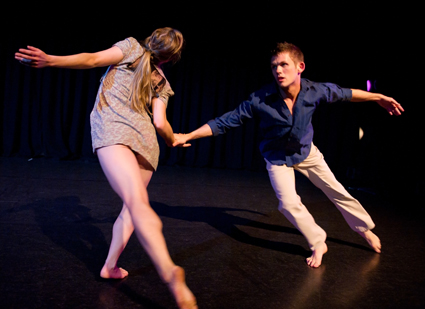
Anna Healey, Sean Marcs, Last Place to Go, 4Tell, youMove Company
photo Philippe Penel
Anna Healey, Sean Marcs, Last Place to Go, 4Tell, youMove Company
SEVEN BODIES FORM A CIRCLE ON THE FLOOR, CURLED UP, KNEES TO CHESTS, WHITE FLESH VISIBLE IN THE DARK. THEY BEGIN TO WRITHE: CRUNCH THEIR TORSOS TO PUSH HEADS UP TOWARDS THE CEILING. I HEAR THE BEGINNINGS OF AN AMBIENT WORLD MUSIC-SOUNDING TRACK. THE DANCERS ROLL AND SLIDE, PUSH THEMSELVES ACROSS THE TARKETT WITH THEIR ARMS. LEGS WORK HARD BENEATH UPPER BODIES. HEADS LICK AT THE CEILING. THIS DANCE IS FAST, ITS DANCERS AGILE.
Boundaries is the first work in 4Tell, a series of short pieces devised mainly by guest choreographers and performed by Kay Armstrong’s youMove Company. In the lead-up to the performance the company members have been encouraged to share their ideas and reflections with each other by contributing regularly to a blog. Throughout the show they each perform a short solo developed from one of their blog posts.
So, hot on the heels of Boundaries, company member Anna Healey performs a solo that breaks down the process of creating a blog post. Letters punched into a keyboard. Scrolls and clicks. Save draft. Preview. A post about the daily hopes and routines of an aspirational dancer.
Sandwiched between the dance works, the solos present 4Tell as the culmination of a mentoring process. They add an educational dimension to the evening. Most of them display an interest in process and are charged with a sense of self-revelation—this is us meeting the dancers on their own terms.
As the night progresses I begin to notice a consistent tone across the performances. Perhaps it’s because the same eight dancers perform in all of the pieces. I get to know them over the course of the evening, and by the final work, Multiplicity, I find I am looking out for familiar faces. But a certain quality is also recognisable across the group. There is control. There is muscle tone. And there is clear forward-thinking: these dancers always seem prepared for what is coming next.
In the second work, By Looking, a group of three moves in a tight spiral formation downstage. On their feet, the dancers sway in and out from one another, releasing tension and breath so far on the outward swing that I hold my own breath. But no one topples over. Later the dancers work in two pairs. There is body contact, the giving and taking of weight. Initially each exchange feels like a risk, but I soon stop expecting the dancers to fall. They may throw themselves around, but they know how to keep it together.
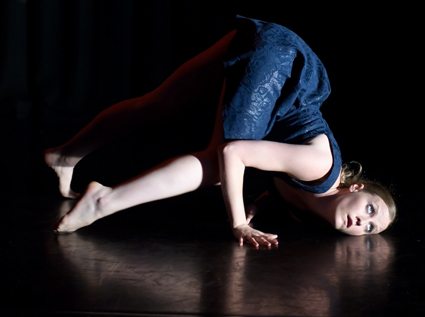
Angela French, 3rd Time Over
photo Philippe Penel
Angela French, 3rd Time Over
The only work choreographed by a youMove company member is a solo developed by Angela French with mentorship from Kay Armstrong and Force Majeure’s Kate Champion. French appears on stage in a navy blue dress, hair parted fiercely down the centre. The dress is tailored. A shimmer in the embroidery. There is music: a recorded string orchestra that plays a fast but steady course.
French’s hand floats about as though suspended on a string. Then it soars up over her head. Quickly her other hand flies up and pulls the first one down. The first hand continues with its exploration. I get the feeling that this dancer does not know what is coming next.
She traverses the stage. Halfway across, her legs give way beneath her. Again, it’s like she didn’t know it was coming, as if she actually lost all the strength in her lower body. On the floor she crawls, slaps a hand to the fleshy part of her arm and then to her thigh, pulling herself about. Up she gets, continues to travel—but her legs give way again. My stomach turns. Her hand floats up and she pulls it down; and again, and again. The pulling down starts to feel more like a slap on the wrist—like a self-correction.
I enjoy the rawness in this piece; the lean towards the irrational. Also, the way in which this dancer manages her body. It’s as if the dance happens to her, catches her off guard. And I enjoy the repetition. Sometimes there is such a range of content in choreography that I start to lose track, but this piece presents just a few things, thoroughly. All of this dawns on me gradually, as the evening progresses; as I take in the procession of shapes and ideas making their way across the stage.
youMove Company, 4Tell, curator, artistic director Kay Armstrong, guest mentor Kate Champion, company dancers Jay Bailey, Imogen Cranna, Angela French, Jayne McCann, Lauren McPhail, Melinda Tyquin, Anna Healey, mentee: Tracey Parker, guest dancer Sean Marcs, lighting Guy Harding, http://youmove.blog.com; www.youmovedance.com.au; Riverside Theatres, Parammatta, Sydney, Oct 27-29
RealTime issue #106 Dec-Jan 2011 pg. 28
© Cleo Mees; for permission to reproduce apply to realtime@realtimearts.net
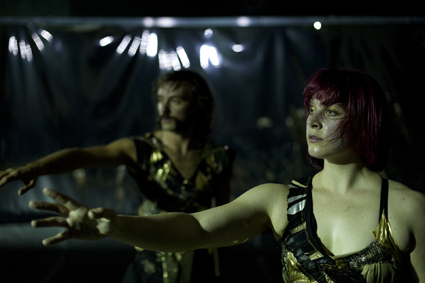
Luke George, Madeleine Krenek, Future Perfect
photo Rohan Young
Luke George, Madeleine Krenek, Future Perfect
“…RHYTHM IS A COMPULSION; IT ENGENDERS AN UNCONQUERABLE DESIRE TO YIELD, TO JOIN IN; NOT ONLY THE STRIDE OF THE FEET BUT ALSO THE SOUL ITSELF GIVES IN TO THE BEAT—PROBABLY ALSO, ONE INFERRED, THE SOULS OF THE GODS!” FRIEDRICH NIETZSCHE, THE GAY SCIENCE
Rhythm, according to Nietzsche, can summon the gods, mould the future or elicit emotion. Like art, rhythm fabricates. It creates a temporal pulse or logic. It also compels conformity. We want to fall in with the beat. Rhythm thereby seduces. It exerts the power of inclusion.
Future Perfect begins with a beat, found and repeated by all five performers. They dance as one, producing a jiggling, ‘Brownian’ motion, a suspension of particles, shaken not stirred, as they shift weight from one foot to the other. They are light on their feet as they rebound time and again. A world of repetition is created, a feeling captured and savoured.
Future Perfect trades in feelings. It is not about dance as such. Rather, it shimmers with dreamlike ambition, recalling the ancient world of the Titans, larger than life beings who view humanity from a mythical distance. The dancers are gilded in black and gold costumes, each one a variant upon the other. Phantasmagorical yes, but, like all the Greek gods, these creatures are not that different from mortals. Future Perfect vacillates between these two poles, god-like and human. It gestures towards an atmosphere beyond that which exists, yet visibly depends upon the physical labour of its dancers.
In the midst of the dancing, a series of virtual transformations (by Rhian Hinkley) is projected into the space. The film posits a set of images, each morphing into the next. Identities become blurred as one figure gives way to another. These shifts in imagery in turn have an impact on the watching of the work, changing the perceptible qualities of the dancing towards a more imaginary texture. Who these dancers are becomes less important than their collective enunciation, their patterns, implosions and explosions. They are seen as a whole, a human cluster forming, deforming then reforming. The movement-image (film) pushes the imagery of the movement (dancing) towards a sense of metamorphosis. I let go of my focus and watch the shadows, allowing the bodies to become otherwise.
Ultimately, this imaginary freedom is reined in. The work enters a dystopic phase, a fall from grace. Bodies are less harmonious, in conflict with one another. They fall, not by giving in to gravity, more through a sense of tragedy, as if they would be better off floating. The group is more fractured, individualistic, at odds with itself. Have the immortals gone the way of all humankind? Is death the worst life has to offer?
Future Perfect ends rather abruptly (unless I missed something) which is ironic really, given the work’s title. Perhaps I was lurking in the past while Future Perfect finished. In any case, I have the feeling that narrative development is not where this piece is at. Everything points to the creation of an atmosphere. The space is hung with curvilinear curtains that produce irregular reflections. The shimmering costumes, moving images, the planetary reorientations of the group conjoin to create an ambience. At times I was inside that ambience, suspended in its imaginary ether. At other times, the mood thinned and the magic evaporated.
The strength and power of Future Perfect is found at a distance, in the slow transformations of the group, in the ways in which, together, the group becomes bigger, more than human. That distance in turn enables perception to be freer, able to stray into the neighbourhood of the imaginary. If there is more to be told at the level of human aspiration, then perception needs to find a landing place closer to home. Therein lies the tension, between the god-like and the human, between the pathos of distance and the all too proximate earth.
Future Perfect, choreographer, director Jo Lloyd, performers Luke George, Rebecca Jensen, Madeleine Krenek, Shian Law, Lily Paskas, lighting & set designer Jennifer Hector, music Duane Morrison, costumes Doyle Barrow, projection design Rhian Hinkley, Trades Hall, Melbourne, Sept 14-18
RealTime issue #106 Dec-Jan 2011 pg. 28
© Philipa Rothfield; for permission to reproduce apply to realtime@realtimearts.net
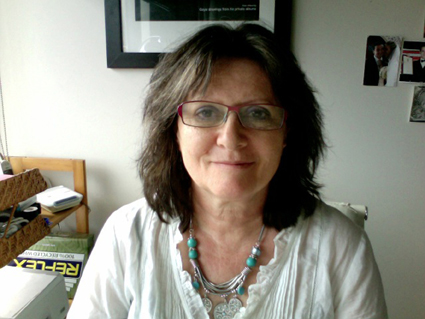
Kriszta Doczy, courtesy Artfilms
KRISZTA DOCZY IS THE FOUNDER OF CONTEMPORARY ARTS MEDIA WHICH PROVIDES, UNDER THE ARTFILMS BANNER, A SUBSTANTIAL CATALOGUE (4,000 FILMS) OF INTERNATIONAL ART ON DVD—DANCE, DESIGN, VISUAL ART, MUSIC, NEW MEDIA, THEATRE AND INDEPENDENT AND AVANT GARDE FILM—WITH A GROWING AND SIGNIFICANT AUSTRALIAN COMPONENT. THESE DVDS ARE INVALUABLE FOR TEACHERS AND STUDENTS OFFERING A SENSE OF ARTWORKS AND PERFORMANCES UNLIKELY TO BE EXPERIENCED FIRST-HAND, OR RARE EXPERIMENTAL FILMS TRANSFERRED EXPERTLY FROM 16MM.
Doczy’s most recent project has been the realisation of Australian Avant Garde, handsomely packed DVD sets of Sydney Underground Movies: Ubu Films, 1965-70 and The Experimental Films of Garry Shead (most made in the 60s and early 70s). You’ll be able to read more about this important act of cultural archiving in RealTime 107.
After years of email contact, Virginia Baxter and I finally met Melbourne-based Kriszta Doczy at the RealTime office in Sydney. Her enthusiasm is infectious, imbued with cheerful determination to bring more innovative Australian art into the international fold of her catalogue, encouraging individuals and companies to make their archival material available, producing and helping them shape the DVDs. We were curious about Doczy’s background and how she came to create Contemporary Arts Media.
At 17, in Communist Hungary, she wanted to be an actor and so joined a mime and dance company: “This was 1969. Everybody was fascinated with Marcel Marceau and the Lecoq style. We trained in contemporary mime but also acrobatics, dance, ballet, you name it, and acting. At the same time Grotowski was in Poland and we took our work to the same festivals. Our company, Domino, disappeared from the face of the Earth—we were banned by the Communist government, we were unemployed, we went underground. But we also toured a lot in Europe. Fifteen years of performing in experimental theatre! We played in cellars and basements, in parks. Then we started to do well so we were on television a lot. The government couldn’t prohibit us after a while. They just tolerated us. But we didn’t get any money. We were ‘starving artists’ but we worked, we had a school and it was buzzing.”
Feeling exhausted and disillusioned by the relentless pressures of theatre-making, Doczy, with her three-year-old first child left art behind her: “At 30 years of age I didn’t have a profession. I didn’t have an education except for high school. I was a single mother in a country where there was no support. So I got jobs in marketing because I spoke English and German. I met my second husband, a blues musician and mathematician, and we left Hungary. By then I was fed up with the entire system. I was 40-years-old when we left. I was pregnant and we spent a year in a refugee camp in Austria, which I could write an entire novel about…We very happily came to Australia. We were accepted on humanitarian grounds. We paid for our tickets and started from zero point absolutely.”
Doczy and family went to live in Perth and then Fremantle. The one thing she laments is never being able to secure a full-time job: “I wanted any sort of job, a normal job. My children were growing up and it was crucial. I wasn’t even thinking about theatre. That was so far away anyway. Conscious Living was a new age magazine, and they employed me in the 1990s using a numerology reading! And I had to sell advertisements. I redesigned the entire magazine. I was fascinated by computers, which came out at the time. We bought a computer and I started to work on it. Ever since I’ve done graphic design. I’m now designing lots of the materials and covers for Artfilms. It’s an endless playground.”
But Doczy was lured back into theatre, running workshops under the aegis of Spare Parts Puppet Theatre and then being offered residencies at Edith Cowan, Murdoch and Curtin Universities. “As bad as it sounds, I had to teach a lot of (traditional) mime. There was nobody teaching things like ‘the invisible wall’ and ‘walking against the wind’.” She decided to take her teaching skills to other cities, to universities in Melbourne, a private class in Sydney, “teaching experimental concepts of movement theatre.” She enjoyed the travel but continued to work in Perth “with performers like George Shevtsov and Stefan Karlsson. I put together a kind of theatre group (Shadow Industries) which did Mrozek’s Tango and an adaptation of Peter Carey’s story “Do You Love Me”—that was probably the best show I did.”
Next came a stint in New York where Doczy’s by then partner “was the Chair at City University of New York which employed me as an adjunct assistant professor teaching experimental theatre. That was a highlight. I was teaching and directing an adaptation of Kafka’s The Trial, a huge production. Big theatre. Big show. Big audience. Beautiful review. 10/10. We were invited to Korea as well: all 13 students, 20 people altogether. At that time I was at the peak of everything. I had a concept about what I wanted to teach—connect (to the body), control and communicate. I started to apply for full-time jobs in America and I was shortlisted a couple of times. And I almost got a job. Almost. But at the end I didn’t. Meanwhile, my children were in Australia and I had limited time. I came back and that was the time I looked into the mirror and I said ‘no more.’ I need a salary.”
So in 2000, Doczy made “three little films on how to teach mime, mask and mask making. My uncle and aunt did some of the work with me. I thought let’s see if I can develop this into a salary. I printed a brochure, secured new films on Commedia and some other teaching films within theatre studies and I sent it out. I had this little distribution company. In about half a year I had an annual salary.”
I wondered how Doczy sourced the films for her very global catalogue. She tells me, “I connected with the artists I knew. I found an international master in Commedia who was starving and I convinced him to make a film. This is my best-selling film ever. Then I met Peter Oyston (founding Dean of Drama at VCA) who became a good friend who helped with the Stanislavski stuff. Because I was teaching drama and also because I was teaching at the academy, I knew what I needed, what I had to show students so they knew what I was talking about—Grotowski, Kantor. With Kantor I found an institute that had the films and I started to correspond with them. At that stage I did nothing about the curriculum in Australia because every state has a different one. So I just thought I’d represent an international curriculum. So that was my approach. Who do I think important to teach? Getting the European material, nobody was doing it at the time. As soon as I started to put out these catalogues, there was a big response—“Oh god, how did you get this?” So that was very welcoming from the beginning. People loved the idea that they could get this material. Nowadays we do a lot of Australian work and I’m just so happy with that.”
Doczy finds most artists she deals with are “very open and very generous. I have their trust and we are so fussy about rights and agreements and all of that. Most have become friends during these years. Sometimes I’m sitting in my pyjamas in Melbourne talking to New York because we’ve set up an appointment with someone like (dance documentarian) Elliot Caplan and he’s in a New York café and he wants to switch on Skype! Obviously the internet is a big thing for us.”
Ironically, as Doczy was building Contemporary Arts Media, she found she still wanted to teach and approached the Head of Music Theatre at WAAPA in 2000. “I’d been teaching for one-and-a-half-years in New York with freelancing actors on the Lower East Side and at the university, [I said] I would really like to teach one unit one evening.” This teaching evolved from 20 students once a week to an entire class of first year acting students and in 2005 she was, at last, offered a full semester teaching job. “I had to say, I can’t. Ten years back I would have died for this job but now I’m running a company. It’s a beautiful company. I can’t wish for more than that. Too late!”
Nowadays, Doczy is based in Melbourne where Simon Rashleigh is Director of Marketing for Contemporary Arts Media, Doczy is Director of Acquisition and Product Development, while Josh Wickham does customer service and graphic designer Effie Shuie works from Taiwan. Doczy says, “We have Eszter in Budapest helping out with product development. And we have Alix Jackson as Production Manager and Editor doing lots of remastering. We have a web developer, filmmakers and others working for us. I’m working for a UK sister company that I’m establishing in London. It’s registered as Artfilms UK. It’s just started. We have a fairly good UK market.”
We return to the subject of the internet: “Our company is developing along with the internet,” says Doczy. “Five years ago there was no way that it would have been possible—multilevel price shopping trolleys for instance. If you go online from the UK, you see every price in pounds. We’re enabling certain discounts for certain countries. If you log in from Ethiopia, you immediately receive 70% discount. It’s a very sophisticated system. Protecting rights for instance: there are films that are available everywhere to us except Germany, France and Japan. Now we’re into an educational streaming system. Universities buy an educational subscription per module, like the Experimental Theatre module or Australian Cinema—different modules for x amount of films and everybody from that campus, the academics or the students, can access them.”
As with much else about the evolution of Contemporary Arts Media, the development of the company’s internet capacity grew from the ground up: “I wouldn’t have been able to establish this company at the time in 2000 if I hadn’t had a teenage son who learned the computer from me as he sat in my lap from age three. Then he was the IT, the website designer, database manager. He set up everything, the network and the system when he was 12 years old. He’s now outgrown us. He’s in London and working as a multimedia designer. My older son, with whom I ran away from theatre when he was three, received a PhD from the London School of Economics and is occasionally an advisor on business matters.”
I’m curious about the markets for Doczy’s catalogue; which is the biggest? “Half is Australia and the other half is between US and UK, mostly US. When we look at who is watching our website, 90% is from the US. The other interesting thing is that although we never really cared about private sales because that is like selling bread and butter—we couldn’t actually exist on it—an increasing number of individuals are buying from us with sales doubling each year. On YouTube we have a channel with one and a half million people watching the film clips. It’s a big playground but as you know from your own experience, it’s a lot of work.”
Kriszta Doczy reflects on her experience of Australia and the creation of Contemporary Media Arts: “My heart is totally Australian but these refugees who are coming from Africa and elsewhere are having a very hard time. We got a lot of help from the government when we came—a lot of help. Big baskets of food. A caseworker. My husband went immediately to a postgraduate course because he was a mathematician. Later I went to university and finished a psychology degree when I was 50-years-old. Australia is a wonderful country but there’s a certain limit. I didn’t get a job. But then I created a job and created work for lots of people—and I got lots of support for that.”
Contemporary Arts Media – Australia; www.artfilms.com.au; Artfilms Limited – United Kingdom, www.artfilms.co.uk
RealTime issue #106 Dec-Jan 2011 pg. 29
© Keith Gallasch; for permission to reproduce apply to realtime@realtimearts.net
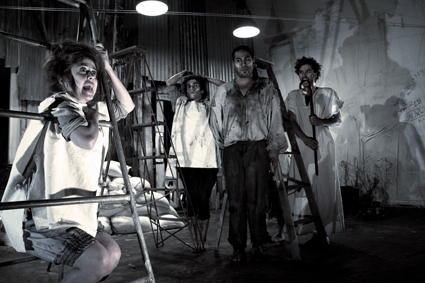
Peer Gynt, 2010, Four Larks Theatre
photo Zoe Spawton & Stephanie Butterworth
Peer Gynt, 2010, Four Larks Theatre
THE FIRST TIME YOU WITNESS A PRODUCTION BY FOUR LARKS THEATRE IS A LITTLE LIKE STUMBLING UPON A BRIGADOON-LIKE VILLAGE; ONE THAT HAS SOMEHOW EXISTED IN ISOLATION FROM THE MAINSTREAM YET HAS DEVELOPED A COMPLETE SET OF TRADITIONS, RITUALS AND AESTHETICS ON ITS OWN.
This ‘lost tribe’ atmosphere is a blessing and a curse—free from the anxiety of influence, the company has created works truly distinct from its peers, which can also suffer from infuriating flaws that could easily be remedied through broader collaboration. That’s why Four Larks’ recently announced residency at Malthouse Theatre is such an exciting prospect. In the past they’ve made striking theatre on the proverbial smell of an oily rag—with the input and resources Malthouse can provide, we may see the cross-fertilisation required for the next stage of this company’s growth.
The trio at the company’s core are Mat Diafos Sweeney, Jesse Rasmussen and Sebastian Peters-Lazaro. They met in California—Sweeney and Peters-Lazaro still hold US passports, while Rasmussen had travelled from Melbourne to study theatre at Berkeley. “We hung out in the Bay Area a little bit after school,” says Sweeney. “I met Jesse and started making some music together, then we fell in love and she sort of whisked me back to Melbourne. Then Bas came over a few months later to do our first show. We really started our theatre project in Melbourne.”
Each of the three takes on specific roles in the creation of their work. Sweeney and Rasmussen collaborate as writers and directors. Sweeney focuses on “the structural, dramaturgical and visual concepts” as well as “sequencing and scoring out the performance.” Rasmussen “is primarily responsible for the language itself, including lyrics both sung and spoken, and also works intimately with the actors on their individual trajectories.” Peters-Lazaro takes charge of all design components and “generating and realising moments of choreography.”
But in the early stages of each work’s development—the “dreaming period,” as Rasmussen puts it—these roles bleed into one another. “We develop all of the elements at the same time,” says Sweeney. “It’s not like we’ve ever had a script where we could show someone what it looks like just on paper. It’s about a visual concept in relation to a musical idea and really specific performers and location. None of the elements stand on their own, so they’re all being developed together.”
This extended period of preparation allows them to arrive at the rehearsal room as a united front, says Rasmussen. If asked, any one of the three could answer a question relating to a piece’s score, its costume concepts, the meaning of a line of text or the intention behind a moment of choreography. It helps that the trio live together and can hash out artistic arguments over the kitchen table rather than the heads of their performers.
This Cerberus-like creative partnership holds its own challenges for newcomers, says Peters-Lazaro: “at the start of a process it is confusing, especially for people who haven’t worked with us before, that there are three people who’re all shaping the work. But then by the end, just because of the scale we work in, we need all six of our arms.”
The scale of a Four Larks work is often its most astonishing aspect. Most feature dozens of actors and musicians; the design itself is consistently on a level of complexity unmatched by some of the country’s best-funded companies. In recent years the trio have begun describing their productions as “junkyard opera,” and the term is entirely apt. These are fully-fledged operas growing from the detritus of contemporary culture.
There’s another term that seems to encapsulate something of what Four Larks are about: folk. Not in the sense of the twee or naïve, though there may be some of that at times too. Rather, in a more thorough sense, the company’s various interests all seem driven by an obsession with communal narratives—folk music, folk tales, the very community they build by inviting so many artists to collaborate on each work. So far most of the company’s works have been adaptations of familiar stories (Orpheus, Peer Gynt, the myth of Undine) but, rather than attempting to locate the definitive version of each, it has been the overlapping of differing accounts that have fed the creative process.
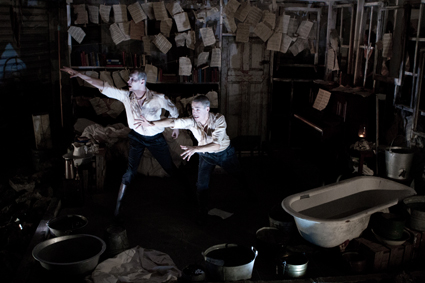
Ben Pfeiffer, Luke Jacka, Undine, Four Larks Theatre
photo Zoe Spawton & Stephanie Butterworth
Ben Pfeiffer, Luke Jacka, Undine, Four Larks Theatre
“The myths that reoccur,” says Peters-Lazaro. “In Undine, the idea that there’s some human creature-ish thing that comes from the water is something that comes up in multiple cultures throughout the world, so it’s interesting for us to look at something like that and explore why that is important. Even if it’s just by starting at a base with which everyone is familiar, we can talk about it in a more in-depth way without having to explain everything.” “We’re interested in talking about the why rather than the what or how,” says Sweeney. “We’re not necessarily interested in creating our own narrative, but in examining others and pulling them apart.”
This reappropriation is also what marks out every aspect of Four Larks’ design. Each set is meticulously constructed from discarded objects: “aesthetically, visually, it’s tied into the same conceptual element,” says Peters-Lazaro. “It’s using objects that have a history. It’s always an act of reappropriation. We’re interested in pretending and playing but no faking. The experience of the performance should be that everyone is hyper-aware that they’re playing at something.”
“It’s sort of an obsession with old things that have a resonance,” says Sweeney. “The set is not being built to look like something, it’s being built from things that are something being used for something else. Which is the same thing we’re trying to achieve with the performers as well, that they’re playing at something.”
In the Tower of the Malthouse next year the company will be tackling its latest object of folklore: The Plague Dances will address the many historical outbreaks of hysterical dancing which have struck communities from the medieval era onwards. “It’s not an adaptation but it’s definitely in the camp of material we’ve worked with before,” says Sweeney. “It’s an event that then gets immediately mythologised and co-opted by different groups, whether it’s the church or politically. It’s potentially a piece about this act of performance.” The residency will offer the company “a place to work in all the areas we’re excited to work, aesthetically and musically and conceptually, working with objects and building this elaborate, fake medieval kingdom.” With what Rasmussen calls their “little plague village up in the Tower” it seems as if the lost tribe is setting up camp in the heart of the capital.
Four Larks Theatre, The Plague Dances, writer Marcel Dorney, Tower Theatre, Malthouse, April 14-29, 2012. For the Malthouse 2012 Season go to www.malthousetheatre.com.au.
RealTime issue #106 Dec-Jan 2011 pg. 30
© John Bailey; for permission to reproduce apply to realtime@realtimearts.net
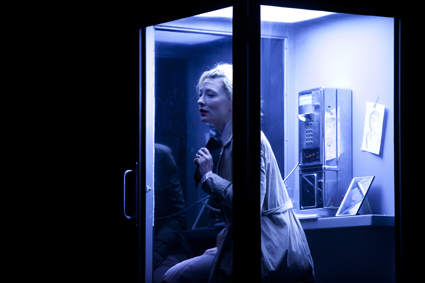
Cate Blanchett, Gross und Klein (Big and Small), Sydney Theatre Company
photo Lisa Tomasetti
Cate Blanchett, Gross und Klein (Big and Small), Sydney Theatre Company
TWO SIGNIFICANT WORKS FROM SYDNEY THEATRE COMPANY, BLOODLAND, A COLLABORATIVE PERFORMANCE CREATED BY AUSTRALIAN INDIGENOUS ARTISTS, AND BOTHO STRAUSS’ 1978 PLAY GROSS UND KLEIN (BIG AND SMALL) CONFIRMED THE COMPANY’S COMMITMENT TO ADVENTUROUS THEATRE-MAKING. BOTH WORKS CAST THE AUDIENCE IN THE ROLE OF OUTSIDER WHILE SIMULTANEOUSLY DEALING WITH THE OUTSIDER’S PLIGHT.
Neither work provides easy access—Bloodland is delivered largely in the Yolgnu tongue of Eastern Arnhem Land (without subtitles) in a discursive often movement-based narrative, while Gross und Klein elliptically tracks the emotional state of a woman whose life is falling apart in increasingly surreal episodes. Yet both works, once entered, reward us with insight into the outsider’s pain.
gross und klein (big and small)
In the opening scene of Gross und Klein, Cate Blanchett delivers the first volley of a tour de force performance, establishing Lotte as the outsider she is, the expansive dimensions of her personality and the potential for the trouble that will come—she is amiably garrulous (we are her confidantes), curious (she listens to two men talking “like total philosophers,” taken by their “throbbing” voices), betrayed (deserted by husband Paul), alone (with a tour group in Morocco who have turned on each other) and visionary (in an outburst about the fate of the Earth that takes her by surprise and anticipates later delirium).
With great vocal and physical ease, Blanchett sustains a remarkable sense of spontaneity and increasing unpredictability so that when Lotte trips into surreal scenarios, dances crazily or argues with God, we can go with her. We accept Lotte’s desire to learn languages, to think, to help, even though we know that the loss of love will repeatedly thwart any ambitions and that, perhaps, we are witnessing a descent into madness—although the world she encounters is possibly madder. Blanchett’s lucid delivery is underpinned by Botho Strauss’ austere writing, fortunately rendered not too idiomatically into English by Martin Crimp who refers to “the blue sky thing,” “nanotechnology” and their like to give the play a more contemporary feel. Crimp retains the play’s sense of foreignness, apt for Lotte’s condition and Strauss’ critique of a disintegrating society where this woman cannot secure a foothold. Blanchett captures perfectly Lotte’s desire to reach out—to an old friend and to perfect strangers (she talks through a window, advising a woman on how to dress; she takes a drunken Turkish man for a walk to sober him up; she visits her brother’s neurotic family; she takes on an office job)—but also to regress (returning to her and Paul’s apartment; attempting hopeless reconciliation; calling their old telephone number from a phone box in the middle of nowhere—an otherwise eerily naked stage).
What makes this production of Gross und Klein particularly disturbing is how painfully funny it is, giving the play’s consistent strangeness a through-line without ever straining to be comic, underlining the sheer happenstance of Lotte’s journey and allowing her to assume the mantle of a divine-ish fool. Having declared of humanity, “we’re not falling, we’re flying apart,” Lotte discards her dress to reveal a glittering showgirl outfit and confronts God: “Don’t come any closer! … I’m not your cup…I can’t take you on as well!” Bleeding and writhing on the floor, she wonders if he (God or Paul?) “wants to make me small.” We know Lotte is bigger than that. And the remaining scenes (a riotously hilarious office job with Blanchett reminding me of the physical bravery of Gena Rowlands in John Cassavettes’ film Love Streams (1984); an encounter with a chess-playing loner at a bus stop that might have become an unlikely relationship; and an apparently purposeless visit to a doctor’s waiting room) all suggest a return to some kind of stability if not normality alongside Lotte’s own asessment: “There’s nothing wrong with me.”
Benedict Andrews (who took over the production from French director Luc Bondy) has directed contemporary German plays here and in Berlin and is the perfect match for Botho Strauss (he has also directed three plays by Martin Crimp for STC). He has elicited consistently strong performances from his cast and worked inventively with Johannes Schultz’s set—a simply framed rectangle within which rooms can unfold or float apart or a strange apartment block glide into view, a highway appear with the laying down of white lines—a world if not “flying apart,” certainly aptly unstable. Gross und Klein is a must see—a great play, equally demanding and rewarding, and an immaculate production with an astonishing central performance that demands we step back and take a look at our lives through a new frame—to see just how sane or not are we and the society that tolerates us.
bloodland
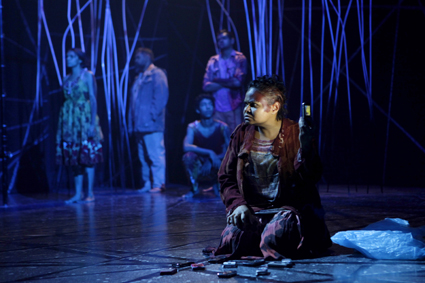
Bloodland, Sydney Theatre Company
photo Danielle Lyone
Bloodland, Sydney Theatre Company
Bloodland posits its non-indigenous audience as outsiders, witness to Indigenous language, ceremony and social tensions largely foreign to us. We have to work hard to find our way into the performance—much of the dialogue is delivered in Yolgnu, the language of the peoples of East Arnhem Land, especially in the early scenes where we’re heavily reliant on non-verbal cues. Later, Aboriginal English and a greater orientation to movement make meaning more transparent. But that initial sense of being an outsider is important, not that it ever leaves us—we are, as usual in the theatre, pretend voyeurs, but here moreso than usual. However, we are not the only outsiders—the clan society we observe has its own.
Cherish (Ursula Yovich), an eccentric loner who collects or most likely steals mobile phones she doesn’t use, mutters ritualistically over her cache the names of their owners. Billy (Kelton Pell) is city-educated, but denied involvement in ceremonies by clan elder Djurrpun (Banula Marika). Nonetheless Billy’s betrothal to young Gapu (Noeline Marika) stands, but it drives the boy who loves her, Runu (Hunter Page Lochard), into tragic isolation. Individual plights are amplified by tension between clans, by arguments between the women—as they make bread—over the obligations of sharing and exacerbated by the gap between learning ceremony and the appeal of hip hop and MP3 players for the teenagers. Added to which is collective despair over control of Indigenous land rights and language by a distant white government. Billy’s making and distribution of the hallucinogenic kava is another complication—its effects realised as a slow-motion tottering as opposed to the vitality and grace of the boys performing a kangaroo dance.
The set for Bloodland amplifies this prevailing sense of darkness and disconnection: a damaged wire fence spans the stage, cage-like, behind which, dimly discerned at first, is nature—evoked abstractly as grasses and spindly trees amidst which members of a clan stand and ominously watch or a dog (David Page) growls ferociously or a clan elder sings while carefully butchering a kangaroo. Near centre-stage, a power pole, sparking dangerously at its peak, leans perilously over land scarred by mining and a people caught between past and present. By the end, we have come to see both the Indigenous individual and their society as outsiders.
Bloodland is a significant if flawed creation, its theatre-cum-dance hybridity feeling at times unresolved, our sense of the key characters too impressionistic, its multiplicity of important issues spread thin in a short work. The crudely satirical scene of a teacher, Miss White, executing her students for declaring themselves Yolgnu ruptured a sense of Bloodland’s tonal consistency. Otherwise, the oscillation between easy-going naturalism and movement based ceremony worked well, although the protracted funeral at the end, for all its sense of ritual and powerful grieving, seemed disproportionate to what had gone before. But, I write as an outsider, witnessing Indigenous Australians made outsiders in their own land, enacting their plight in their own language and powerfully performing it.
Gross und Klein is programmed for the London 2012 Festival; Bloodland is in the programs of the 2012 Adelaide and Perth Festivals. You can see footage of Bloodland at www.sbs.com.au/news/video/2166576735/Bloodland
–
Gross und Klein (Big and Small), writer Botho Strauss, English text by Martin Crimp, director Benedict Andrews, performers Cate Blanchett, Lynette Curran, Anita Hegh, Belinda McClory, Josh McConville, Robert Menzies, Katrina Milosevoic, Yalin Ozucelik, Richard Piper, Richard Pyros, Sophie Ross, Chris Ryan, Christopher Stollery, Martin Vaughan, set designer Johannes Schultz, costumes Alice Babidge, lighting Nick Schlieper, composer, sound designer Max Lyandvert, Sydney Theatre, Nov 19-Dec 23; Sydney Theatre Company & Adelaide Festival: Bloodland, concept, direction Stephen Page, story Kathy Balangayngu Marika, Wayne Blair, writer Wayne Blair, performers Elaine Crombie, Rarriwuy Hick, Rimi Johnson page, Kathy Balangayngu Marika, Noelene Marika, Banula Marika, David Page, Hunter Page Lochard, Kelton Pell, Tessa Rose, Meyne Wyatt, Ursula Yovich, set Peter England, costumes Jennifer Irwin, lighting Damien Cooper, composer Steve Francis; Wharf 1, STC, Oct 7-Nov 13
RealTime issue #106 Dec-Jan 2011 pg. 32
© Keith Gallasch; for permission to reproduce apply to realtime@realtimearts.net
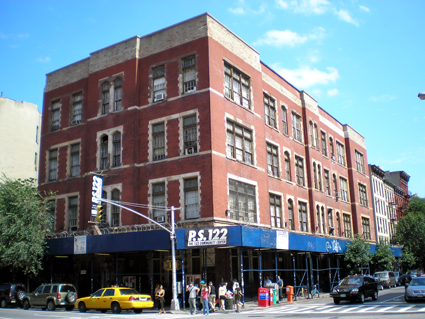
PS122, New York
DURING THE SPRING IN NEW YORK I WORKED IN THE PROGRAMMING OFFICE AT PERFORMANCE SPACE 122 (PS122). IT WAS A SIGNIFICANT AND HISTORICAL TIME FOR THE DOWNTOWN PERFORMANCE INSTITUTION AS IT WAS CELEBRATING ITS 30-YEAR HISTORY AND PREPARING TO CLOSE ITS CURRENT HOME FOR RENOVATIONS TO GO OFF SITE FOR THREE YEARS, FOLLOWING A MAJOR INFRASTRUCTURE GRANT FROM THE CITY OF NEW YORK.
PS122’s venue was once an old primary school in Manhattan’s East village. In the late 70s a community of artists started to inhabit the building and through the next three decades it quickly developed into the hub of the avant-garde downtown arts scene.
To say goodbye to the old building PS122’s artistic director, the Australian Vallejo Gantner, presented The RetroFutureSpective Festival, a two-week farewell party to celebrate the building’s considerable history, the community that shaped it and to introduce the radical shift into a new future for the performance art institution.
The RetroFutureSpective Festival was an exhaustive two week event. It included an All Day Dance Class—informal workshops with influential choreographers—followed by a night-time screening of the Alan Parker movie Fame which was shot on location at PS122 in the 80s. ECHO: 30 Years of PS122 was a three-channel video installation of archival footage by Charles Dennis; Avant-Garde-Arama Wrecking Ball, a two-night showcase of queer performance; while the culmination of the festival was The Old School 122 Benefit, a four-night mini-festival within the festival. The luminaries of the downtown performance scene from past and present were invited to perform back to back in this four-night marathon of short works—artists such as Penny Arcade, John Zorn, The Wooster Group, Eric Bogosian, Sonic Youth front man Thurston Moore, The Elevator Repair Service, all coming to pay their respects to the space that helped form their early careers.
The building was wrapped in nostalgia; the downstairs theatre was converted into a lounge hosted by Lori E Seid, a respected production manager. In one of our encounters she told me she was “the Dyke” in Penny Arcade’s seminal work, Bitch, Dyke, Fag Hag, Whore, which premiered at PS122 in 1990 (and toured to Australia). During the festival, artists such as Amanda Palmer popped in to sing some pre-show tunes at Lori’s Lounge.
A highlight of the festival was Charles Dennis’ ECHO. The artist edited 30 years of PS122 archival footage into a one hour 20-minute, three-channel video installation. Sitting through over an hour of performance footage from three decades of live works might sound like a serious chore for some, particularly when live works rarely translate well into film. However, Dennis’ ECHO is a remarkable installation that transforms the potential of the performance archive, creating a stand-alone work that was mesmerising to experience. This was partly due to the overwhelming collection of artists represented, but mostly to Dennis’ virtuosic editing and composition with each of the large screens simultaneously showing different footage. On one screen, an excerpt of experimental musician John Zorn improvising on violin becomes a soundscape for Spalding Gray’s monologue on the centre screen, while on the third, choreographer Sarah Michelson’s dancers appear to be moving to the erratic soundscapes created by Zorn and Gray. In another moment, retro footage of The Blue Man Group emerges, while images of Gray dissolve into the raps and melodic raves of Reggie Watts. ECHO holds these artists and their histories in the same time and space, in a wonderful evocation of the vision underpinning Gantner’s festival.
The art collective Praxis (Delia and Brainard Carey) presented a work from their conceptual museum MONA, The Museum of Non-visible Art. Praxis states that the museum “reminds us that we live in two worlds: the physical world of sight and the non-visible world of thought composed entirely of ideas; the Non-Visible Museum redefines the concept of what is real.” Each work sold from the museum has this disclaimer, “You are not buying a visible piece of art; you are buying the title and description card for the imagined artwork.”
At MONA artists are invited to collaborate and create conceptual works that exist in the imagination alone. Most famously NYC’s uber-man James Franco’s MONA contribution was recently purchased for $10,000 on the funding platform Kickstarter. For this festival, Praxis created a ghost tour, presented in a disused back room. Five audience members at a time would be guided through the imagined museum while Praxis described the imagined and real ghosts of PS122—such as Ethyl Eichelberger, Andy Warhol, Jack Smith, Spalding Gray and Charles Ludlum. Audience members could also purchase the works or ‘ghosts.’ The concept of MONA at this point is still developing: during the Ghost Tours Praxis struggled to bring their concept into the realm of live performance, falling short of engaging the audience in their imagined histories. However Praxis are only at the beginning of developing the infinite concept of MONA and I look forward to the future construction of their Museum of Non-visible Art.
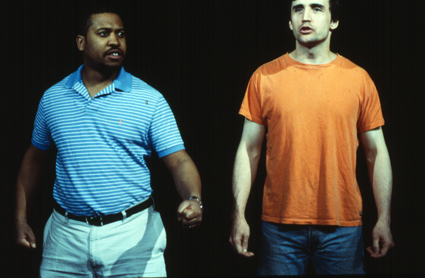
Pullman WA, Young Jean Lee Company
photo Dona Ann McAdams
Pullman WA, Young Jean Lee Company
Young Jean Lee Theatre Company is a stand out presence on the NYC performance scene. The artistic director of the company, Korean-born Young Jean Lee, was recently named by American Theatre magazine as one of the 25 artists who will shape American theatre over the next 25 years. As part of Retro, Lee presented an excerpt from her work Pullman, WA that premiered at PS122 in 2005. The title of the work refers to the town where Lee grew up, but instead of watching a linear presentation of personal anecdotes we experience a non-linear series of provocations about the confusions of day-to-day living. On a bare stage a man stands facing the audience, the house lights are up. He tells us that “he knows how to live” and proceeds with a subversive and provocative monologue that challenges our sense of self. The starkness and explicitly truthful nature of the text and presentation was completely original to me, and Pullman, WA provided me with one of those rare moments in the theatre where I felt somehow changed.
The final night became a four-hour epic, the house packed beyond capacity. The Wooster Group provided the last official work on the program, presenting the infamous Hula performed by a near naked Kate Valk. But the real finale was reserved for Phillip Glass who played a rendition of his work Closing.
The PS122 building is a space that many artists call home (I could not help but reflect on the old Performance Space venue on Cleveland Street in Sydney).The RetroFutureSpective Festival was overwhelming, heavily weighted with 20th century nostalgia that focused on honoring the incredible community and works that developed throughout the heyday of the formation of New York City’s avant garde.
As PS122 vacates, Gantner will be maintaining a balancing act over the next three to five years creating a program that exists across sites and venues throughout the city, with a vision of creating an engaged online social environment for PS122. The new development parallels the urban and social transformation of Manhattan, with the renovations being a positive and necessary step for the much loved but well-worn performance establishment. The next three years will be a challenge, an opportunity for Gantner and his strong team to create the future history of performance across New York City.
PS122, The RetroFutureSpective Festival, New York, June 11-25
See an excerpt of Charles Dennis 79 minute video work revisiting 30 years of archival performance footage from PS122
http://www.youtube.com/watch?v=daQAcuaOIFI
RealTime issue #106 Dec-Jan 2011 pg. 34
© Karen Therese; for permission to reproduce apply to realtime@realtimearts.net
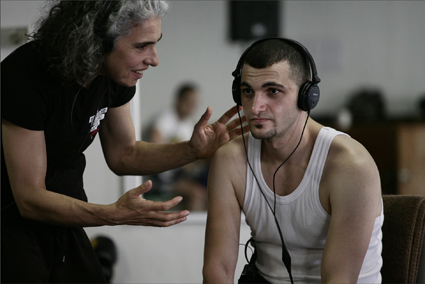
Katia Molino, Mohammed Ahmad, I’m Your Man, Roslyn Oades, Belvoir
photo Bill Reda, courtesy Sydney Festival
Katia Molino, Mohammed Ahmad, I’m Your Man, Roslyn Oades, Belvoir
The major theatre companies have launched their programs for 2012. Year by year these become more and more fascinating indicators of the expanding parameters of theatricality in mainstage programs (dance, contemporary performance, puppetry, opera, physical theatre, Indigenous performance) and the collaborative interplay between companies, not merely cost sharing but exploratory, nor a closed circuit as large companies take on board the likes of Hayloft, version 1.0, My Darling Patricia, Urban Theatre Projects, Circa, Ilbijerri, Four Larks Theatre, The Black Lung Theatre, Post and others. While plays are still central to theatre company programs they have become part of the broader ambit of performance involving an expanded range of authorship. The following overview of 2012 programs will give you some idea of the extended range of performance and the interconnectedness that has come with a new generation of artistic directors.
belvoir
With the Sydney Festival Belvoir premieres Urban Theatre Projects’ Buried City, written by Raimondo Cortese. It’s about immigration, development and who controls the future and made in consultation with the Construction, Forestry, Mining and Energy Union (CFMEU) and their Retired Members Association, African Women Australia Inc and Gadigal Information Service Aboriginal Corporation. Also for the festival, Belvoir with CarriageWorks presents a version of Seneca’s Thyestes (a deposed king who unknowingly eats his sons) originally commissioned from Melbourne’s The Hayloft Project by Malthouse Theatre and directed by Belvoir’s Simon Stone. Another festival work is I’m Your Man, created and directed by Roslyn Oades (Stories of Love and Hate) which recreates verbatim the journey of an ambitious young Bankstown boxer on his way to a world title fight.
Also in the 2012 program there’s a version of Euripides’ Medea told, a la Rosencrantz and Guildenstern are Dead, from the point of view of the minor characters. Director Anne-Louise Sarks is the artistic director of Hayloft; co-writer is Kate Mulvany. Belvoir, version 1.0 and Ilbijerri Theatre Company unite for Beautiful One Day, created by Paul Dwyer, Eamon Flack, Rachael Maza and David Williams. This “theatrical documentary” focuses on troubled Palm Island, exploring similar territory to Chloe Hooper’s book and Tony Krawitz’s documentary, both titled The Tall Man, but with a very different approach. Leah Purcell will direct Don’t Take Your Love to Town, created with Belvoir’s Eamon Flack and based on the late Ruby Langford Ginibi’s book of the same name.
Simon Stone with actress Emily Barclay tackles a true rarity, Eugene O’Neill’s Strange Interlude; actor Matthew Whittet’s play Old Man, about fathers and sons and Newtown, is premiered; Colin Friels and Genevieve Lemon star in Arthur Miller’s Death of a Salesman, directed by Stone. Belvoir’s Artistic Director Ralph Myers makes his directorial debut with Noel Coward’s Private Lives—that most sleek of 20th century comedies—with Eloise Mignon and Toby Schmitz in the lead roles. As John Lahr wrote in Coward the Playwright (1982): “Minimal as an art deco curve, Private Lives’ form matched its content; a plotless play for purposeless people”—and no less enjoyable for it.
With three actors and three dancers, choreographer and director Lucy Guerin has been commissioned by Belvoir to create Conversation Piece with Alison Bell, Megan Holloway, Alisdair Macindoe, Rennie McDougall, Harriet Ritchie and Matthew Whittet: “A group of actors and dancers meet on stage and begin the show with a short conversation about…Well, we don’t know yet. Each night it will be a different conversation” and this will “form the basis” of the performance. Actress Rita Kalnejais has written Babyteeth to be directed by Eamon Flack; another actor turned writer, Steve Rodgers, will have his play, Food, about a pair of feuding sisters, directed by Force Majeure’s Kate Champion. Benedict Andrews will direct his own play, Every Breath, about a threatened family who hire a security guard they are each attracted to (a hint of Pasolini’s Teorama?).
sydney theatre company
For the Sydney and Adelaide Festivals, STC presents Force Majeure’s dance theatre creation Never Did Me Any Harm, directed by Kate Champion, inspired by, although not based on, Christos Tsolkias’ The Slap and featuring a strong cast of actors and dancers that includes Heather Mitchell, Marta Dusseldorp, Kristina Chan and Kirstie McCracken.
Griffin’s Sam Strong will direct Hugo Weaving and Pamela Rabe in Christopher Hampton’s fine version of Choderlos de Laclos’ 1782 novel Les Liaisons Dangereuses, a complex tale of sexual intrigue. Co-artistic director Andrew Upton will direct Dylan Thomas’ intensely poetic, nostalgic and bittersweet Under Milk Wood with a cast that includes Jack Thompson and Sandy Gore. Upton and Belvoir’s Simon Stone have boldly adapted Ingmar Bergman’s journey into despair, Face to Face, for the stage with Stone directing the always impressive Kerry Fox, Wendy Hughes and John Gaden.
The Splinter, by Hilary Bell and directed by Sarah Goodes is described as “an emotional thriller.” An abducted child is returned to her parents (Erik Thomson and Helen Thomson), but is she theirs? The intriguing thing about The Splinter is that the child will be represented by a puppet. Alice Osborne is the puppetry and movement director. Bell is apparently “inspired by the Henry James novel The Turn of the Screw, the Hans Christian Andersen tale The Snow Queen and real life stories of abducted children.”
Melbourne’s Daniel Schlusser will direct Thomas Bernhard’s The Histrionic featuring Bille Brown (see Malthouse below) and Peter Evans will take on George Bernard Shaw’s Pygmalion with Kym Gyngell and Andrea Demetriades.
Perth’s Black Swan and STC will stage novelist-turned-playwright Tim Winton’s second play, Signs of Life: a lone woman on a farm, “contemplating her solitude”, is visited by strangers—an Aboriginal man and woman. Kate Cherry directs. Also in the 2012 STC program is Jonathan Biggins’ Australia Day, a timely satire given the increasing cultural complexity of our nation.
malthouse
Belvoir’s impressive adaptation by Simon Stone and Chris Ryan of Ibsen’s The Wild Duck (RT102) kicks off Malthouse’s 2012 program. In a co-production with Sydney Theatre Company, Daniel Schlusser will direct Tom Wright’s translation of Thomas Bernhard’s The Histrionic (Der Theatermacher), described as a “rampage of satire on art, celebrity and the cult of personality” featuring Bille Brown as the egotist under scrutiny. Artistic director Marion Potts will take on Lorca’s Blood Wedding with music by Tim Rogers. With Perth Theatre Company, Malthouse will present On the Misconception of Oedipus, forensic theatre devised by Zoe Atkinson, Matthew Lutton (also directing) and Tom Wright that imagines the back story of the tragedy of Oedipus.
Resident company, Four LarksTheatre (see article), will create The Plague Dances, about massive, manic outbreaks of dancing across the centuries. From Brisbane, via the world, comes the physical theatre company Circa with their stripped back, highly intelligent circus. It’s good to see Indigenous choreographer Vicki Van Hout’s Briwyant in the program; as I wrote in RT103: “Vicki Van Hout’s choreography is some of the most idiosyncratic and inventive choreography seen in Australian dance for a long time and her team of dextrous dancers execute it with high precision, unbelievable energy, humour and attitude.”
Malthouse’s Opera XS features Chamber Made Opera partnering Rawcus in an improvisation based on the music of Henry Purcell; Short Black Opera Company’s Redfern; and Victoria Opera’s Victoria Shorts. Paul Capsis performs his autobiographical Angela’s Kitchen (see Griffin Theatre Company below); Jane Montgomery Griffiths, directed by Marion Potts performs the late Dorothy Porter’s verse novel Wild Surmise; Matthew Lutton directs Declan Greene’s apocalyptic take on LA culture; and Rosemary Myers directs Julianne O’Brien’s contemporary update of Pinocchio “as witty, gothic, rocking music theatre,” in a co-production with Windmill and the State Theatre Company of South Australia.
griffin theatre company
For the Sydney Festival, Griffin begins its year with Gordon Graham’s 1991 deeply disturbing classic about family, masculinity and murder, The Boys (later adapted by Stephen Sewell for Rowan Woods’ 1998 film), celebrating the play’s successful premiere at The Stables Theatre 21 years ago. Griffin’s artistic director Sam Strong will direct The Boys which will also play in the 2012 Merrigong Theatre season in Wollongong. The Story of Mary MacLane by Herself is adapted by Bojana Novakovic, from a century-old confessional work from a 19-year-old that scandalised American readers and sold copiously: “I should like a new man to come. A perfect villain to come and fascinate me. And I should ask him quite humbly to lead me to my ruin.” Novakovic and director Tanya Goldberg (Ride On Theatre) will stage MacLane’s provocative writing as a “monologue for two” with music by Tim Rogers. The production is presented in association with Malthouse Theatre, Merrigong Theatre Company and Performing Lines.
Paul Capsis’ Angela’s Kitchen, directed by Julian Meyrick and with Hilary Bell as associate writer, is singer Capsis’ autobiographical celebration of his mother, taking him back to Malta which she left in 1948 with five children to live in Sydney’s Surry Hills. This return season of a hit for Griffin in 2010 is a prelude to a tour to Canberra, Albury, Wollongong, Parramatta, Melbourne and Brisbane.
Playwright Rick Viede enjoyed success at Griffin with his first play, Whore, which won the 2008 Griffin Award and the 2010 Queensland Premier’s Literary Award. His new play, a co-production with Brisbane’s La Boite, is A Hoax, “a vicious satire on the politics of identity, modern celebrity and the peddling of abuse culture.” Ian Meadows’ Between Two Waves is one of a small number of plays that addresses environmental issues, focused here on prediction and responsibility: how can we live and procreate when it’s likely that coming generations will suffer from our neglect. Between Two Waves is the first play to be produced out of the Griffin Studio.
queensland theatre company
Wesley Enoch’s first season as artistic director of the QTC includes Belvoir’s acclaimed Neil Armfield production of The Summer of the Seventeenth Doll; Jennifer Flowers directing Shakespeare’s Romeo and Juliet; Brisbane playwright Matthew Ryan’s Kelly, an account of Ned in his cell visited by brother Dan who is unexpectedly still alive; and the Sydney Theatre Company’s Bloodland (see article).
Enoch is directing four productions: Joanna Murray-Smith’s Bombshells, starring Christen O’Leary; Dario Fo’s Elizabeth, Almost by Chance a Woman, with Carol Burns; Sydney writer Alana Valentine’s Head Full of Love (Darwin Festival commission 2010) about the encounter between a Sydney runaway (Collette Mann) and an Alice Springs local, Napuljari (Roxanne McDonald), in the context of the Annual Alice Springs Beanie Festival; and David Williamson’s Managing Carmen about a cross-dressing footballer at the peak of his career who risks being outed.
zoe coombes marr wins award
Congratulations to writer-performer Zoe Coombs Marr (one of the talented trio comprising Post) who has won the 2011 Philip Parsons Young Playwrights’ Award for her one-woman show, And That Was the Summer That Changed My Life which premiered at Next Wave Festival in 2010. The Award is given annually to a NSW-based writer under the age of 35 for an outstanding work which has been performed. The award comes in the form of a writer’s commission supported by Belvoir to develop a new work.
RealTime issue #106 Dec-Jan 2011 pg. 35
© Keith Gallasch; for permission to reproduce apply to realtime@realtimearts.net
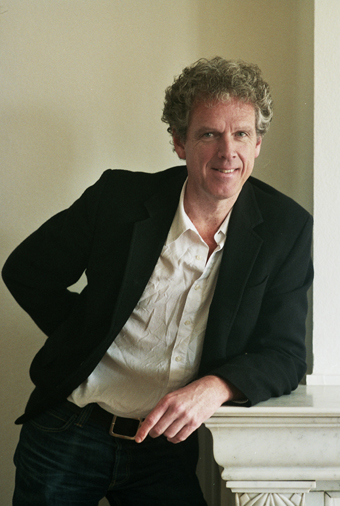
Alain Platel
photo Chris Van der Burght
Alain Platel
FOR SOMEONE WHO IS RECOGNISED AS ONE OF THE GREAT EUROPEAN THEATRE PROVOCATEURS OF THE LAST 20 YEARS, HAILED FOR PRODUCTIONS THAT SHOW EVERYDAY LIFE IN ALL ITS IMPERFECTION AND FRAGILITY, BELGIAN CHOREOGRAPHER ALAIN PLATEL APPEARS SURPRISINGLY MILD-MANNERED AND SERENE IN CONVERSATION. SOFT-SPOKEN YET ARMED WITH THE MISCHIEVOUS SMILE OF A TEENAGER, HE EXUDES THE AIR OF A MAN WHO, AT 55, HAS NEVER STOPPED ASKING QUESTIONS, NOT LEAST ABOUT HIS ROLE IN THE SCHEME OF THINGS.
In Australia to present his Les Ballets C de la B work, Out of Context—for Pina at Sydney Opera House’s Spring Dance and Brisbane Festival, Platel is pleased to discover that at the former the piece is accompanied by a series of films and talks celebrating the life and work of legendary choreographer Pina Bausch—a fitting context for his work. The idea for Out of Context came to Platel when returning to Belgium after a commemorative service for Bausch in Wuppertal. He wanted to give her a “present.” Platel says: “Ever since I met Pina at the end of the 90s, she no longer was only this famous choreographer but also became an extremely important human being in my life, somebody I was very inspired by.” Citing her work Café Müller (1978) as one of the dance pieces that changed his life, Platel credits Bausch with influencing the way he watches theatre: “I think what she did for me was to intensify my looking at things…to enjoy looking at people.”
It is interesting to note that like Bausch, Platel did not set out to explore an existing performance language but developed a style of his own by pursuing a line of inquiry that originated in asking questions he was personally interested in. Originally, he trained as a remedial educationalist working with children with motor and multiple disabilities. Founding the Ghent-based theatre collective les ballets C de la B in 1984, Platel describes himself as an autodidact director and a reluctant one at that. It took him five years, he admits, before changing jobs and starting to call himself a professional theatre maker: “In the first few years, we didn’t have the ambition to become big stars or tour the world. We were just having fun. Our first performances, you know, we performed only four or five times in front of about 400 people. And that was a lot for us at the time.”
However, Platel’s exuberant productions, with their eclectic casts of professional and non-professional performers from culturally and socially diverse backgrounds, wildly mixing high and lowbrow cultural references, soon captured the imagination of audiences throughout Belgium. The international breakthrough followed in the mid-90s and resulted in extensive, worldwide touring of shows such as La Tristeza Complice (1995) and Iets Op Bach (1998). Platel insists that the driving force behind those large-scale, multi-cast works was his interest in finding out how to communicate politically and philosophically complex themes on stage. This motivation has sometimes been misunderstood, much to Platel’s disappointment: “It makes me sad when I get asked, ‘do you really want to shock people?’ Because I don’t think I have ever had any intention to shock or provoke. To confront audiences with difficult images to look at, yes, but when I show images that are difficult to cope with it’s because I don’t know how to cope with them myself. And I want to share that. I think the theatre is the place where you can do this. Much more than in any other place.”
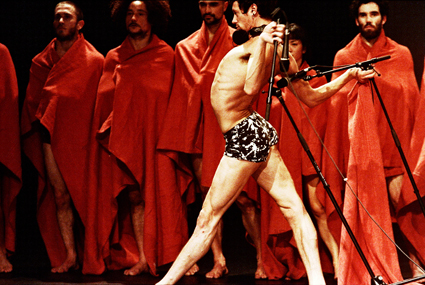
Out of Context-For Pina, Les Ballets C de la B
photo Chris Van der Burght
Out of Context-For Pina, Les Ballets C de la B
After several years of international success, Platel found the pressure to live up to the reputation and hype surrounding Les Ballets C de la B increasingly difficult. His announcement in 1999 that he would stop making work sent shockwaves through the European theatre scene. He reflects, “I must say I was surprised that people took it so dramatically seriously.” Laughing, he adds, “I shouldn’t have told anybody. But I was really thinking at the time, can I do something else besides making theatre? Should I continue to do this for the rest of my life? I just couldn’t cope any longer with the pressure that was around me in terms of making each year a new success.’’
In the end, his break from theatre-making only lasted a little more than two years before returning to the fold. For Platel, however, it was a significant period, from which he emerged with new-found clarity. “It helped me redefine my position and reflect on how to continue. I now cope better with the whole ‘business.’ I think I take it a little bit less seriously. The pressure is still there but in another way. I am not taken by it. I don’t feel the need to make new work all the time any more. That is a nice thing to realise.” His time away from the theatre also spawned a new approach to choosing the next project, Platel explains: “Now when I decide to do things, it’s a gut feeling, like I have to do it. I want to make it a life experience, not just something along the lines of ‘let’s do a project together’.”
So, with Les Ballets C de la B celebrating its 25th anniversary this year, how has Platel’s view of the role of theatre in society changed over the years? He concedes, “Maybe there was a moment once where I thought we were going to conquer the world and make a difference but I very quickly realised that this was too big a mission.” He laughs. “I read in the paper one day that only 1% of the Belgian population goes to see theatre. So I think it’s pretty difficult to change the world by making performances.” Fair enough. But still, when talking to Platel one can’t shake the feeling he hasn’t given up on the transformative power of theatre altogether: “I have feedback from many people who have witnessed our performances and you feel that a performance can continue to live in someone’s life for a very long time. That is quite surprising. And sometimes, so people tell me, it has an effect on how they live their lives. That is really something.”
Platel admits to often being touched by audience reactions and drawing inspiration from them: “We showed Out of Context in Taipei this year and we performed in this huge theatre, 1500 seats. On the day of the first performance I was walking around the city and thinking, who on earth in this city would think about coming to the theatre tonight to see a performance by Alain Platel. Who the hell is Alain Platel? There are so many things in this city that one can do in the evening. But then the theatre was completely full, on both nights. And not only that but the people really liked the show and were very expressive about it. I had never been there in my life. And this is something that makes me very emotional.” Considering that Alain Platel is so often associated with shocking audiences, his next remark is not without irony: “Thinking back to how we started out and how I didn’t know anything about making theatre, a story like this is really shocking to me. Absolutely shocking.”
Les Ballets C de la B’s Out of Context—for Pina appeared in Spring Dance 2011, Sydney Opera House where he also spoke and conducted a masterclass. See reviews in RT105 and RT98.
RealTime issue #106 Dec-Jan 2011 pg. 26
© Martin del Amo; for permission to reproduce apply to realtime@realtimearts.net
EIGHTEEN SINGERS SIT ON THEIR KNEES IN FOUR CIRCLES, HEADS TOUCHING THE GROUND. THE GROUPS ARE COLOUR-CODED BLUE, RED, YELLOW AND GREEN, COMPLETE WITH TOUCHES OF FACE PAINT. AT THE BACK OF THE STAGE A MARIMBA PLAYER DRESSED IN BLACK BEGINS AN ARPEGGIATED CHORD PROGRESSION. A VIBRAPHONE PLAYER JOINS IN WITH A LILTING MELODY. THE SINGERS BEGIN A SIGHING HARMONY, MUFFLED BY THE FLOOR.
As the vocal intrusion grows louder the singers lift their heads, increasing the clarity of the sparkling, close chords. The song fills the room as the choristers break away from their groupings. Words are heard: “Now we are alone when we are together.”
Already the stakes of Gian Slater’s Us & Others are evident. The four groups of mixed voices break with standard groupings, shifting the focus away from gendered tone colour to extended vocal timbres. Instead of singing at us in a line, the singers move about the space producing surround-sound effects. The text warns us not to take the “togetherness” (to use Percy Grainger’s way of putting it) suggested by harmony for granted, but to consider the loneliness in paradise.
By combining voices of different types on the same line, Slater is able to produce a homogeneous, almost synthesised texture. The layering of the parts in lush jazz-inspired chord progressions almost sounds like one person singing over themselves. If Slater’s grouping did not smooth out the timbral profile of the choir then the vocal talent of the singers did, each performer thoroughly owning his or her individual part.
Unencumbered by timbral differentiation, the ear was free to enjoy the singers’ movement around the space in lines and groups. After the blossoming sound world of the opening the choreography was more subdued. Hand gestures would muffle voices or swaying would bring out certain harmonies over others. The concert concluded with a return to facing the floor, this time in one large group with performers each ‘wibbling’ their tongues (making a small ‘o’ with the lips, vocalising and passing the tongue quickly back and forth over the opening). The sonic effects of Slater’s spatialisations were particularly evident in the middle of the front row, though some found that the effect was lost further back.
It was unusual to see Speak Percussion accompanying the Invenio Singers from the back of the stage, though each performer was given the chance to exhibit their prowess in small improvisatory numbers performed by the four colour groups. At one point, four singers sit in a circle cooing “nininini” at different speeds, giving the sense of balls bouncing to a stop or springing to life while Matthias Schack-Arnott plays bowls on a snare drum, tuning the snare to coax a pulsing rattle from the interference of the vessels. At another point an ode to solitude and freedom in the middle of a field is sung to Dan Richardson’s accompaniment of dried beans sizzling and spinning around an upturned ride cymbal. Eugene Ughetti expertly handles a foot pump during a chorus of breaths and Peter Neville rocks a talking drum amid a group scat. At all times there was a feeling of freedom within restraint as each individual navigated the sound palette carefully chosen by Slater to give the sense of micro-cultures surviving within larger social units.
There is a book to be written about the relationship between musical texture (the arrangement of simultaneous voices) and social organisation. With the performers standing side by side and singing through megaphones at the audience, Slater raises the criticism that despite technological synchronicity we are otherwise isolated from each other. From then on the diagnosis is fairly positive: happy little groups improvising before joining together for choreographed moments of harmonic splendour. It was more an exploration of musical ensemble than social togetherness. The question remains: why are musical metaphors for social organisation interesting? What can they tell us that we could not have known otherwise?
Perhaps the connection between music and society is not to be found in their formal similarity, but in their technological links to each other. Slater is not just a conductor-composer but a composer-sound engineer, using real breath and meat to produce tape-era special effects. Or perhaps even effects of the digital age. Is not the layering of semi-improvised voices a product of today’s cheap and accessible recording equipment? The technology that gave rise to Björk’s Medulla and Camille’s Le Fil? If so, then Us & Others, with its focus on the physicality of music-making, is a work of togetherness-making, the establishment of a community of enjoyment that encompasses not only 18 incredibly talented singers and four virtuosic percussionists, but the audience that leaves humming their tunes.
Us & Others, composer, director Gian Slater, performers Invenio Singers, Speak Percussion, Malthouse, Melbourne, Sept 9
RealTime issue #106 Dec-Jan 2011 pg. 41
© Matthew Lorenzon; for permission to reproduce apply to realtime@realtimearts.net
With due respect to Jon Dale (whose writing we’ve enjoyed and valued over the years) his RT105 Overground article ‘combinatorial challenges’ (p40) is pretty unfortunate, more a rant than review. Jon caricatures the Overground curatorial process and skews an important discussion to support some inchoate conclusions.
That the broad negativity of ‘combinatorial challenges’ also extends to ignoring 80 of Overground’s more than 100 performers with a line as pithy as “The remaining hours of Overground, sadly, offered little of merit” is to put it mildly, a major bummer for both participants and readers, and ultimately, a sloppy way of blanking what was in fact the vast majority of the event.
Regardless of the personal impression made by specific artists (and there have been plenty of divergent opinions on each act), the characterization of the combinatorial process as “unguided, ‘pick-a-name-out-of-the-hat’” is spurious, meant to sting, rather than provide reasonable critique. The ‘new collaborations’ approach established at Overground 2010 (with clear historical precedent spanning events from Derek Bailey’s ‘Company’ (1976-1994) to Sydney’s NOW now) was generated thoughtfully in iterations, through ongoing discussion between the curators, and with participating artists, who were largely thrilled, or at least curious and challenged by the propositions. Tony Conrad’s duet with Chris Abrahams, described in the article as a “dumb mathematical equation” came about at Conrad’s suggestion (as a long time admirer of Abrahams work) and was described by Abrahams as a “massive honour and challenge.” We reject Jon’s portrayal of the curatorial process at Overground.
The discussion around ‘roamers’ and ‘intervention’ is more complex and highlights real and interesting tensions. ‘Roamers’ were invited to activate ‘unofficial’ spaces within Melbourne Town Hall, outside the bounds of the formal schedule. There were also specific restrictions, principally to avoid direct disruption of the other acts, especially very quiet ensembles. Managing the dynamic between roaming and scheduled artists is obviously difficult, it’s a nuanced situation requiring sensitivity from everyone. The arrangement was navigated brilliantly without regulation by about 20 disparate performers on the day. However, when ‘roamer’ Kusum Normoyle, crossing the “invisible psychic line,” as Jon excitedly put it, unexpectedly blasted harsh noise into the space of a particularly quiet group halfway through a set watched by about 300 people in the main hall, it was pretty obvious there’d be reaction, in this case an attempt to protect the less robust work from being destroyed. The decision to halt Kusum’s performance was made on principal, intuitively, in response to her own ‘switching off’ of another work, intentional or not. It felt justified at the time, and in effect fitting to the kamikaze-like logic of her own interventionist action. There are legitimate questions that come out of this event (we’d be interested to know what Jon is essentially advocating, where his “psychic line” is) but the characterisation of a repressive “official festival culture” bent on silencing the “feverish creativity of the underground” is facetious. It also ignores the fact that the Overground organisers are all active participants in that very underground.
Joel Stern
Overground Co-curator
Email Nov 30, 2011
RealTime issue #106 Dec-Jan 2011 pg. 41
© Joel Stern; for permission to reproduce apply to realtime@realtimearts.net
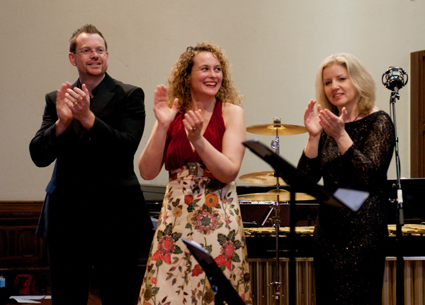
Jamie Adam, Gabriella Smart, Elizabeth Layton, Soundstream Collective Inaugural Concert
photo courtesy the artists
Jamie Adam, Gabriella Smart, Elizabeth Layton, Soundstream Collective Inaugural Concert
“MUSIC IS A SPIRITUAL REFLECTION OF SOCIETY, AND NEW MUSIC ITS NEXUS. THE ENGAGEMENT OF AUDIENCES AND EDUCATION ARE BUT SIMPLE TERMS TO DESCRIBE THE DEVELOPMENT OF A VIBRANT CULTURE OF EXPLORATION, INSPIRATION AND COMMUNICATION THROUGH THE ARTS” (GABRIELLA SMART, 2011 CHURCHILL FELLOWSHIP REPORT).
Gabriella Smart is a pianist, festival director, teacher and entrepreneur and she has a clear philosophy. For over 20 years, she has championed new music, making a unique and significant contribution to the music scene nationally and internationally.
Smart’s oeuvre is the piano. “My discipline as a musician comes from complete devotion to the instrument,” she says. She credits her teacher, Russian-born and trained pianist Eleonora Sivan, with helping her find that devotion and discipline. “Eleonora provided the key to absolute love, not just the physicality of the instrument but the philosophy of classical music. That foundation makes new music exciting. There is a feeling of emancipation through new music.” She feels a constant urge to practice and perform, and not only perform but communicate. “New music is very complex but it is failing society if it is not out there.”
soundstream new music festival
Smart founded the Soundstream New Music Festival in 2008 to elevate the profile of new music in South Australia. She has always emphasised excellence in programming, production and performance and this approach won the 2009 Soundstream Festival a Ruby Award for Best Event in South Australia. (Reviews of the 2009 and 2010 festivals can be found in RT93, p49 and RT99, p50.)
The 2012 Soundstream Festival—it’s now biennial—will be different in scope and intention, emphasising connection with youth and community. Smart says that it will be aimed at music with strong community support. “The theme of the 2012 Festival is Intersection, a celebration of new music through community.”
soundstream collective
The Soundstream Collective was established in 2011 as an ensemble in residence based at the Elder Conservatorium, University of Adelaide, which will provide essential infrastructure and support. As the Soundstream Collective’s artistic director, Smart’s intention is to maintain a dedicated group of musicians able to perform regularly and at the highest level. The collective will collaborate with other musicians, commission new works, research new music and extend Adelaide and Australia’s new music culture. Its ongoing nature will obviate the difficulties of establishing ensembles anew for each Soundstream event.
The Soundstream Collective’s launch concert was at Elder Hall, University of Adelaide, opening with Steve Reich’s Clapping Music (1972) and followed by the premiere of Brisbane-based composer Erik Griswold’s exquisite a leaf falls (2011) for cello (John Addison) and percussion (Vortex Ensemble). Griswold took the title from e. e. cummings’s 1958 poem. The work is delicate and nuanced, as the Vortex percussionists (Ryan Simm, Jamie Adam, Ryan Harrison and Andrew Wiering) respond to the cellist’s motifs, timbres and playing techniques. On the previous evening, Griswold and Vortex had given an open rehearsal of the work in a smaller space that enhanced the subtlety of this intimate, poetic music, with Griswold providing an enlightening discussion of the work’s genesis and performance requirements.
The Collective’s launch included Esa-Pekka Salonen’s Meeting (1982), superbly performed by Stefan Ammer (piano) and Peter Handsworth (clarinet). Smart’s own performance with trumpeter Martin Phillipson of Polish composer Hannah Kulenty’s emotionally charged A Sixth Circle (1995) was excellent, its intensity developing through long-held trumpet notes layered over a driving piano line. Phillipson periodically pointed the trumpet directly into the piano as if seeking a special resonance, and the work climaxes with the thundering piano sounding like a tolling bell.
Adelaide composer John Polglase’s enchanting Shining, Unbreakable (2011) for violin (Elizabeth Layton) and piano (Smart) followed. Measured, balanced and beautifully performed, it was outstanding even amongst the other gems of the evening. In the final work, Smart, Layton, Handsworth and soprano Sidonie Henbest blended nicely in Peter Eötvös’s theatrical Natascha-trio (1996-7), which the Hungarian composer adapted from his opera based on Chekhov’s Three Sisters. Henbest was dynamic in the demanding vocal role.
The Collective’s ensemble playing was of the highest quality and this insightful survey of contemporary music had all the depth of a Soundstream Festival. The Polglase and Griswold works were particularly well-received and the Kulenty work generated great emotional power, something that contemporary music is often felt to lack. Smart’s programming generally offers emotional depth as well as intellectual challenge, and these works should draw audiences and inspire further compositional and performative development. The Collective subsequently performed the complete Kulenty Circle series at the Judith Wright Centre in Brisbane.
great music in great spaces
Straight off the plane from Brisbane, Smart launched another new series, on November 4, Music in Great Spaces, in co-operation with the Australian Institute of Architects. The series combines the musical recital with discussion of the relationship between architecture and sound. The first event was held in two locations—the foyer of the imposing neo-classical Freemasons Hall, built in 1934, and the foyer of the recently opened Innova21 Building at the University of Adelaide. Architect Steve Grieve discussed the Freemasons Hall, Innova21 creator Ross Chalmers outlined his approach to building design, Emma Horwood (harpist-soprano, at Freemasons Hall) and Aleksandr Tsiboulski (guitar, Innova21) performed across renaissance, classical and contemporary repertoire, and Peter Swift of AECOM then analysed both buildings’ sonic characteristics. Horwood opened her bracket singing from the Freemasons foyer balcony and continued as she walked down the gracious staircase to her harp, creating an ethereally resonant effect.
Such an event is accessible to a wide audience, and opens a range of possibilities for musical and cross-disciplinary programming. “One of the outcomes I would like to see for this series is growing public awareness of the role of acoustics in understanding a city, and how acoustics can fundamentally influence spaces,” Smart said in opening the program.
churchill fellowship
Earlier this year, Smart’s Churchill Fellowship involved a six-week trip to the UK, Europe and Canada where she interviewed some 50 people involved in new musical performance and management. “In that time my perception of new music was transformed, from my definition of what new music was to the meaning and scope of audience development and education in the arts, and to the role of artistic direction.” She visited arts organisations and individuals with a history of audience engagement and development to identify strategies that might be employed in Australia.
“What transpired was an intellectual discourse on the meaning and role of new music in contemporary society, the art of listening, the precious need for engagement of and respect for youth, and the inadequacy of blanket assumptions and empty categorisations,” she reported. She especially noted the importance of networking and commissioning, and the role of the musical animateur, “who facilitates reception of new music through education and public discourse, in particular at a grassroots level.”
Smart has been organising musical events under the Soundstream banner for many years, frequently with limited support and on negligible budgets. Her considerable achievements are a testament to her energy, commitment and leadership. The Churchill Fellowship provided an essential opportunity for her to expand her musical thinking and programming horizons and this is already paying off in her planning for future Soundstream events and the establishment of the Soundstream Collective. “Soundstream is about shaping Australian culture through new music. This sounds grand but it’s not, as Soundstream works at a grassroots level. It is especially important to look to the aesthetics of the younger generation.” There is now a five-year plan for Soundstream ranging from programs for school children to composer workshops and a young composer’s award. Gabriella Smart says she will know she’s been successful “when musical contagion develops and when there is light in students’ eyes.”
For the 2012 Soundstream New Music Festival Program go to www.soundstream.org.au/soundstream-festival/2012-10/. Gabriella Smart’s Churchill Fellowship report is at www.churchilltrust.com.au/fellows/detail/3482/gabriella+smart
The Soundstream Collective, Madley Performance Space, University of Adelaide Sept 29, Elder Hall Sept 30; Music in Great Spaces, Emma Horwood, Freemasons Hall, Aleksandr Tsiboulski, Innova21 Building, University of Adelaide, Nov 4 November; http://soundstream.org.au
RealTime issue #106 Dec-Jan 2011 pg. 42
© Chris Reid; for permission to reproduce apply to realtime@realtimearts.net
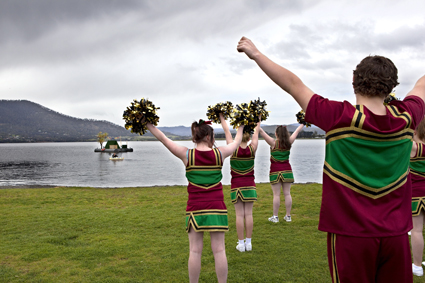
James Newitt, My Succession Party, 2011, Elwick Bay, Iteration Again, CAST
photo Millie Mutimer
James Newitt, My Succession Party, 2011, Elwick Bay, Iteration Again, CAST
ITERATION AGAIN, AND AGAIN, AND AGAIN…A LEVEL OF COMMITMENT FAR BEYOND THE CAPACITY OF MOST WAS REQUIRED TO EXPERIENCE A SIGNIFICANT AMOUNT OF THIS EPIC FOUR-WEEK PROJECT, DIRECTED BY DAVID CROSS. AS THE TITLE SUGGESTS, EACH ARTIST WAS ASKED TO REPEAT AND BUILD UPON THEIR MOSTLY PERFORMATIVE AND PARTICIPATORY ARTWORKS EVERY WEEK.
Seven Tasmanian curators selected both international and local artists to develop a total of 13 discrete projects, the result being a wide range of interpretations of the original premise, isolated schedules and a level of bureaucracy that could explain the variation in artwork quality. For all the hype within the local art scene, many of the projects were underwhelming, and while promoted as public art, few of them in my opinion engaged with the public or in public spaces in a meaningful way.
The most memorable iterations were Best Practice by John Vella, MCR by Marley Dawson and Christopher Hanrahan, My Succession Party by James Newitt and Paul O’Neill’s Our Day Will Come. Vella’s project, curated by Jane Stewart, sees helium balloons promising free original artworks distributed around Hobart. At a Salamanca Markets stall, a single helium balloon—the last one perhaps— is placed under a rock creating a tension between politeness and our desire to collect something for free (even if not the artwork, the novelty of a helium balloon). More balloons are tied to bike racks around the city over the four weeks, but always one at a time so the only sign that people are taking them is the steady build-up of severed black string. The balloons, accompanied by a weekly spruiker outside Arts Tasmania, lure people from the public space into the art institution where Vella’s prolific art practice is on display. I swap my balloon for an artwork cut-out, my two-week-old wilted balloon is nailed to a board in the window, and after the exchange, I’m instructed to pose for a photo with the artist. The display of ego is somewhat countered by the artist’s manipulation of an orchestrated market in which he’s oddly able to sell the same items that are being distributed for free.
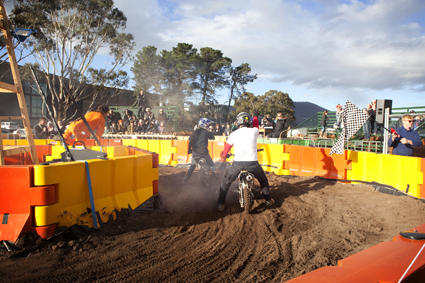
Marley Dawson & Chris Hanrahan, MCR 2, 2011, Berriedale, Iteration Again, CAST
photo Millie Mutimer
Marley Dawson & Chris Hanrahan, MCR 2, 2011, Berriedale, Iteration Again, CAST
The MCR, or MONA City Raceway, sited at the newly opened museum, is a repeat of a previously installed raceway for Performance Space at Sydney’s CarriageWorks. Dawson and Hanrahan have built a miniature motocross course on the roof of the museum, complete with an enthusiastic commentator, kitsch rotating logo, smoke machine and the waft of grease from the mobile Dagwood Dog stall. It’s fun and decidedly weird. However, there’s a nagging sense of insincerity. We exclaim at the ‘authenticity’ of the fried food smell, yet drink boutique beer from the adjacent stall, the food mostly untouched (“oh, I wouldn’t eat a Dagwood Dog!”). The art audience enjoy watching the largely incompetent artists balanced on tiny bikes, stalling and being rescued by the patient motocross experts, but wouldn’t be seen dead at a genuine motocross event, or even the neighbouring dirtbike track. David Walsh apparently agreed to MCR being based at MONA on the basis that it doesn’t sound like art, and while MCR is under the general project banner of public art, the work makes for a comfortable extension of its host institution.
Nearby, James Newitt has constructed a small island on the Derwent River in Hobart’s northern suburbs, adorned with a decorative palm tree and sturdy tent, where the artist lives for three weeks following the extravagant launch. On a bleak Saturday, we march along the foreshore led by the police band. We have balloons and horns and a group of unfortunate-looking cheerleaders perform a farewell routine. Like Best Practice and MCR, Newitt’s project has a level of humour, yet also like MCR, the send-off feels hollow, displaying a veneer of festivity with the almost exclusively art world audience performing the celebration (in a footy-obsessed state, is it wise to schedule on AFL grand final day?).
Our Day Will Come by artist Paul O’Neill, curated by Fiona Lee, takes bureaucracy another step further. Each week, O’Neill invites additional international artists to help him host the free school, which is paradoxically held in a small trailer inside the Tasmanian School of Art courtyard. While the venue is physically accessible to the public, visitors still have to cross the boundary from public space to art institution in order to participate, and it’s intimidating even for someone who works at the TSA. O’Neill invites ‘students’ to brainstorming sessions, one-on-one consultations (art counselling) and to weekly dinners where presentations are made by anyone on any topic. By the last dinner, the attendees outgrow the space of the presentation room, and while there’s talk by locals of continuing the evenings beyond the project, it’s doubtful that the same inclusiveness will be maintained. The relationship between the ideology of the free school and host institution is also contradictory with the introduction of an official TSA unit on discursive art practice in conjunction with Our Day Will Come.
Other projects are either disappointing (Ruben Santiago’s Long Drop into Water), difficult to access (Maddie Leach’s Let Us Keep it Together) or, in the case of Bethany Fellows’ Hobart Urban Illumination Project, seem more like a juvenile prank than a resolved artwork. As someone who’s had the unfortunate experience of living in one of the notorious Hobart streets that fail to receive direct winter sunlight, I appreciate Fellows’ premise of bringing light to these residents. In its physical manifestation, however, the work involves the artist driving around pre-dawn obnoxiously playing loud pop music and shining flashlights into people’s windows.
David Cross chose Tasmania for Iteration Again because of the co-operation between different institutions, the tight art community and because Tasmanians “look out,” arguing that “we’d struggle to do this anywhere else in Australia.” When I consider the turnout at Newitt’s farewell, the final Our Day Will Come dinner and the participation at the MCR relative to Hobart’s size, I believe the project has engaged many within the art community. However, it seems more like public art for the art world. There were forums, weekly artist talks, discussions at the Iteration Again ‘hub’ and writers assigned to each project for a quick written response. Many of the artworks appear interesting on paper, and the level of orchestrated dialogue, photographic and written documentation will no doubt make a great post-project catalogue and topic for future conferences. To make art for the art community is not a negative thing per se, and I realise public art is not just about the audience, but I assume Cross had greater aspirations for his project.
CAST, Iteration Again, curatorial director David Cross (NZ), curators Fernando Do Campo, Nicole Durling, Sarah Jones, Fiona Lee, Damien Quilliam, Paula Silva, Jane Stewart, artists David Blamey (UK), Lucy Bleach (AUS), Rhona Byrne (IRE), David Clegg (NZ), Marley Dawson (AUS), Bethany J Fellows (AUS), Annie Fletcher (IRE), Christopher Hanrahan (AUS), Toby Huddlestone (UK), Anthony Johnson (AUS), Maddie Leach (NZ), Gareth Long (CAN), James Newitt (AUS), Jem Noble (UK), Paul O’Neill (IRE), Raquel Ormella (AUS), Garrett Phelan (IRE), Sarah Pierce (USA/IRE), Ruben Santiago (ESP), John Vella (AUS), Mick Wilson (IRE), Voice Theatre Lab (AUS); various locations around Tasmania, Sept 18-Oct 15
RealTime issue #106 Dec-Jan 2011 pg. 43
© Lucy Hawthorne; for permission to reproduce apply to realtime@realtimearts.net
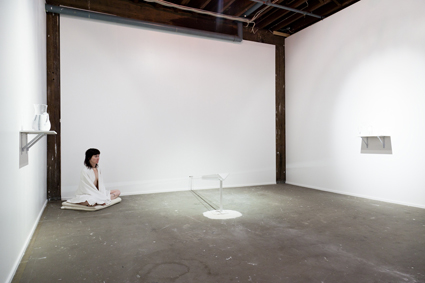
Fiona McGregor, Water #3: Expulsion
photo silversalt photography
Fiona McGregor, Water #3: Expulsion
AT SURFACE LEVEL, THE WIDESPREAD PREVALENCE OF SLOW TIME IN VIDEO PRACTICES AND DURATION IN PERFORMANCE ART IS UNDERSTANDABLE AS A COUNTERPOINT TO THE AGE OF DISTRACTION IN WHICH WE LIVE. BUT THIS NATURAL FIT ALSO POSES A CHALLENGE FOR ARTISTS WORKING IN THIS VEIN, WHO MUST SEEK WAYS TO GO BEYOND WHAT HAS BECOME A MUCH USED ARTISTIC STRATEGY.
Two compelling durational performance installations presented in Sydney this November—Fiona McGregor’s Water Series and John A Douglas’s Body Fluid II— suggest durational work still has the capacity to challenge and engage audiences, although somewhat paradoxically it now appears most effective when approached in a multi-faceted way.
water series
Stillness, risk and endurance were the common threads running through McGregor’s Water Series, where for three weeks Artspace became home to her accumulative and visceral project comprising video and photographic artifacts of two earlier endurance works as well as three durational performances undertaken live in the gallery. Filling one room was Vertigo (2009), a four-hour and 50-minute film capturing one of McGregor’s initial engagements with water as she spent several agonising hours lying flat on a cliff at North Bondi facing directly out to sea to confront head-on her fear of heights (see RT Studio). Presented at MOP in February as a single linear projection, at Artspace McGregor adopted for Vertigo a multi-screen approach with six projections looping various vantage points including two cast directly onto the ground, recreating her both terrifying and awe inspiring view from the precipice. The effect of this panoramic seascape was to bring the viewer closer to the artist’s experience. Initially affecting as a subtle and slowly unfolding meditation upon the sea as psychic terrain, in this instance the experience of ocean as limit was compressed and forceful, the mental transition of moving beyond fear more immediately palpable.
Where the early works involved a bodily and psychological encounter with landscape (Tidal Walk [2009] saw McGregor walk laps of Bondi Beach for the 11.5 hour duration of a tide cycle) the newest installments were energised by the immediacy and vitality of an audience presence. The motivation was also less internal as McGregor’s more political concern for water scarcity was played out in the live endurance actions of having rainwater dripped continuously onto her salt covered body, the introduction of a saline drip into the body while having blood extracted, tattooing with water and the drinking of large quantities of water to produce urine to activate a small garden fountain. Traces were left in the gallery marking the sites of the actions, creating a ritualistic atmosphere that intensified the resonance of McGregor’s undertaking as the exhibition period progressed.
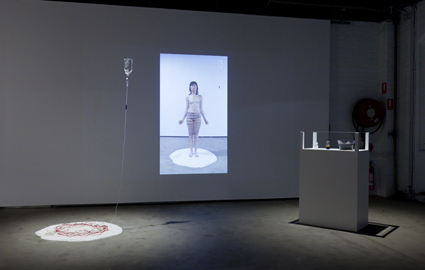
Fiona McGregor, Water series, installation
photo silversalt photography
Fiona McGregor, Water series, installation
These were challenging gestures that converged time, body and nature as a medium, transcending their literal messages to provoke more personal and subjective responses. For Descent #1, McGregor had envisaged enduring 24 hours under dripping water although as I arrived the performance had just concluded after five and a half hours as her body succumbed to the first symptoms of hypothermia. Watching the remaining water drip eerily from the latex bulb suspended from the ceiling and onto the hard plywood table where the artist had lain, a ghostly outline of her body imprinted in salt was a stark reminder of human frailty and the enduring power of performance art to jolt us from everyday complacency.
body fluid ii
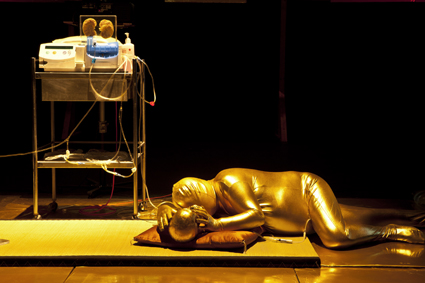
John A Douglas, Body Fluid II
photo Alex Kershaw
John A Douglas, Body Fluid II
A few days later at Performance Space’s Clubhouse, John A Douglas’ 10-hour durational performance Body Fluid II took a very personal concern—the artist’s own reliance on life supporting medical treatments—and imaginatively stretched it to epic proportions, netting a broad variety of themes along the way. In a surreal setting melding the chintzy glamour of a lo-fi science fiction film set with the sparse interior of a hospital room, the artist began by lying prostrate on the floor while hooked up to a peritoneal dialysis machine, plastic tube protruding from his rotund Buddha belly. Dressed in a tight, shiny, gold bodysuit that covered eyes, nostrils and mouth, there was a wry humour in its resemblance to both submissive bondage attire and a Hollywood superhero costume gone awry, while an atmospheric soundtrack echoing the pulsing rhythm of a heartbeat with a primal, earthly rumbling completed the transition into this strange mythic-medical space.
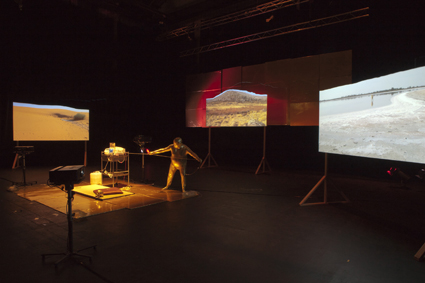
John A Douglas, Body Fluid II
photo Alex Kershaw
John A Douglas, Body Fluid II
Against a backdrop of parched Australian bush, desert and salt lake landscapes projected across three screens, a mat of gold tiles formed the parameters of the performance space within which Douglas languidly unfolded choreographed movements spanning gentle grasps, reaches and mime-like hand actions to laboured walking and full body seizures and collapses. At the corner of the artist’s ‘hospital bed’ stood a gold skull, facing toward the audience as a memento mori. It was a fitting piece of symbolism for this unnerving yet humane meditation upon not only the physical and mental challenges of an ongoing illness but also, more broadly, how the fact of our mortality plays out in the psyche. Employing his body as a vessel to communicate diverse states, from burden, exhaustion, depletion and apathy to wonder, curiosity and renewal, Douglas effectively distilled in memorable images the see-sawing feelings that underwrite our ambivalent attitudes toward life and death.
Douglas’ work often subjectively reinterprets film and in Body Fluid II there was an open-ended dialogue with Nicolas Roeg’s 1976 cult classic The Man Who Fell to Earth. An identification with the quest of the ageless humanoid Newton (Bowie) to save his drought stricken planet worked to deepen the associations and, as the artist’s gold alien alter ego chimerically appeared then disappeared from the ancient landscapes on screen, I was reminded that we’re just visitors to this land in both the colonial context and when measured against the immense scale of deep-time. This close attunement to temporality linked both Douglas’ and McGregor’s performance installations but this was neither artist’s true subject. Rather, in these works time, water, energy and endurance must all eventually run out, which provokes an awareness of the finite nature of human existence. At times confronting, these were life affirming actions that resonate in an age of environmental crisis where the ability to care for a fragile world demands a recognition of our interdependent place in natural systems that we can impact on but not control.
Fiona McGregor, Water Series, Artspace, Nov 1-20; John A Douglas, Body Fluid II, Performance Space Clubhouse with Chalk Horse, CarriageWorks, Sydney, Nov 4
RealTime issue #106 Dec-Jan 2011 pg. 44
© Ella Mudie; for permission to reproduce apply to realtime@realtimearts.net
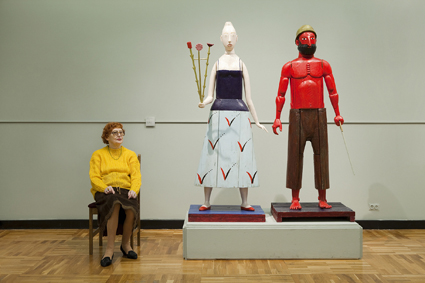
Vatagin’s Irene Starzhenetskaya and Anatoly Komelin, State Tretyakov Gallery, Russia, photo Andy Freeberg, Guardians series, 2011; Otherwise Projections 2011
THE BIRTH OF THE SLIDE SHOW FORMAT AS A MEANS TO SHOWCASE PHOTOGRAPHERS’ WORK ORIGINATED IN SYDNEY WITH REPORTAGE IN 1999. FOUNDED BY PHOTOGRAPHERS MICHAEL AMENDOLIA, STEPHEN DUPONT, JACK PICONE AND DAVID DARE PARKER. THIS EVENT WAS A RESPONSE TO THE PAUCITY OF OUTLETS FOR DOCUMENTARY PHOTOGRAPHY AND PHOTOJOURNALISM AT THAT TIME.
An initial screening took place at the Valhalla Cinema in Glebe. Images were set to a music track, establishing the formula. Other projection events followed, including Cross Projections and Trampoline. Reportage (now run by Jacqui Vicario) celebrated its 10th anniversary in 2010.
In September this year a significant new slide show raised the bar. Otherwise Projections screened at The Red Rattler in Marrickville. It was an exciting event set in a dark nightclub atmosphere. Despite the stated intentions of the producers to expose people unfamiliar with documentary photography and “show them what a great medium it is,” the audience was overflowing with Sydney’s top photographers.
In contrast with previous slide shows, of 12 photographers only four were Australian—Stephen Siewert, Dean Sewell, Billy Maynard and Katrin Koennig. Producers Isabelle Rouvillois (Picture Editor), Chris Gleisner (Project Manager) and Andrew Nicolson (Music Editor) worked together in tight collaboration. Rouvillois’ extensive experience as a picture editor in France and her knowledge of European and international photography made a major imprint on the event. Andrew Nicolson’s encyclopedic music knowledge contributed to a neat match of subject matter, image style and music tracks. Gleisner is a respected photographer and teacher with a history of community projects. Rouvillois and Gleisner together cut their teeth on last year’s Head On Photo Festival slide show.
The international content oriented our attention beyond Australia and emphasised the unique skills of the Australian inclusions while placing them in the context of world photography—a much needed perspective. The true achievement of Otherwise Projections however was to present a global point of view while blending different photographic genres, defying easy analysis. Rouvillois says, “Part of our aim is to showcase works on the edges of photojournalism and fine art conceptual work, the kind of thing you won’t see on a front page or in a gallery.”
Highlights from the show for me included Andy Freeberg’s (USA) Guardians, a humorous essay about the women who work as attendants in the art museums of Russia; Fluffy Clouds by Jurgen Nefzger (Germany) cataloguing nuclear power stations in the natural and social environment throughout Europe with a kitsch visual style; and my personal favourite, Trans/Tender, a series on transgender people in East Timor by Billy Maynard, an Australian newcomer.
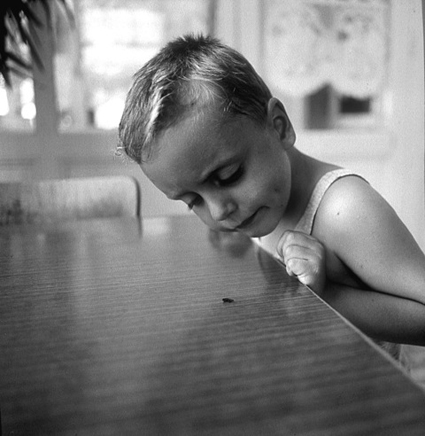
I am Winnie the Pooh, Otherwise Projections
photo Hughes de Wurstemberger
I am Winnie the Pooh, Otherwise Projections
Otherwise Projections was a one-off leaving only the post-show conversations and word of mouth to confirm its success. The producers say they will work towards another event next year. Watch out for this one!
Cross Projections is now in its ninth year. The mission statement declares, “Cross Projections grew out of a desire for experienced documentary photographers to maintain control over the presentation of their work, and to showcase their stories to their peers and the wider community.” Subtitled “A Cinematic Screening of Documentary Photography,” Cross Projections was instigated in 2003 at a time when photographers felt that they were being forced out of galleries because of a change of direction in contemporary art photography. An urgent need was expressed for new outlets to make their work visible.
In Cross Projections photographers work as a collective managing the slide nights and a strong sense of community develops. The producers select participants and curate their sequencing in the production. Over time the slide show form has moved away from the simple use of still photographic images to include moving image, spoken word and new strategies for presentation.
This year’s inclusion of Maya Newell as Editor was significant. As the youngest photographer in the collective she has also been one of the most experimental. Her film background sets her apart and her pieces are innovative and challenging. Now she has applied her skills to the show as a whole.
Cross Projections is embedded in a tradition of social documentary, which includes a commitment to photography’s ability to change and deepen our perceptions of the world. Social concern is laced with emotion and heart, driven by the directorship of Roslyn Sharp and Amanda James, both of whom presented assured series in this year’s show. James’ Out of Order is a collaboration with ‘at risk’ students from Edgeware School who find their voices by creating words and phrases beginning with individual letters from the alphabet: “P is for Perspective. Me and the police have different perspective”; “C is for Closed-Circuit TV. Watch the cameras.’’
Other standout pieces included Anthony Browell’s Wall of Death, about a family of carnival motorbike stunt riders; Australia’s strongest street photographer Marco Bok’s One Night at Mardi Gras; Jon Reid’s Predominantly Orange—an artfully playful survey of traffic cones; and Sasha Woolley’s Beneath the Bridge, about a family living in poverty under a bridge in North Jakarta. It’s hard to separate the photographers this year and I must also mention Lee Grant, Tracey Nearmy, Adam North and Adam Taylor.
A glance at the websites of each of these events reveals an informative and valuable resource. In the Sun Herald (October 16) commentator Charles Waterstreet made the cheeky suggestion that Cross Projections was a kick in the groin to events such as Tropfest. Screen envy? All power to photographers and may they remain highly visible, employing their unique storytelling gifts to chase the tail of filmmakers.
Otherwise Projections, The Red Rattler, Sept 2, www.otherwiseproductions.com.au/; Cross Projections, Tusculum House, Potts Point, Oct 6-8, www.crossprojections.com.au/cp_flash.html
RealTime issue #106 Dec-Jan 2011 pg. 45
© Sandy Edwards; for permission to reproduce apply to realtime@realtimearts.net
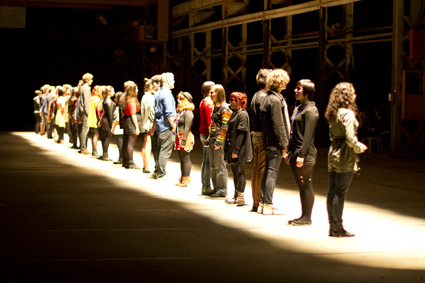
Marina Rosenfeld’s Teenage Lontano, THNMF 2011
photo © Brad Serls
Marina Rosenfeld’s Teenage Lontano, THNMF 2011
AS AIDAN O’BRYAN PUTS IT IN THE TITLE OF HIS 2008 DOCUMENTARY THERE IS “SOMETHING IN THE WATER” IN PERTH THAT MAKES IT A FERTILE GROUND FOR MUSICAL EXPERIMENTATION. HE WAS DEALING MORE SPECIFICALLY WITH THE PLETHORA OF INTERESTING ROCK AND INDIE BANDS THAT HAVE EMERGED OVER THE LAST FEW DECADES, BUT THE SAME CAN ALSO BE SAID OF THE EXPERIMENTAL, ELECTRONIC AND CONTEMPORARY CLASSICAL SCENES. THIS, AND THE SMALLER POPULATION WHICH ENCOURAGES MORE COMMUNICATION ACROSS SCENES, MEANS THAT THE TOTALLY HUGE NEW MUSIC FESTIVAL IS ONE OF AUSTRALIA’S MOST ENGAGING NEW MUSIC FESTIVALS.
RealTime was invited to be onsite to cover the 10th incarnation of the festival and in this task I was ably assisted by two Perth-based writers and composers, Sam Gillies and Henry Andersen. A selection of their reviews follows this conference report. The full coverage can be found here including video interviews with Marina Rosenfeld, composer in residence and Eugene Ughetti, artistic director of Speak Percussion, company in residence.
thnmf conference: materials & conditions
The Totally Huge New Music Conference was a key part of the festival bringing together many of the visiting artists to discuss their work with reference to the theme of “immanence.” Conference conveners Lindsay Vickery and Tos Mahoney proposed that the “slippery nature of contemporary culture and postmodern phenomena, such as the deconstruction of identity and distrust in metanarrative, arguably squeeze the individual into reliance only upon the present moment” (website). Due to writing commitments I could only attend the Saturday sessions of the conference covered here.
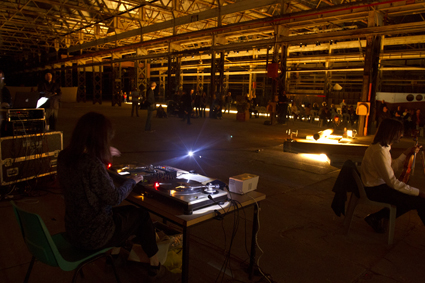
Marina Rosenfeld (foreground), Cannons performed by Decibel, THNMF 2011
photo © Brad Serls
Marina Rosenfeld (foreground), Cannons performed by Decibel, THNMF 2011
New York artist Marina Rosenfeld presented the keynote address, titled “Plastic Materials and Local Conditions: Diagram of a Practice,” in which she contextualised her work through the sense of the personal as social—the self as an unavoidable condition. Describing her materials as voice, architectures and the self, she explores the shifts between form and substance to create music which she defines as neither neutral nor universal. Rosenfeld exemplified this with her recent piece roygbiv&b commissioned by MoMA in New York—a spectral composition (literally) based on the colours of the rainbow, performed by teenagers singing phrases of contemporary R & B songs, accompanied by a spatialised sound score. The insightful analysis of her own practice and video sample made me even more regretful that I would not be able to see her major works Teenage Lontano and Cannons which were to be presented at the Midlands Railyards later in the festival, however Sam Gillies report offers a fine sense of the event.
New Zealand artist Bruce Russell, member of the band the Dead C and cultural critic, presented a paper titled “’No more driver call me, many thousand die’: improvised noise considered as twenty-first century field hollers and prison songs.” Starting with Alan Lomax and his recordings of early 20th century blues, Russell drew parallels with contemporary noisemaking in its potential for resistance and rebellion or, more accurately, its refusal to engage with a mainstream oppressive hegemony. Citing theorist of the moment, Slavoj Zizek he suggested that in this current technocratic age sound workers are proletariats and the role of noise “the reply to which there is no reply,” though ironically his paper created much by way of engaged response.
Nat Bates, director of Liquid Architecture directly approached the topic of immanence with his paper “Sampling and the ‘sound object’ in contemporary Sonic Art.” A fine example of practice as research he analysed each sound object or unit in Bernard Parmegiani’s musique concrète piece La Création du Monde and developed corresponding sounds from a palette of rock samples. In this way he equated the acousmatic with immanence—a material listening—and the non-acousmatic with transcendence—as causal and signified. In his use of contemporary music samples Bates also touched upon John Osborne’s Plunderphonics and its commentary on the cultural signification of sonic material. He concluded by quoting Mitchell Whitelaw’s concept of transmateriality—sounds constantly moving between states of immanence and transcendence—echoing Marina Rosenfeld’s idea of shifting between neutrality and universality.
Another stimulating conversation was prompted by a paper by Nicholas Russo who explored how contemporary Australian pop music seems caught in a time-machine set to golden era of rock, 1963-74, with comparative examples which suggest some bands, in their homage, are verging very close to plagiarism. Cat Hope explored the line in graphic musical notation and its translation into sound as glissandi, with reference to historical examples and in her own compositions for Decibel (see review).
Near the end of the day Anthony Pateras offered a provocation, suggesting that in this age of cross-disciplinarity and collaboration a composer should seek a sense of aloneness in their creative pursuits. Borrowing Lacan’s dialectic of love and desire—equating love with style and acceptance and desire with technique and no concern for the other—Pateras suggested that contemporary technology that connects us and offers alternative modes of distribution, is actually creating an over reliance on peer approval. He asked: is the superfluity of music, the plethora of stylistic trends and the ability to self-publish and instantly receive responses actually damaging young composers’ ability to think for themselves?
Over three days, the conference explored a vast range of approaches to the idea of immanence including discussions around Black Metal, Dubstep, site specific jazz, audiovisual interfaces and minimalist guitar music. Providing an opportunity for emerging and established artists to present papers there was plenty to reflect on and from varied perspectives. As with the last three THNMF Conferences, the papers will also be published (with Sound Papers Three coming out in time for this event) adding a valuable resource for the study of Australian music.
moments of substance
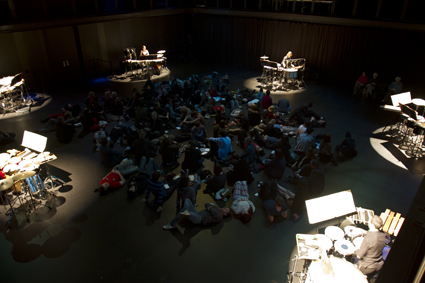
Speak Percussion, Le Noir de l’Etoile
photo © Brad Serls
Speak Percussion, Le Noir de l’Etoile
With often two concerts per night there were many highlights. My favourites were individual works which attained Mitchell Whitelaw’s idea of the transmaterial— moments where the here and now was explored and expanded into greater, timeless dreaming—such as Speak Percussion’s delicate and brutal duet with the universe in Gerard Grisey’s Le Noir de l’Etoile (see review). Speak’s performance of Anthony Pateras’ Refractions with its angles, gear changes and fleetness of thought was also totally invigorating. They created more magic with Thomas Meadowcroft’s playful homage to the sounds of domesticity in The Great Knot (review). There was also Decibel’s captivating game play and ensemble improvisation with Cat Hope and Lindsay Vickery’s interactive audiovisual score The Talking Board and their interpretation of Marina Rosenfeld’s White Lines (review). Julian Day’s meditative drone escalation titled An Infinity Room during Club Huge #1 (review) simultaneously bore down on us with sonic weight while elevating us with harmonic manipulation.
What was perhaps was most refreshing about this Totally Huge was its engagement with younger artists, both as creators and audiences. With strong connections to the academy through events such as the conference (co-presented with WAAPA Edith Cowan University) and the Break Out Young Composers’ Night, the involvement of young musicians and singers in Teenage Lontano and associated events such as NoizeMachinn!! (see review), the next generation of composers and musicians are receiving valuable opportunities. This and exposure to the inspirational artists that Totally Huge presented such as Marina Rosenfeld and Speak Percussion is definitely providing further nourishment—that extra something in the water—to the fertile ground for new music that Perth has become.
TURA, Totally Huge New Music Festival, various venues, Sept 15-25; Totally Huge New Music Conference, conveners, Lindsay Vickery, Tos Mahoney, co-ordinator Sonja van Thiel; presented by Tura and the Music Research Group, CREATEC and the Western Australian Academy of Performing Arts [WAAPA], Edith Cowan University, Sept 16-18,?Perth Institute of Contemporary Arts; http://www.tura.com.au/totally-huge-music-festival/about
For full coverage go to features
RealTime Associate Editor Gail Priest was a guest of the Totally Huge New Music Festival 2011, with thanks to Tos Mahoney (Artistic Director), Gabrielle Sullivan (General Manager), Alison Weburn (Publicity), Chris de Groot (Young & Emerging Artists Project Coordinator) and Cat Hope (CREATEC).
RealTime issue #106 Dec-Jan 2011 pg. 36
© Gail Priest; for permission to reproduce apply to realtime@realtimearts.net
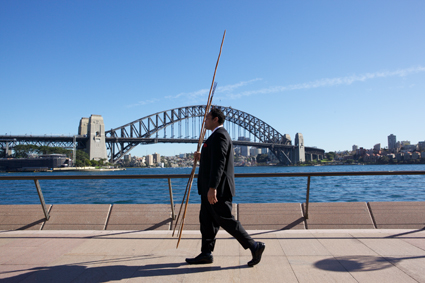
Radical Son, I Am Eora
photo Lisa Tomasetti
Radical Son, I Am Eora
ONE OF THE 2012 SYDNEY FESTIVAL’S CENTREPIECES IS BLACK CAPITAL, FIVE EVENTS AND PERFORMANCES HOUSED AT CARRIAGEWORKS ON THE EDGE OF REDFERN, HOME TO AND MEETING PLACE FOR INDIGENOUS PEOPLE FOR MANY DECADES AND A SITE OF PAIN AND SOCIAL TENSION BUT ALSO OF INNOVATION.
Black Capital includes 181 Regent St, Addressing Black Theatre, an exhibition and symposium curated by Rhoda Roberts. Forty years ago the National Black Theatre was established in Regent Street in Redfern launching the careers of Indigenous actors (including Bob Maza, Lillian Crombie, Justine Saunders) and writers (Robert Merritt, Kevin Gilbert, Jack Davis) in an atmosphere of cultural reflection and activism. Visual artist Brook Andrew’s Travelling Colony will fill the CarriageWorks foyer with hand-painted caravans in which you can experience the sounds, images and stories of Redfern. The Barefoot Divas, six singers and songwriters from Australia, New Zealand and Papua New Guinea will bare their stage lives and their relationships with their respective cultures in Walk a Mile in My Shoes. Black Capital Day will open the event with ceremony, performance (including excerpts from Erth’s I Bunyip), music and food.
At the centre of Black Capital is I Am Eora (I am of this place), a large-scale work with some 30 artists bringing together performance, film, literature and music under the direction of Wesley Enoch, artistic director of the Queensland Theatre Company. Three key figures in I Am Eora and in the history of Aboriginal Sydney are the warrior Pemulwuy, the resilient nurturer Barangaroo and the reconciler Bennelong. I asked Wesley Enoch about the I Am Eora collaborators’ motivation for the work.
So Wesley, are you Warrior, Nurturer or Reconciler?
Ha! That’s interesting. We sat around a table—me, Anita Heiss and Michael McDaniel doing a creative development months ago—and we all started to say, “Oh no, you are Barangaroo, you are Pemulwuy…” And it’s interesting that none of us wanted to claim Bennelong. He seems in the Aboriginal sense to be the ‘sell-out.’ But ultimately he’s the one we all think we are. We like to think of each other as warriors but we actually think of ourselves as the sell-outs, people who didn’t stand up enough.
I’m sure you’ll all be standing up with I Am Eora. How have you worked on this? Did you start with a script or did it come out of collaboration and improvisation…?
The beginning point was a discussion with (Sydney Festival Director) Lindy Hume—this is like four odd years ago—about the seminal stories, the important stories of Aboriginal Sydney. We were looking at a whole range of moments in time and what I landed on were the archetypes, if you like, that are based on the Warrior, the Nurturer, the Interpreter. These repeat themselves throughout each cycle of development in terms of the history of Aboriginal Sydney or Aboriginal Australia—to take the metaphor further. I’m sure there are more but these three figures became the touchstones for those archetypes. These historical figures—Bennelong, Pemulwuy and Barangaroo—started a way of understanding how we are today. So, all that thinking happened sitting around with a number of Indigenous thinkers and artists to tease out the idea behind the story, coming to the point where we said it’s not about telling the story in an historically accurate way. It’s more about trying to capture this feeling, the spirit of these archetypes and playing them out.
So you’re not bound by a narrative?
No. There are narratives but the idea of trying to make them totally accessible to an audience isn’t the issue. Koori Radio has emphasised how music is a real strength, especially in NSW, in terms of bringing things forward. We were talking about what Black Arm Band’s been able to achieve by singing songs. We said, well, we want to do more than that. So we’re looking at creating a supportive environment in which songs are sung and we tell a loose narrative about each of these figures.
In terms of the Warrior, Radical Son (David Lehar) already had a song about Pemulwuy that talks about the Warrior Spirit. So we’ve used some moments in Pemulwuy’s life as inspiration. He was considered in some respects almost super-human, surviving near fatal attacks twice before being killed with seven shots. So there was a sense that he would rise from the ashes and appear somewhere he shouldn’t have, just when everyone thought he was dead. One of us said, “Imagine if a kid went to a dress-up party as Pemulwuy instead of a super-hero. What would that look like?” One of the images of the show is just that. This Aboriginal kid turns up in a Superman outfit and is undressed and ochred up as a way of saying, “you are the connection to this man.”
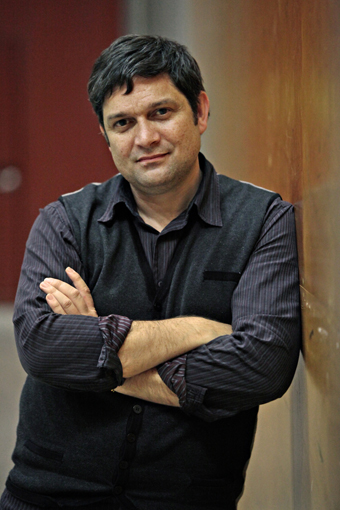
Wesley Enoch
photo Prudence Upton
Wesley Enoch
This is juxtaposed with the contemporary song?
All the music is contemporary although one of the things we’re looking at is a translation of “Botany Bay.” What does it mean if Bennelong sings “Botany Bay” in Darug? It’s a fun thing to do but also to show the living culture of it. With the music, we’ve looked to a number of key artists: Radical Son, The Stiff Gins and Wilma Reading. Wilma’s a fascinating Torres Strait Islander woman who does 1960s jazz, popular music and has toured Europe and lived in America for years.
How did you arrive at the casting?
A little by chance; a little by design. The casting evolved. We asked, “Well, who embodies these three archetypes—what songs, what actions would embody these three spirits?” I should say no one is actually playing any of these historic figures. The spirit of Barangaroo is played by five people in one section because we’re wanting different styles and different connections. But the spirit of Bennelong is being played by one man, Jack Charles, who has a connection through the Wiradjuri people [of central NSW]. For us, he’s not actually playing Bennelong—he’s playing an interpreter.
There’ve been incredible cultural gymnastics around negotiations about cultural ownership, about the position of the Darug and the other clans around Sydney Harbour and beyond—and a lot of stories often refer to primary sources written by non-indigenous people. We were trying to go for stories that were also shared or stories that have come through oral traditions, and different ways of looking at story.
Did you find these Indigenous stories easily or did you have to seek people out?
It’s a challenge. People come forward and tell us bits and pieces and so in some respects the whole show is a provocation to think in this particular way—even the title, I Am Eora, comes from a number of different sources. It’s almost a Reconciliation provocation too: how do the people who live in this land call themselves the people of this land? In some of our discussions we’ve quoted Germaine Greer’s Quarterly Essay, “White Fella Jump Up,” where she’s basically provoking people to think if you’re living on Aboriginal land, how do you call yourself “of” that land? And so I Am Eora is as much about saying how can people in the audience walk out after the show thinking, I need to feel like I am from here, I need to be of this land. I don’t know if they’ll get that. But that’s where it comes from at least.
A lot of people think of Sydney as a place where Aboriginal connections to the past are tenuous, where most of the clans were wiped out. But this will hopefully generate a strong sense of presence.
There’s lots of ownership. Just in the last few days I’ve had more Darug elders come and say, look we need to talk about this. I’ve got stories. In one of the creative developments we had a dancer in and he said, well in fact Bennelong is my great, great, great—I’ve forgotten how many greats there were—uncle. We draw a line down through connection to him. And you think wow! It makes sense. Of course there are still people living in the land who draw connections down 200 years or more to these people. It is fascinating.
The questioning of the dominant idea that Aboriginal people in Sydney didn’t exist or they were all wiped out is wonderful to challenge because these are historic figures; Pemulwuy, Barangaroo and Bennelong were real people. One of the contemporary manifestations of Barangaroo we think is Mum Shirl. We’re even talking about seeing [the politician] Linda Burney as being one of the modern manifestations of a strong female figure and nurturer in the Aboriginal community.
Finally, what about your own connection with Sydney through I Am Eora? You lived here when you were directing for the Sydney Theatre Company.
The support for and investment in me and my career and in me doing what I want to do, all that has been pretty incredible. We do have to pay our dues. The other thing is I’ve always had a very complex relationship with Sydney, emotionally complex. I’ve always felt a bit disconnected from and a bit hurt by Sydney. But I Am Eora is an incredibly patient way of Sydney saying okay let’s tell you some stories, make you feel welcome and part of it. The conversations are not easy. There have been some very heated discussions around the material. To be learning all the time is really important. Eleven years ago I moved to Sydney and now I’m actually thinking, this is maybe the project I should have started with as opposed to going to the Sydney Theatre Company and doing what I did [LAUGHS].
I’ve seen you on YouTube talking about I Am Eora.
That YouTube thing! The Associate Producer strategy—the crowd-sourcing idea—has been incredible, raising $240,000. The people of Sydney are really investing in I Am Eora—one big donor and then lots of mum and dad investors saying, yes, we’ll give a couple of thousand dollars for this story to happen.
Sydney Festival & CarriageWorks, Black Capital: I Am Eora, director Wesley Enoch, co-writer Anita Heiss, CarriageWorks, Sydney, Jan 8-14, 2012, www.sydneyfestival.org.au
RealTime issue #106 Dec-Jan 2011 pg. 14, 16
© Keith Gallasch; for permission to reproduce apply to realtime@realtimearts.net
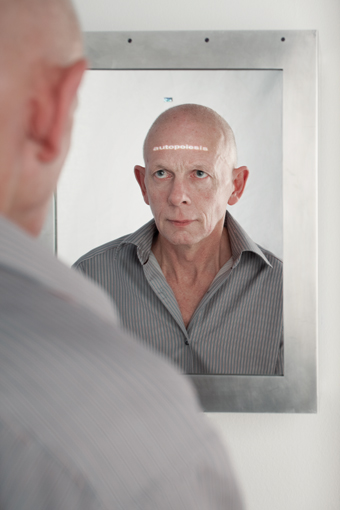
Rafael Lozano-Hemmer, Autopoiesis 2010, mirror, surveillance camera, laser projector, proximity sensor and computer, image courtesy and © the artist,
photo Peter Mallet
Rafael Lozano-Hemmer, Autopoiesis 2010, mirror, surveillance camera, laser projector, proximity sensor and computer, image courtesy and © the artist,
Mexican-Canadian electronic artist Rafael Lozano-Hemmer (www.lozano-hemmer.com) illuminates our reality in many fascinating ways, testing our sense perceptions and offering interactivity in large-scale public works and intimate installations (see interviews with and articles about the artist in RT89, RT97, RT99). Lozano-Hemmer is featured artist at Sydney’s MCA Dec 16-Feb 12 in a free exhibition, titled Recorders, of 12 recent works including two made for Sydney. The artist is asking visitors to leave traces of themselves—voice, heartbeat, belongings, questions—hence the show’s title.
Autopoiesis (2010), one of the works in Recorders, involves a mirror, surveillance camera (running face-recognition algorithms), laser projector, proximity sensor and computer. So take a look at yourself and muse over self-creation and the participatory nature of art—it’s that contemplative time of the year. All at RealTime wish you a Merry Self-reflective Xmas and, in these doggedly oppositional times, a Happily Nuanced 2012.
RealTime issue #106 Dec-Jan 2011 pg. 2
© Keith Gallasch; for permission to reproduce apply to realtime@realtimearts.net
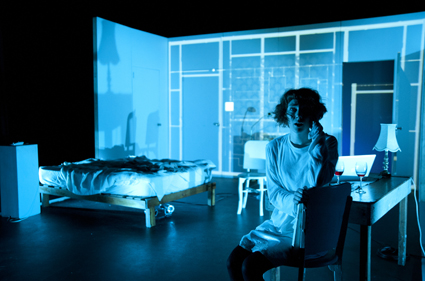
Erica Field, La Voix Humaine, Motherboard
photo Gerwyn Davies
Erica Field, La Voix Humaine, Motherboard
IN HIS SECOND BRISBANE FESTIVAL 2011 ARTISTIC DIRECTOR NOEL STAUNTON HIT HIS STRIDE WITH FOUR WORLD PREMIERES, FIVE AUSTRALIAN PREMIERES AND 11 INTERNATIONAL PRODUCTIONS, AND FOR THE FIRST TIME UNDER THE RADAR HAS BEEN INCLUDED IN THE FESTIVAL PROGRAM.
If it appeared there was a surfeit of choices on offer in the festival’s Santos City of (laser) Lights, it nevertheless seemed possible to weave a narrative of works that were not in themselves spectacular in scale and yet spoke eloquently on the theme that live performance above all serves as a mirror to remind us that it is the ecstatic, needy, desirous body we share in common with the rest of our species that is the material basis of our capacity for fellow feeling.
This was writ large on a sparse stage by the dancers’ bare bodies in Les Ballets C de la B’s Out of Context—For Pina (see RT105) directed by Alain Patel (see interview). This wondrous and strange piece of dance theatre sought to restore us to “the roots of childhood and prehistory” (dramaturg Hildegard De Vuyst), certainly to a time, as Marx has it, before capitalism turned even our senses into commodities.
Jack Charles v the Crown is the story of a stolen generation child placed into care and denied both his culture and family. Charles’ subsequent career as burglar, jailbird, junkie and pioneer of Aboriginal performance is told by him without self-pity or bitterness. Starting with a replay of Charles as junkie in Amiel Courtin-Wilson’s documentary Bastardy, while Charles works at his pottery wheel downstage, seemed almost a prophylactic (Charles shooting up) against being overwhelmed by his utter charm and seductive, velvety voice as he combines storytelling, personal history, cabaret and courtroom drama to telling effect. Simply staged and fluidly directed by Rachael Maza Long, this show allowed Jack Charles’ devastating honesty, humour and stage mastery of storytelling and song, seamlessly backed in the musical numbers by three consummate stage musicians (who showed great affection and respect for Charles), to create an intimate and standout show about the sorry history of Aboriginal and white relations in Australia. Written with long-time friend and early collaborator John Romeril, Charles’ stories were true and raw, the comedy black and the justice of his appeal to have his criminal record sealed undeniable. But Charles is no victim: at 67 he was the shaman of his own soul and, in the performance space, ensorcelled us too. He roundly deserved the standing ovation he received.
Lucas Stibberd likewise, in Boy Girl Wall, creates that theatre magic where our hearts and imagination are wholly given over. Ultimately it’s lonely boy meets lonely girl but it’s the journey that grips us, the animate and romantic Wall that divides them finally immolating itself as the deus ex machina to get them there. Set in an inner-city suburb near you, this funny, clever, imaginative and breathless narrative barely flags as Thom (boy) and Althea (girl) pursue their separate trajectories through the minefields of (post) modern singles’ lives, evil magpies, intransigent objects, bastardly or at least indifferent bosses, string theory and quantum mechanics. On a nearly bare thrust stage, supported only by musician Sarah Winter, Stibberd’s unbridled inventiveness realises all the myriad characters, human and inanimate, using sock puppets, chalk drawings, an overhead projector and his own unflagging energy and timing to transform the Roundhouse stage into a place where, eschewing irony, finding what makes you truly happy becomes the only way to go.
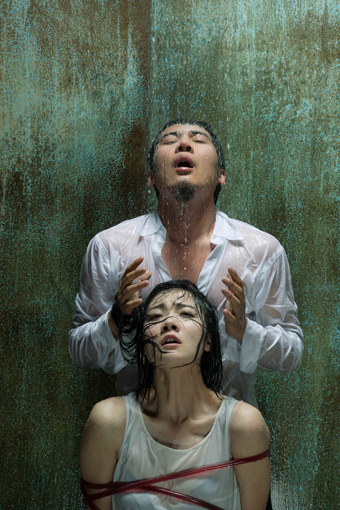
Rhinoceros in Love, National Theatre of China, OzAsia 2011
courtesy OzAsia
Rhinoceros in Love, National Theatre of China, OzAsia 2011
Rhinoceros in Love from the National Theatre of China seemed to endorse the same sentiment but also, and perhaps unintentionally, reveals the dangers of rampant individualism. It’s hard to tell, not least because the text by Liao Yimei is so poetic (at least it appeared so in the surtitles), while the direction of her husband, Meng Jinghui, blurred dream and reality in a blend of Eastern conventions and Western avant-garde style that gave fresh resonance to the commonplaces of romantic love. The core plot concerns zookeeper Ma Lu’s (Nianhua Zhang) obsessive and unrequited love for neighbour Ming Ming (Xi Qi) who herself is hopelessly in love with a man who does not reciprocate her feelings and treats her badly. Ming Ming in turn treats Ma Lu indifferently and his only outlet for his feelings of rejection is the one-sided and impassioned conversations he has with the rhinoceros in his charge who is similarly solitary. However, as events unfold, Ma Lu can be seen as stalking his beloved, and he eventually kidnaps her, although this may be hallucinatory, occurring amid torrents of rain signifying his overflowing feelings and the full force of his damned-up passion. There is moral ambivalence here, suggesting Ma Lu’s all-consuming love is madness, but also endorsing, especially in Ma Lu’s final stirring address to the audience, that remaining true to oneself and to the authenticity of your heart’s desire is valid. (See Jonathan Bollen’s review of Ozasia)
Ma Lu in his isolation at the end is not so far away from the position of Meursault in Albert Camus’ novel, The Stranger, which was a cause celebre among the post-World War II generation of youth in Europe and America; and of Holden Caulfield, the young protagonist of JD Salinger’s Catcher in the Rye which captured young people in the 1960s in a way that is comparable to the popular effect that Rhinoceros in Love apparently has had on the millennial generation in China. It also presents a highly satirical, comedic view of the effect of market forces on this generation and their aspirations and desires. This provided opportunities for sharp social vignettes conveyed with pointed humour by the fluid and polished ensemble. It reminded me in form, dedication and its questioning of social change, of the community theatre movement in Australia during the 1980s and was a welcome reminder of what has been lost in spirit through the so-called professionalisation of the arts in this country.
Some shows just push all the right buttons. Program notes tell us that The Dream Menagerie was loosely inspired by the Pyramus and Thisbe play from A Midsummer Night’s Dream and the wedding scene feast from Tod Browning’s cult 1930s film Freaks with, according to director Scott Maidment, a tribute to Fellini in there as well and perhaps also the New Testament with the parading donkey (a winner). Fellini is apt, because Maidment has a filmic eye which can create audience-involving spectacles turning soap bubbles or canvas into a vast, undulating ocean. I’ve become a fan of Strut and Fret since the entrancing circus cabaret Cantina premiered at last year’s festival. This year’s production provided Maidment with more scope to play with the image of a lush, surreal, all-embracing human and animal menagerie that conjured our best hopes and at the same time was both visually and sonically ravishing.
But this is a soft and surface dream. The players, drawn from the bouffant tradition, are whitewashed of their darker side. While The Dream Menagerie faithfully delivers a parade of delicious imagery and circus skills, it fails to engage the essence of the bouffant, which the Freaks film itself sums up succinctly in the resonating phrase “if you hurt one of us you hurt us all.” Intrinsic to this, and equally ignored, is the underlying savage rivalry that percolates within the bouffant family. This seemed a sadly lost opportunity to juxtapose and play with deeper emotions. Nevertheless as a lyric paean to the magic and transformative power of the circus, it remained memorably haunting, existing in a unique category all its own.
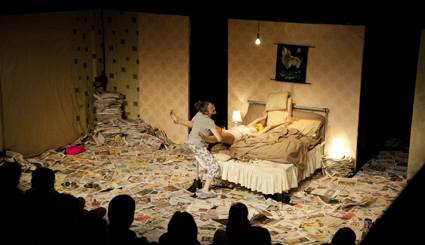
Anna Robi and The House of Dogs
photo Gerwyn Davies
Anna Robi and The House of Dogs
Anna Robi & the House of Dogs is not for the prudish. Everyone’s viscerally, and in the mother’s case vulgarly, on heat. If you can’t stand it get out of the kitchen or in this case the Sue Benner theatre. The script is cruel, coarse, sexually blatant and darkly funny and does not flag as both mother and daughter trade blow for blow in what seemed at times a newly minted, female version of the old English classic comedy, Steptoe and Son. Desperate for love, a la Doris Day movies, or at least sex, Stephanie Smith plays Anna, the sexually simmering but naïve young woman who is the carer and companion for her self-pitying, manipulative and wilfully invalid mother, a failed dog breeder, played with magnetic horror by Jeanette Cronin.
Their house is a kennel, literally, the set floor littered with dog shit and newspapers, the dogs appearing as scarily realised puppets that copulate savagely and mechanically, and the centrepiece a bed from where mother in a neck brace and soiled nightie dominates the life of the house. The re-kindling of Mum’s sexuality truly made me blanch. Anna picks up, or papers over, the turds, meanwhile attempting to initiate an actual love life through furtive calls to Roger who seizes them as opportunities for masturbatory phone sex. Emerging Queensland playwright Maxine Mellor takes us by the scruff of the neck and wipes our faces in all this mess and we cringe at the same time as we laugh at this reality without decent boundaries that so unashamedly elicits our own botched lives. Perhaps Anna Robi & the House of Dogs can be blamed for having sucked all the available squalid buffoonery out of the air.
La Voix Humaine by Jean Cocteau was first produced in 1930 and is regarded as a modern masterpiece. It has been much adapted: Francis Poulenc’s opera La Voix Humaine, Gian Carlo Menotti’s ‘opera bouffa,’ The Telephone and Roberto Rossellini’s film version in Italian with Anna Magnani, L’Amore (1948). In this vein, Brisbane independent performance group Motherboard performed their own experimental multimedia version earlier this year. Although it only updated Cocteau’s concern with the effect of technology on people’s ability to communicate with each other in a new, exciting way, producer Dave Sleswick ran into copyright problems and was forced to restore the original script.
It is a solo piece where a woman speaks on the telephone to her ex-lover on the eve of his marriage to another woman. His part in the conversation is inaudible, comprehensible only from her bodily reactions and complicated by the comfortable lies she tells him to keep him engaged on the phone. Erica Field bravely took on a role that has been performed by such divas as Simone Signoret, Ingrid Bergman and Liv Ullman. Her performance as a woman falling apart was intelligent and absorbing, painfully conveying the ambivalence and contrariness of desire.
In this, Sleswick’s faithful rendition of the text, it becomes apparent that the woman portrayed is a melodramatic or romantic figure who gives her all in a manner that I would have said is out of sympathy with contemporary attitudes had not Field singing Piaf’s perennial, “Non, je ne regrette rien,” reminded me that the figure is an immortal one, however much it contextualises the work at a particular time. I look forward to Sleswick overcoming his problems and following Motherboard’s project to its zenith next year.
2011 Brisbane Festival: Ilbijerri Theatre Company, Jack Charles v the Crown, writers Jack Charles, John Romeril, director Rachael Maza Long performer Jack Charles, musical director Nigel Mclean, set & costume Emily Barrie, lighting Danny Pettingill, AV design Peter Worland, live musicians Nigel Mclean, Phil Collins Mal Beveridge, Brisbane Powerhouse, Sept 7-10; The Escapists, Boy Girl Wall, performer Lucas Stibberd, writers Matthew Ryan, Lucas Stibberd, sound design Neridah Waters, lighting Keith Clark, set Jonathon Oxlade with Lucas Stibberd, musician Sarah Winter, La Boite Roundhouse, Sept 20-25; National Theatre of China, Rhinoceros in Love, writer Liao Yimei, director Ming Jinghui, Brisbane Powerhouse, Sept 21-24; Strut and Fret Production House, The Dream Menagerie, creative director Scott Maidment, performers Captain Frodo, Imaan Hadchitti, Derek Ives, Derek Scott, Genevieve Thackwell-James, music Trent Arkleysmith, Spielgeltent, King George Square, Sept 6-24; Anna Robi and the House of Dogs, writer Maxine Mellor, director Iain Sinclair, performers Jeanette Cronin, Stephanie Smith, Dean Mason, Sue Benner Theatre, Metro Arts, Sept 20-24; Motherboard, La Voix Humaine, writer Jean Cocteau, translator Anthony Wood, production Dave Sleswick, performer Erica Field, Performing Arts Space, Judith Wright Centre of Contemporary Arts, Brisbane, Sept 13-14
RealTime issue #106 Dec-Jan 2011 pg. 4
© Douglas Leonard; for permission to reproduce apply to realtime@realtimearts.net
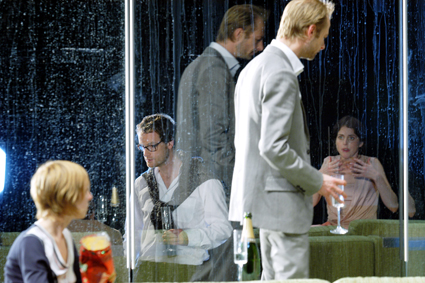
Hedda Gabler, Schaubühne Berlin
photo Arno Declair
Hedda Gabler, Schaubühne Berlin
IT IS ENTIRELY APPROPRIATE THAT THE BERLIN SCHAUBÜHNE’S PRODUCTION OF HEDDA GABLER WOULD MAINTAIN A TEMPERATURE OF ABOUT 13°C FROM BEGINNING TO END: IBSEN’S ORIGINAL WAS HARDLY A POT-BOILER TO BEGIN WITH. THIS 2005 PRODUCTION WAS TO BE ONE OF THE PREMIERE EVENTS OF THIS YEAR’S MELBOURNE FESTIVAL: THE FIRST WORK BY THOMAS OSTERMEIER TO BE SHOWN IN MELBOURNE (AFTER HAMLET AT THE 2011 SYDNEY FESTIVAL AND NORA (2002) AT ADELAIDE 2008).
hedda gabler
Instead, it disappointed. Two long, interval-less hours of idle chitchat—not even funny!—of three self-absorbed, coarse men, tied together with strings of manipulation pulled by a beautifully superficial young woman.
The acting is delicate and economical, all sideways glances, accurately angled slouches, moments of casual intimacy (a short shoulder massage) as denominators of underappreciated affection. Ostermeier’s Hedda heralded the move away from the whizbang of the 1990s to the simplicity and almost deliberate homeliness of the 2000s (think Benedict Andrews’ The City for STC in 2009, Sasha Waltz’s Medea in 2010). Like all trendsetters, this production exhibits inelegant single-mindedness: it is not much more than two studious hours of bored bourgeoisie, even if the psychological detailing is very fine.
Modernising Hedda has worked well in some ways: divine inspiration, intellectual mediocrity and pettiness are timeless qualities, and it is enormously satisfying to watch Hedda smash (not burn) an old laptop (not manuscript) with a hammer. However, unable to explain Hedda’s idle, self-defeating cruelty as thwarted life energy turned in on itself due to societal constraints (divorce has been legal for some time, as has a woman’s right to work), the production has to have her a spoiled child, too acclimatised to a life of idle nail-filing to realise herself in any de Beauvoirian sense. All characters go down a notch on the maturity scale as a consequence and what we see is less brutally honest than distantly odious.
journeys of love and more love
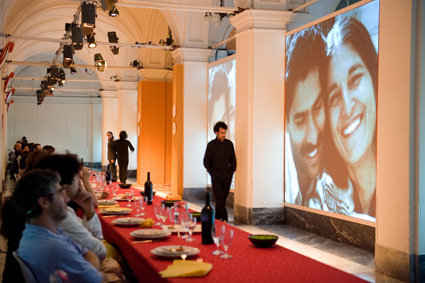
Journeys of love and more love, motiroti
photo courtesy the company
Journeys of love and more love, motiroti
But if the slow simmering of Hedda Gabler has a dramaturgical and socio-historical point, why does coldness permeate Journeys of love and more love, an autobiographical account of an Indian-English life from the UK’s motiroti, complete with family snaps and real food? We sit around beautifully laid out tables with 11 strangers at each, as Ali Zaidi, an “Indian by birth, Pakistani by migration and British by chance,” presents his slideshow memoir. Zaidi, an immaculately presented man, walks around without sitting down at any table, never quite getting to spend time with his guests—a stadium MC in a small space rather than a welcoming host. His life story includes all the right ingredients: sibling rivalries, romantic dramas, religious humour, lots of food. But it is so heavily mediated—family photos by animation, Zaidi’s voice via microphone, the feelings and emotional truths delivered with slick British-theatrical humour, the food with a heavy input of nouvelle cuisine—that all rude complexity is smoothed out by the time it finally reaches us.
The absence of contact is so thorough it feels like a fundamental dramaturgical decision: Zaidi makes no direct eye contact with the audience, the food is brought out by a catering battalion. For all the talk of intimacy, there was none in this work, and it felt almost offensive to have Zaidi ask at my table questions about our attitudes to love and hate. Such answers must be earned, even in a participatory performance. Journeys…felt like an event organised by a tourism board to promote multiculturalism. Here we were, white people, sitting at restaurant tables, paying money to be fed trendy transmogrifications of ethnic food and being told that this meant sharing. It was an almost perfect, cynical antithesis of hospitality, intimacy and love.
aftermath
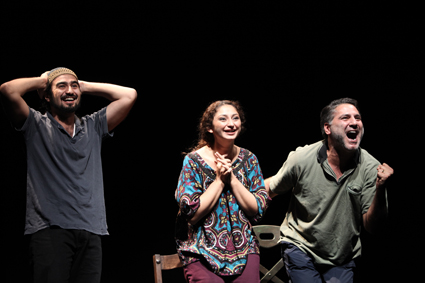
Aftermath, New York Theater Workshop
photo Joan Marcus
Aftermath, New York Theater Workshop
It is easier to conceptualise an artful immersion into another’s way of life than it is to execute it. It requires an emotional intelligence to break beyond the self-imposed demand to give the audience a fun, innocuous picnic in difference. Another festival show, Theatre Work’s Site Unseen (cancelled on the night I was to attend), was lambasted in the media for reducing, in the words of John Bailey in the Sunday Age, the “lived reality of destitution to a fun romp through the back streets of St Kilda.” In contrast, the qahwa and chai we are offered by the performers in Aftermath never materialise, but it is still a deeply engaging encounter with another world, that of Iraqi war refugees.
I find it hard to talk about Aftermath for fear of sounding trite: it is superb verbatim theatre, but its strategies are simple and its genius all in the execution. Like any verbatim work, it stages life stories, here of six Iraqi refugees (interviewed by the playwrights in Jordan) through first-person narratives distilled from interviews; it uses actors of broadly Middle-Eastern provenance; staging interventions are minimal; it shapes its loose material to make all the stories escalate in parallel; and it presents an entirely predictable set of accounts of a content everyday life disrupted by war, civil disorder, violence, uncertainty and flight. Like all verbatim theatre, it is half-real, half-creatively reimagined, and the invisible seams between the two make us more receptive to the finely crafted material. But if Aftermath is gutting rather than just a bit sad, it is because it recreates the interview itself, and the interviewees reveal themselves to be not just victims of war, but genuinely warm, kind and generous people.
Between anecdotes come offers of tea and coffee. Family photos, press clippings and club membership cards are offered for inspection. Every so often, a particularly horrific story ends and an Iraqi waves exhaustedly at the narrator: “Translate that.” ‘We’ are not present on this stage, not as interviewers, sympathetic spectators or interlocutors. The imam, who has lost everything in the war—his family, his home, his passport and documents—looks up and says, “I thank these people for their feelings, but there are mistakes for which apologies are not enough.” But even after outbursts of despair or anger, there are apologies, reassurances of welcome: “Please, you must stay for lunch!”
By being so much a show about these people—not just their life tragedies, but the way they have made home in tragedy, and the way they courageously resist acceptance of hatred and violence as normal—it is precisely not a show about us, our voting choices, our identities as left or right-leaning or the details of our domestic political debates. But these two instances of generosity—the generosity of the interviewees with their stories and the generosity of playwrights in recreating them—amounts to an enormous gesture of sharing.
political mother
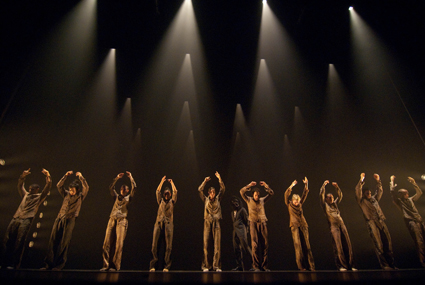
Political Mother, Hofesh Shechter
photo Simon Aboccedi
Political Mother, Hofesh Shechter
Finally, Hofesh Shechter’s Political Mother illustrates the relationship between the energy of music and the energy of violence. “Where there is pressure, there is folkdance” appears as writing on the wall towards the end, but by that point the thesis has been exceedingly well established by this rambling dance work. Sufi dancing has turned into a marching band, into a political rally, into a rock concert, prisoners’ stumbling, a discotheque and so on in rotation. Delivered to an explosive score (by Shechter himself) at ear-blasting volume, his customarily visceral choreography (half-erect lopes, punches, jitters) draws a continuum between spiritualism, militarism, rebellion, weekend venting and resignation. At its core, Political Mother demonstrates convincingly that one fuels another, that we are made of what we rebel against and that, wherever there is war there are young people in discotheques—for no frivolous reason. But Shechter’s transition into long form is not yet confident: many of the 70 minutes could have been excised to create a work that repeated itself less and delivered a conclusion.
It is true, as Age reviewer Cameron Woodhead suggested in regards to Site Unseen, that “the homeless need food, shelter and respect” more than theatre, bad or otherwise. One could ask if making art is the right response to violence, anomie, forced migration, and if we are buying moral consolation at the price of a theatre ticket. But there are countless atrocities in this world, and there will continue to be, and most of us will never be able to do much about them. The power of works like Aftermath, even Political Mother, is that they deepen what Melbourne historian Maria Tumarkin calls our emotional imagination. They make us understand, in all their detail, worlds of distant, strange people and in doing that, they are training us in empathy. Be it empathy for a Pakistani waiter, an Israeli backpacker or the Iraqi recipient of our tax money, it is empathy that modifies the emotional training we receive from spectacular war journalism, political speeches on ‘wedge issues,’ and the professional opinionati. If that is not a noble achievement, I do not know what is.
Berlin Schaubühne, Hedda Gabler, director Thomas Ostermeier, set design Jan Pappelbaum, music Malte Beckenbach, dramaturgy Marius von Mayenburg, video Sebastien Dupouey, The Arts Centre, Playhouse,Oct 19-23; motiroti (international), Journeys of love and more love, writer, director Ali Zaidi, video, animation Daniel Saul, Katerina Athanasopoulou, composer, sound Andy Pink, food Kim Berkers, Mark Ramsay, The Arts House, Meat Market, Oct 11-16; New York Theater Workshop, Aftermath, text Jessica Blank and Erik Jensen, director Jessica Blank; Malthouse Theatre, Oct 11-14; Political Mother, Hofesh Shechter Company, choreography, music Hofesh Shechter, lighting Lee Curran, costumes Merle Hensel, sound design Tony Birch, The Arts Centre, Playhouse, 12-15 October; 2011 Melbourne International Arts Festival, Oct 10-27
RealTime issue #106 Dec-Jan 2011 pg. 4
© Jana Perkovic; for permission to reproduce apply to realtime@realtimearts.net
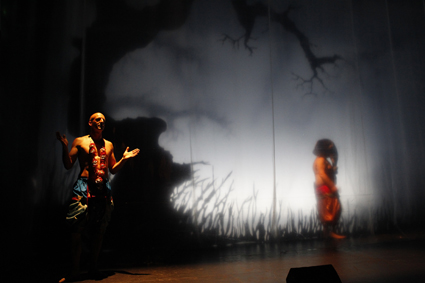
Ganesh vs The Third Reich, Back to Back
photo Jeff Busby
Ganesh vs The Third Reich, Back to Back
DISABILITY IN THEATRE IS TOO OFTEN THE ELEPHANT IN THE ROOM. WHILE AN INCREASING NUMBER OF AUSTRALIAN COMPANIES WORKING WITH ARTISTS WITH DISABILITIES HAVE BEEN PRODUCING RICH AND SOPHISTICATED WORK IN RECENT YEARS, IT DOESN’T SEEM THAT A CORRESPONDING DIALOGUE HAS EMERGED OUTSIDE OF THOSE CIRCLES ACTIVELY INVESTED IN SUCH WORK.
Back to Back Theatre is one of the few organisations to have pushed through those invisible barriers, and as latest production Ganesh vs the Third Reich again indicates, the company doesn’t just produce theatre of disability, but theatre about the theatre of disability.
back to back, ganesh vs the third reich
As with previous works such as Small Metal Objects and Food Court, Ganesh… immediately proves itself a complex and provocative engagement with its own audience. A group of actors are rehearsing the titular play, a narrative in which the Hindu god Ganesh voyages to World War II Germany to reclaim the symbol of the swastika from Hitler. It’s a compelling scenario, during which the elephant-headed deity encounters (and bests) the monstrous Dr Mengele, whose pronouncements on physical deformity and eugenics are chilling; an intellectually disabled refugee is on the run from Nazi pursuers; and finally, there’s the leader whose appropriation of the sacred mandala is a brutal theft of cultural identity. All kinds of currents swirl through this fertile play-within-a-play—concepts of power and visibility, voice and silence, nature and transformation. Yet the real energy of the work is located not simply in the narrative itself, but in its enactment and the frame within which it unfolds.
These are actors with perceived disabilities playing actors with perceived disabilities, and it is between these layers of perception that a deeply troubling dynamic arises. David Woods plays the initially benign director shaping the company’s rehearsals, but his real motivations are put on trial as debates arise on the floor over the ethics of representation, the agency of the performers and the necessary inequities of power in a director/actor relationship. It becomes apparent that his desire to work with this company is dependent on a certain selective vision of disability, one which requires a passivity and relinquishing of control to someone socially posited as more authoritative. It’s a question which has been put to Back to Back Theatre itself—what of these productions is created by its performers and what dictated by others? Here the query takes on terrifying urgency, as actors’ failure to comply with their director shifts from hilarious belligerence to emotional vulnerability and, eventually, physical violence. The final sequence is an unforgettable one, in which a man charged with a duty of care commits an act of casual yet devastating betrayal, leaving a performer with a promise that will never be fulfilled.
The implication of the audience in all of this adds a further layer of excruciating tension. At one point an imaginary audience is addressed and questioned on its reasons for attending. How is this act of voyeurism any more than prurient freak porn? Are we, too, demanding a certain kind of theatre of disability for ultimately selfish purposes? And when we leave the theatre, too, what promises have we made with no intention of keeping?
balletlab, aviary
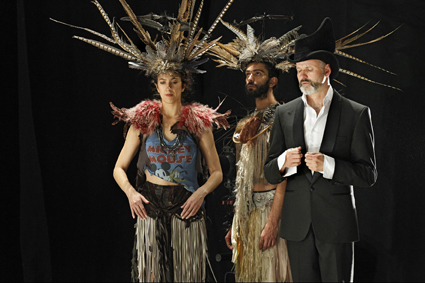
Brooke Stamp, Daniel Jaber, Phillip Adams, Aviary, Balletlab
photo Jeff Busby
Brooke Stamp, Daniel Jaber, Phillip Adams, Aviary, Balletlab
Dynamics of power, authority and observations are also the motors driving Phillip Adams’ latest Balletlab work, Aviary. It begins simply enough (this is an Adams’ piece, of course, so take that sentence advisedly). A group of dancers ‘perform’ a musical composition by Messiaen as birds. Reading from a score scattered across the stage, they interpret the notation as squawks and trills, leaps and poses. It’s curious, playful and even silly, but still recognisably centred in the vocabulary of contemporary ballet; if it gestures beyond itself, it is perhaps to the inherent artificiality of classical dance and the way its modes of display are closer to those of the caged bird.
In Aviary’s second sequence, that cage takes on queered proportions. Adams himself enters the space in pseudo-militaristic attire, an extravagant cape of white feathers sprouting from his shoulders. He leads a band of brownshirts in a sequence of ritualistic routines that bring to mind the charisma of religious and political leaders, the dazzling glare of celebrity and the dictatorial excesses of fashion and nightclub culture. It’s not a critique, per se—Adams seems fascinated by the seductive aspects of such power, even when miming the executions of his followers. While inside the cage, the work suggests, it may not be possible to imagine its outside. More importantly, it may not be desirable.
By the third act these notions are complicated even further. We are now in the wild, the dancers adorned with elaborate feathered headdresses and skirts, with Adams taking on the role of an observer not simply recording his observations but actively influencing his subjects. As birds, the performers engage in courting rituals, competing for attention, preening, strutting, constructing a vast and elaborate nest. Adams isn’t mere birdwatcher; he is equally the anthropologist and his dancers come to signify the exotic tribe encountered by the self-appointed avatar of civilisation. He becomes enamoured of his own power, cavorting amongst the twigs and leaves, loosening his sharp suit and becoming transfixed with his own reflection. It’s in this subtle moment that Aviary provides its sting: how much of our interest in the exotic, the other, the gaudy and beautiful is limited to what it reflects of us? If at times Aviary appears indulgent, excessive, self-involved, it’s for a very measured purpose.
chunky move, assembly
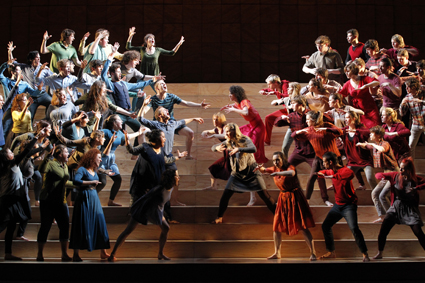
Assembly, Chunky Mov & Victorian Opera
photo Jeff Busby
Assembly, Chunky Mov & Victorian Opera
There’s a hint of the ornithologist in Chunky Move’s Assembly, too. Taking as its subject the structure and movement of crowds, it features a sublime sequence evocative of the flight patterns of birds. The ensemble of more than 60 performers moves like a flock wheeling across the sky, following no apparent leader, each acting individually, but somehow possessed of a group logic beyond any one member. This production of patterns which transcend their parts is reminiscent of Connected, choreographer Gideon Obarzanek’s recent collaboration with kinetic sculptor Rueben Margolin; as Obarzanek’s final creation as artistic director of Chunky Move, it’s only fitting that these and other moments touch upon previous works.
There’s the pneumatic phrases of inflation/deflation, the Rorschach mirroring and the nod to popular dance which have appeared in any number of the choreographer’s recent works. Assembly also marks the introduction of new elements too, through collaboration with Victorian Opera. Where pieces such as Glow and Mortal Engine produced a sense of the post-human sublime through the body’s interaction with technology, here it is voice that takes us beyond the confines of the individual figure. Song becomes the counterpoint to the material fact of the performers—just as the patterns of bodies suggest forces bigger than the individual, so too does the mingling and divergence of voice take on a power of its own. It’s a point never forced, but like so much of this astute creation provides much for later contemplation.
border project, half-real
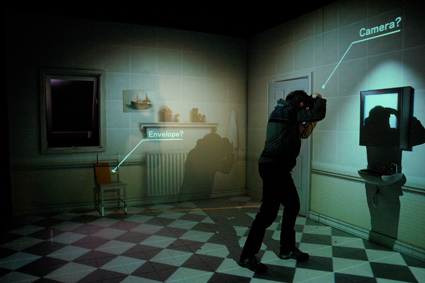
David Heinrich, Half-Real, The Border Project
photo Steve Tilling
David Heinrich, Half-Real, The Border Project
The same can’t be said for The Border Project’s ambitious Half-Real. A murder mystery is played out in a digitally projected setting; audiences choose the course of investigation with handheld remote devices. While the quality of the technology is first-rate, the realisation of the work doesn’t live up to its promise. An uninspired narrative isn’t saved by some strong acting and the novelty of the interactive nature of the work remains just that.
If Assembly drew attention to the shape and direction of the crowd, this proved a distraction in Half-Real. The audience’s choices were simply group votes between two or three options and those choices didn’t have terribly interesting consequences. It never felt as if our relationship as a group was under interrogation, leaving the purpose behind the interactivity unclear. In a mediascape of reality TV, SMS voting, trial by media and the turn to a screen-based culture, it would seem as if a broad variety of pointed questions could be raised through the form of this work. What did eventuate was a generally pleasant and diverting hour; hopefully the real potential for something much more expansive was encountered by its makers during production, and will lead to a more satisfying next stage of development.
–
Melbourne International Arts Festival: Back to Back Theatre/Malthouse Theatre, Ganesh vs the Third Reich, director Bruce Gladwin, performer-devisors Mark Deans, Simon Laherty, Scott Price, Brian Tilley, David Woods, devisors Marcia Ferguson, Bruce Gladwin, Sarah Mainwaring, Kate Sulan, Brian, lighting Andrew Livingston, Bluebottle, design Construction Mark Cuthbertson, costumes Shio Otani, Merlyn Theatre, Malthouse, Oct 1-9; Balletlab, Aviary, director, choreographer Phillip Adams, dancers Phillip Adams, Luke George, Daniel Jaber, Rennie McDougall, Brooke Stamp, Joanne White, Peter AB Wilson, costumes Toni Maticevski, millinery Richard Nylon, composition David Franzke, Phillip Adams, set design Phillip Adams, nest design Matthew Bird, backdrops Gavin Brown, lighting Benjamin Cisterne, Arts House, North Melbourne Town Hall, Oct 19-23; Chunky Move/Victorian Opera, Assembly, director, choreographer Gideon Obarzanek, dancers Sara Black, Nathan Dubber, Benjamin Hancock, Alisdair Macindoe, Lily Paskas, Harriet Ritchie, James Shannon, Frankie Snowdon, music director Richard Gill, lighting Nick Schlieper, costumes, Harriet Oxley, set designer Gideon Obarzanek, Chris Mercer, Melbourne Recital Centre, Oct 6-8; The Border Project, Half-Real, director Sam Haren, writer Duncan Graham, performers Amber McMahon, David Heinrich, Alirio Zavarce, video system design Michael Marner, video artist Chris More, set & lighting Geoff Cobham, composer DJ TR!P, controller Designers Matthew & Ray Gardiner, Tower Theatre, CUB Malthouse, Oct 1-15
RealTime issue #106 Dec-Jan 2011 pg. 5
© John Bailey; for permission to reproduce apply to realtime@realtimearts.net
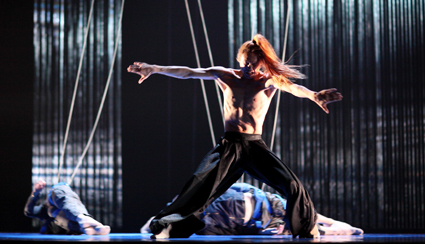
Kaiji Moriyama, Escape, Leigh Warren + Dancers
photo Tony Lewis
Kaiji Moriyama, Escape, Leigh Warren + Dancers
FOR THE FIFTH OZASIA FESTIVAL, THE ADELAIDE FESTIVAL CENTRE AND LEIGH WARREN AND DANCERS PRESENTED DREAMSCAPE, A DOUBLE BILL STITCHED TOGETHER BY LAMINATIONS OF TIME, PLACE AND CONNECTION. ESCAPE IS A WORLD PREMIERE, CHOREOGRAPHED BY WARREN IN ASSOCIATION WITH JAPANESE DANCER-CHOREOGRAPHER KAIJI MORIYAMA. DREAM TIME IS A REVIVAL OF A WORK BY CZECHOSLOVAKIAN CHOREOGRAPHER, JIRÍ KYLIÁN, FIRST PERFORMED IN 1983 AT THE NEDERLANDS DANS THEATER WITH WARREN IN A LEADING ROLE.
Both Escape and Dream Time are set to music by Japanese composer Toru Takemitsu. Australian pianist Simon Tedeschi plays on stage with the dancers in Escape. In a program note, Kylián explains how he met Takemitsu at a dance festival on Groote Eylandt in the Gulf of Carpentaria.
In Escape, three dancers—Bec Jones, Kevin Privett and Jesse Martin—are dressed in cargo pants and sleeveless hoodies. Suspended from above, they abseil into the performance. As they plumb the depths, their exertions are anchored in the vertical. As they sink and rise in clusters, their limbs extend and pivot round their torsos. The Australian dancers have descended into darkness, recalling Warren’s visit to the Akiyoshido cave in Japan. Down there Kaiji Moriyama emerges from within. His fine exploratory gestures reach forward, through the ropes and broken wires that designer Mary Moore has stretched and sprung in tangles. At this depth, Moriyama’s dancing adheres closely to the music, alive with sensitivity and intuition. Echoes bounce and relay between Tedeschi’s sound and Moriyama’s action. Their synchronicity is reminiscent of another nature underground, the speleogenesis of the underworld.
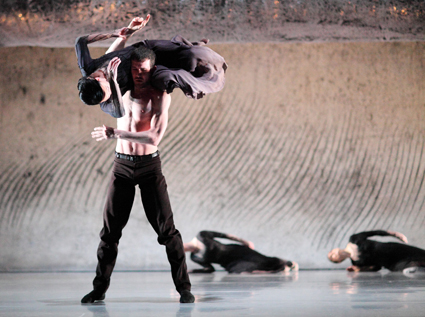
Dreamtime, Leigh Warren + Dancers
photo Tony Lewis
Dreamtime, Leigh Warren + Dancers
By contrast, the choreography of Dream Time extends across the surface. Five dancers—Lisa Griffiths, Bec Jones, Kevin Privett, Adam Synnott and Lizie Vilmanis—strike poses in a barren landscape. They give each other space to dance in pas-de-deux and trios. They yield to the lyricism of locomotion as they reach and sweep across the stage. While the shimmer of the landscape’s horizontal extension is as tensile as Takemitsu’s music, the choreography’s claim to territorial belonging is as tendentious as Martha Graham’s “appetite for space” in Frontier or Appalachian Spring. Warren writes that “it is wonderful to have a chance to share some of my dancing history with the dancers and an audience.” The two works of this double bill are intricately connected through layers of artistic collaboration. The historical transition between the two is recounted by their choreographic distinction: the breadth of territorial expansion in Dream Time is replaced with the depth of interior reflection in Escape.
In Lieu at the Space Theatre saw transient reflections and intangible energies sustain intimate intensities at ground level. The work of Australian-born choreographer and dancer Ade Suharto extends from her dance training at the University of Adelaide to the tari putri style of Javanese dance and beyond, across the choreographies of the Asia-Pacific to Taiwan’s Lin Hwai Min of Cloud Gate Dance Theatre and Lemi Ponifasio’s MAU from Aotearoa/New Zealand. In this performance, Suharto works with composer and musician David Kotlowy who leads Gamelan In Situ through a set of contemporary compositions. Like the rhythmic repetitions of the gamelan, Suharto’s choreography develops interest and complexity through measured repetition. As actions are repeated, their memory is transformed. There is a sense of journey through the dances—patterns of arm to head, of foot to knee, are relayed from there and replayed here.
Suharto dances alongside a long-form trapezoidal screen extending diagonally across the space. Mawarini’s shadow puppetry on the screen is breathtaking in its intricacy and innovation. The shadows—like the dancing and the gamelan—are relieved of responsibility for delivering character or plot. But they encapsulate an evolving world of organic forms which flicker, slide and fade. As a production, the emphasis of In Lieu was on the music. The presence of six gamelan musicians on stage gave the performance its energetic core. Some difficulties in balancing the lighting with the shadows were not entirely solved. Visual interest was sometimes flattened when the dancer lacked the energy of light. Or maybe what I wanted were the visual echoes of other dancers to refract the polyrhythms of the music. OzAsia confronts us with economies of scale that constrain the production of Australian performance. Shaolin Warriors, the crowd-pleaser from China at the Festival Theatre, syndicated its spectacle of martial arts across a cast of 22. The geometric patterns of Suharto’s choreography deserve to be extended beyond the solo. I would like to see their rhythms stretch and echo across an entire dance ensemble.
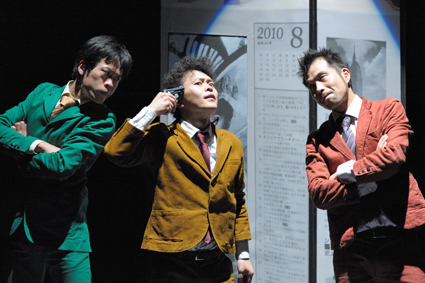
Continent, CAVA, OzAsia 2011
courtesy OzAsia
Continent, CAVA, OzAsia 2011
An individual’s desire to transcend the uniformity of the ensemble drives each of the protagonists in two parables of modern life. In Continent from Japanese mime company, Cava (pronounced sah-va), a jobbing writer’s imagination takes flight, as he struggles to rise above the challenges of the ordinary and find a publisher for his work. A working girl, who makes him tea and brings him lunch, at first distracts him from his writing. She then takes to the typewriter and contributes to his story. But the system is corrupt. He competes with other writers for the publisher’s interest and commission, but submits his script on its merits alone, without the requisite bribe. The writer and his girl—both bespectacled like the Coen Brothers’ Barton Fink—set out against the odds to overcome conformity with the romance of their animated imagination.
Continent is enacted with lightness and precision by five performers; writer and director Kazuaki Maruyama takes the leading role. He pitches the ensemble’s rhythmic mime against a perfect soundtrack of sentimental film-score music wrought with interruptions and cartoon-ish sound effects. The production is colourful and bright. Maruyama’s dramaturgy bears a modernist nostalgia for the mechanisms of the mid-20th century, The work features a portable set that opens and shuts, mime techniques for animating machines and hand-manipulated puppet-props. There is something light and airy about the execution of the piece. Its romance is enchanting.

Rhinoceros in Love, National Theatre of China, OzAsia 2011
courtesy OzAsia
Rhinoceros in Love, National Theatre of China, OzAsia 2011
By contrast, the romance of Rhinoceros in Love is resolutely existential. This “modern classic” from the new China is now more than a decade old. In its 10th anniversary revival for the National Theatre of China, Meng Jinghui directs Liao Yimei’s play with an ensemble cast of young and energetic actors. The story is not particularly striking. The rhinoceros provides an outlet for a young man’s frustrations with love. His would-be lover does little more than offer her rejection. There are soliloquies and scenes of violence, emotional frustration and release. The set is black, hard-edged and cold: mirrors lend its surface depth, cold water spreads across the floor. The metaphor of love’s frustration is extended into space. The play’s existential romance depicts a young man’s individualistic aspiration for love’s promised self-actualisation. But rather than the tortured couple, it was the ensemble—the actors performing as the couple’s cohort of friends—who communicated the pleasures of the piece. (See Douglas Leonard’s review of Brisbane Festival)
The wet depths of the couple’s raw emotion were less compelling than the frontal sarcasm of the actors’ ensemble. With the slick confidence of Chinese television game-show back-chat, their dorm-room gags, sexed-up tricks and dance routines of bubble-pop hip-hop forged direct connections with the audience. It is difficult to capture just how ‘now’ and ‘of the moment’ this production’s crowd-engaging vision of drama felt. Students at Her Majesty’s Theatre in Adelaide roared with pleasure at being captured by the work and its depiction of themselves in its predicament. But ultimately Rhinoceros is ambivalent about love. The couple’s passion is exhausting. Their reward remains elusive. The performance rides upon the power of the ensemble to conjure solidarity from audience response.
Dreamscape: A Double Bill, Leigh Warren and Dancers, Dunstan Playhouse, Sept 2-4; In Lieu, performers Ade Suharto, David Kotlowy, Mawarini, Gamelan In Situ, Space Theatre, Sept 6-7; Continent by Cava, writer, director, performer Kazuaki Maruyama with Takaaki Kuroda, Hiroyuki Fujishiro, Thin Hosomi, Ykiko Tanaka, Space Theatre, Sept 15-17; National Theatre of China, Rhinoceros in Love, writer Liao Yimei, director Meng Jinghui, Her Majesty’s Theatre, Adelaide, Sept 15-17
RealTime issue #106 Dec-Jan 2011 pg. 6
© Jonathan Bollen; for permission to reproduce apply to realtime@realtimearts.net
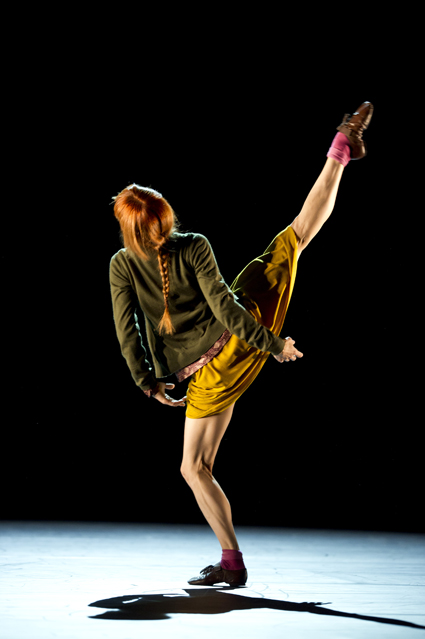
Sylvie Guillem, Bye, 6000 miles away
photo Bill Cooper
Sylvie Guillem, Bye, 6000 miles away
PACKED HOUSES, ENTHUSIASTS AT WORKSHOPS AND HUNDREDS WATCHING FREE PERFORMANCES IN THE FOYER EACH NIGHT—SINGAPORE 2011 DA:NS FESTIVAL CONTINUES TO CREATE A BUZZ. OVERALL THE DIRECTION WAS TOWARDS FAMILIAR EUROPEAN NAMES AND REGIONAL FAVOURITES WITH NO LOCAL PROFESSIONAL COMPANIES PARTICIPATING THIS YEAR.
Most of the artists have appeared in Singapore before and somewhat incongruously, the procession of Spanish soloists and companies continue to tread a well worn, albeit illustrious path to Da:ns Singapore with artists Israel Galván and Ballet Nacional de Espana featured this year. Several broad themes—east and west convergences, cultural synthesis and the deconstruction of traditional forms—underpinned the performances. This year, Hofesh Shechter’s radical Political Mother—with a timely revitalisation of folk dance traditions, complimentary ear plugs and ear splitting music—provided controversy while Sylvie Guillem’s poetic new show gave it virtuosic class and emotional depth.
sylvie guillem
The most outstanding work was undoubtedly Sylvie Guillem’s 6,000 miles away, a tribute performance to the Fukushima victims featuring works by a triumvirate of great choreographers—William Forsythe, Jiri Kylian and Mats Ek. Guillem is a consummate artist at the height of her career. Her personality, rapport with the audience, transformation in roles and styles as she reinvents herself with each work shows curiosity, courage and risk-taking. Forsythe’s Rearray must be among the most complex and technically demanding works she has recently danced, requiring angles and body mapping that only Guillem could achieve with her liquid flexibility and strength. Complex deconstructions of phrases in this duet were punctuated by a series of blackouts that allowed the dancers to begin anew in a new space. Nicolas Le Riche danced superbly adding intricate balletic beats, small jetés and off centre turns—a perfect foil for Guillem’s extensions, arabesques and articulate language of the ballet that constantly dissolved and reformed. Intricate and intimate, it folded and opened out, viscerally dissecting the space. David Morrow’s abstract composition framed the movement yet gave it space, adding an independent voice.
27’52” took Kylian on a road less travelled to trace a relationship in reverse from lovers to childhood playmates. Dancers Aurélie Cayla and Kenta Kojin reminisced, stripping back the layers of children at play. Semi-naked, innocent and joyful before the complications of adult love, they sketched the journey through suspended lifts and protective interactions as she curled foetally in towards him. Ek’s Bye was whimsical and a dramatically exposing solo for Guillem expressing a vulnerable woman facing change. Her extraordinary performance (not to mention the headstands in the yellow skirt) must make her a veritable shoo-in for the next Woody Allen film. Although Ek apparently demonstrated all the steps, it was essentially the image-based concept that drew out the character. Guillem interpreted the images with soulful artistry and a mix of lightness, humour, provocation and some pathos as we recognised the inescapable humanity of aging and change.
pichet klunchun
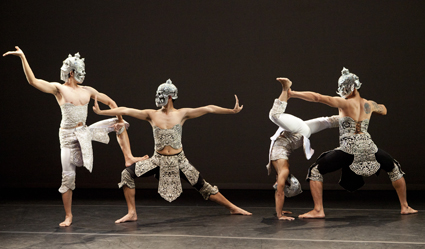
Black and White, Pichet Klunchun
photo Tony Lewis
Black and White, Pichet Klunchun
Choreographers working with tradition (including Galván) had a platform titled Shift in the Esplanade Theatre Studio’s black box. Pichet Klunchun’s Black and White was a festival commission and an absorbing experiment in abstract, non-narrative based dance inspired by the traditional masked dance, Thai Khon. A projected battle scene from the Ramayana in black and white greeted the audience while Chinese guqin musician Wu Na strummed out the dulcet moods of this instrument and four male dancers emerged wearing contemporary versions of traditional Thai Khon costumes—black and white with silver embellishments and masks. Their movement was angular, precise and measured as they set out geometric battle lines inspired by the projected scene. Later choreographer/performer Pichet Klunchun joined the group along with the only female performer Kornkarn Rungsawang in a white lace body suit—her foot-long silver fingernails being the only part of her costume echoing the traditional garb of Thai female dancers. These two appeared to be the guardians of tradition.
After an introductory section whereby the parameters of Khon were established, the first four male dancers stripped to flesh coloured briefs. Fluidly sliding out of their statuesque Khon positions, they deconstruct the form by exploring the possibilities of their bodies and the space. They interacted in mock battles, created pyramids and shapes that referred to their training as Thai Khon dancers and the thematic balance of the Ramayana epic which seeks equilibrium and the victory of good over evil. Masculine and innovative within the context of eastern dance forms where the story usually predominates and dancers rarely assert their individuality in performance, Klunchen creatively pushed the boundaries of his tradition. Nevertheless, at this point, Black and White is like a draft where the dynamics of the choreography have yet to be explored.
jecko siompo
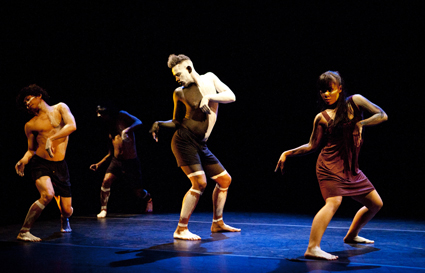
Jecko Siompo and company, We Came from the East
photo courtesy Esplanade Theatres on the Bay
Jecko Siompo and company, We Came from the East
Playful, fun and constantly engaging, West Papuan choreographer Jecko Siompo makes appealing work that has an instant connection with the audience. Through his innovative mix of animalistic gestures and larger body movements that combine contemporary and street dance, he takes us on a journey through the origins of hip hop in his latest work, We Came From the East. His grandmother told him it all started in West Papua and why not? Many of the traditional dance steps from the region are mimetic, inspired by observing animals as they move suddenly, can freeze instantly and move body parts in isolation—just like popping and locking from hip hop. Jecko has named his unique dance language “animal pop.” The animalistic movements include paw-like hands, crawls close to the ground, articulate “talking” feet and lithe, swift movements with the body taut and ready to spring. These were performed with great energy and enthusiasm by the dancers with room for improvisations. However, as the dance wore on it ran out of ideas and became predictable with a disappointing clichéd ending.
next generation
Next Generation was a showcase for the local dance institutions of Nanyang Academy of Fine Arts and LaSalle—they represented the east and west of ideologies with NAFA showing an Asian line-up of choreographers and LaSalle predominantly American and western influences. At NAFA, Korean Sun Ock-Lee’s Zen Dance: Form is Emptiness, Emptiness is Form II was a meditative work combining eastern dance forms and philosophies and Peter Chin’s Syncretitude (Jamaica/Canada) used the rhythms and gestures of the east combined effectively with western movement.
Yet the highlight was Dia Dao Cu Chi by the only student choreographer, Amanda Tay. It transported us to the Cu Chi Tunnels under Ho Chi Minh City where thousands lived during the war. Apart from a cheesy beginning with tourists wandering around snapping the site, it incorporated powerful dance theatre imagery. At LaSalle In the Middle of it, at the Same time (USA) by Loretta Livingston was a beautifully crafted work about spirituality that the dancers could relate to. Liz Lea rocked the east-west synergy in White Light, challenging the dancers with fast vocabulary from her toolbox of contemporary and Bharatanatyam moves to upbeat music. Local choreographer and ex-Cloud Gate dancer Albert Tiong just let them dance: his duo Vary 2, with Khairul Shahrin Johry and Muhammed Sufri Bin Juwahir, was thrilling as the two men powered on relentlessly in a physically tight piece about weight, momentum and balance. Watch out for these talented dancers as they make their mark on the international stage.
The festival seems to be primarily a commercial venture where big names and known quantities prevail over risk and uncertainty. Da:ns 2011 was enjoyable rather than reflective or challenging; after five years of undoubted success some new vitality is needed and it is time the curators expanded their vision to include dance from other countries, including Australia.
Singapore 2011 Da:ns Festival , Esplanade Theatres on the Bay, Oct 7-16
RealTime issue #106 Dec-Jan 2011 pg. 8
© Stephanie Burridge; for permission to reproduce apply to realtime@realtimearts.net
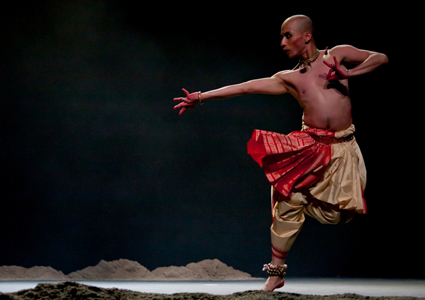
Mavin Khoo, Devi in Absolution
courtesy Parramasala
Mavin Khoo, Devi in Absolution
THERE IS A BUZZ IN THE FOYER OF THE RIVERSIDE THEATRE WHEN I ARRIVE TO SEE MAVIN KHOO’S DEVI IN ABSOLUTION. THE ROOM IS FULL OF PEOPLE WEARING TRADITIONAL INDIAN CLOTHING, BRIGHT PRINTS, PERFUME. IT IS DAY TWO OF THE SECOND PARRAMASALA FESTIVAL OF SOUTH ASIAN ARTS AND MAVIN KHOO IS GIVING A ONE-OFF PERFORMANCE. I GET THE SENSE THAT PEOPLE KNOW WHAT THEY’RE HERE FOR.
devi in absolution
Devi in Absolution is personal. It opens with an introduction by the artist himself—a voice speaking pensively over closed curtains about the ideas behind his choreography. What are the different dimensions of the goddess Devi’s character? What ‘subtexts’ can he pull from the religious literature about her? And how might he dance them?
Curtain up and Khoo stomps in, the bells on his ankles jangling in time with the music. Bare-chested with a white skirt down to his knees, the palms and soles of hands and feet are painted red. Beneath a white marquee five musicians play. Sitars and percussion instruments back the lead vocalist, OS Arun, who coasts on single notes for long periods before launching into improvisations full of melodic loops and whirls.
I am immediately taken by the expressiveness in Khoo’s face and fingers. Hands fly to the face and then away, head bobbing to and fro from the top of the neck, eyes darting around playfully. Without a word he sets up problems and solves them, poses questions and answers them. It is as if he is having a conversation in sign language, communicating so rapidly that when I stop paying attention for a moment I lose track of what is being said.
There are aspects of Khoo’s movement that I assume are typical of his classical Bharata Natyam training: for example the straightening of fingers to a point that seems beyond straight, so that they arch over backwards. But Khoo’s movement is also laced with other techniques. He often turns his way across the stage, whipping round with the delicious intentionality of a dancer who knows how to spot. Later, when the dance escalates into a series of energised leaps I’m almost sure I can see a pas de chat, lifted straight from ballet.
Khoo’s work is a saga in two acts that spans a large number of shapes and stories. In its speed and variety it differs from the next show I see at the festival—Sharira by the Chandralekha Group.
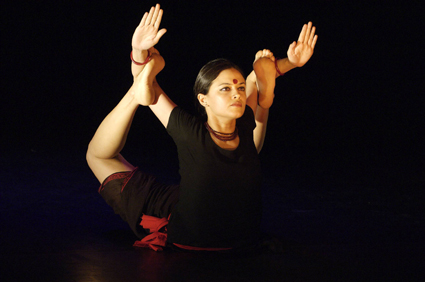
Sharira, Chandralekha Group
courtesy Parramasala
Sharira, Chandralekha Group
sharira
The same excitement stirs in the foyer for this performance. Talk is mainly about the notoriety of the now deceased choreographer Chandralekha’s work. She caused a stir with the sexual charge of her performances, which were feminist in undertone and brought the Bharata Natyam practice out from its devotional context into a more sensual, bodily place.
Sharira is slow, gliding. Bodies are displayed luxuriously. The two dancers wear comfortable clothes and move through a series of postures. These hint at the martial arts influences in Chandralekha’s work, with many being quite intimate. I can see why there was uproar when the work was first performed. The duet opens with a woman lying on her stomach. She undulates on the floor, legs turned out, her back and buttocks rolling up and gently down again. She looks boldly into the audience. The shapes she makes are interesting on a two-dimensional level. I blur my vision now and again to get a better sense of her body as a graphic.
A man enters like a thunderclap.He runs in, batons a straight leg up to his forehead and slaps the leg loudly to create a cracking sound. For a while he performs up on two feet behind the woman, who ripples like a stingray on the floor with her legs and arms splayed. Later he is down on the floor with her. The focus between them is intense. As the piece progresses they climb into each other, exchange weight, swing each other around. They make knots with their limbs and pull into each other to tighten them.
The vocalists dance too in their setup on the far left of the stage. They perform loosely, with feeling, swaying in their seats and making gestures with their hands to access what they’re singing. The slow pace of this piece means I have ample time to take it in. I find myself relaxing into a viewing mode that does not look for narrative or climax.
the other journey
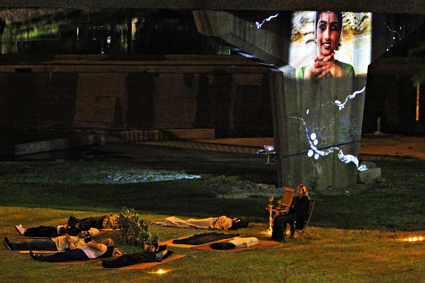
The Other Journey, CuriousWorks
photo Prudence Upton
The Other Journey, CuriousWorks
The last performance I attend is The Other Journey. It invites a distinctly different viewing mode to both Sharira and Devi in Absolution. The facilitators of the evening have called it an “arts adventure,” a theatre event in which you are free to direct your own experience.
A small group of us (no more than 10 or 15) arrive at the bank of the Lennox River for a 7.30pm start. There are campfires burning, a boat moored nearby and straw mats laid out with pillows, blankets and incense burners. On the pylons beneath a nearby bridge I can see brightly coloured video projection. Positioned as I am at the end of a long, hot day, I am overcome by a sense of relief. There is nothing I would rather do at this point than take a boat ride or lie down next to a campfire. This environment promises rest.
We get to choose between a cinnamon stick and a dried chili. Chili takes you to the boat first, cinnamon to the mats and pillows. Chili for me. Before I board the boat a woman sets me up with a pair of headphones and an mp3 player. She is attentive and patient, takes the time to show me where the volume control is. I am surprised by her kindness. On the boat we are quiet. The headphones are isolating. At times we observe each other. At other times we close our eyes to listen to the stories.
Backed by an ambient music track, a voice describes traditional Hindu houses, which usually have a special room where you can take a quiet moment if you wish. The phrase is repeated: “take a quiet moment if you wish.” A different voice talks about moving to Australia, hearing thunder over dinner and thinking it was landmines. Again, a repeat in the audio drives the image home. There are reflections on diaspora and war, thoughts on air shelling and how that’s the worst way to kill a person—much worse than shooting them front-on. These recordings are about the plight of Tamil people during the Sri Lankan civil war and what it has been like for them to travel to and resettle in Australia. I cannot identify a conclusive message in the collection of stories—they are just that, a loose collection.
Disembarking the boat, we are led to the mats. Again, the woman bends down to help me hook up my headphones. She treats me so nicely—“let me sort you out.” As I pull the blanket over me I think about the audio content, about refugee policy and about being “treated nicely.” Maybe there’s something in it—some thinking behind the way we’re being treated tonight.
It is hard to be cerebral in this environment, hard to maintain distance. I feel immersed in it, and invited to relax after a week of performances that have challenged me to sit up straight and keep my eyes wide open—mainly because they have opened up a vast history of dance, aesthetics and politics about which I had little prior knowledge.
Parramasala, Australian Festival of South Asian Arts: Devi in Absolution, dancer Mavin Khoo (Malaysia), lead vocalist OS Arun (India), Riverside Theatre, Nov 1; The Chandralekha Group (India), Sharira, dancer Tishani Doshi, dancer/martial artist Shaji John, lighting designer Sadanand Menon, Riverside Theatre, Nov 2, 3; CuriousWorks, The Other Journey (Australia/Sri Lanka), created by Shakthi Sivanathan, Aimee Falzon, Parramatta River, Parramatta, Sydney, Oct 31-Nov 5; Parramasala, Oct 30-Nov 6, http://parramasala.com
RealTime issue #106 Dec-Jan 2011 pg. 10
© Cleo Mees; for permission to reproduce apply to realtime@realtimearts.net
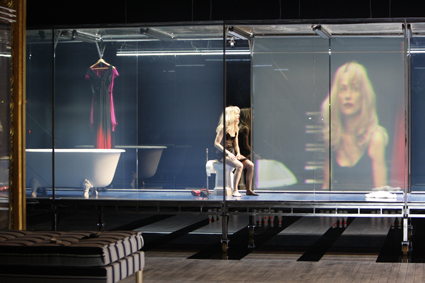
Isabelle Huppert, A Streetcar
photo Pascal Victor – Odéon Théâtre de l’Europe
Isabelle Huppert, A Streetcar
PAUL GRABOWSKY’S 2012 ADELAIDE FESTIVAL PROGRAM, LIKE MOST INTERNATIONAL ARTS FESTIVALS THESE DAYS, HAS WIDE RANGING APPEAL, BUT AT ITS CORE IS A CLUSTER OF EXCITINGLY PROVOCATIVE WORKS BOUND TO TEST AND EXHILARATE AUDIENCES. I SPOKE WITH GRABOWSKY ABOUT JUST HOW HE CAME TO CHOOSE THE WORKS THAT WOULD CERTAINLY DRAW ME TO THIS FESTIVAL, STARTING WITH THE FIRST PRODUCTION TO BE SEEN IN AUSTRALIA BY KRZYSZTOF WARLIKOWSKI, A DIRECTOR WHOSE WORK HAS EMPHATICALLY DIVIDED EUROPEAN CRITICS AND AUDIENCES.
Warlikowski’s Streetcar, featuring leading French actress Isabelle Huppert as Blanche Dubois, is a version of Tennessee Williams’ play, but it is not A Streetcar Named Desire. It is rather a 21st century response to a 20th century classic. Why did you select A Streetcar for your festival?
A combination of things. I’m a great admirer of Krzysztof Warlikowski. In Paris a couple of years ago I saw a production of Angels in America that he did with his Polish company, which I think was TR Warszawa at the time. He has an incredible theatrical vision which we haven’t seen in Australia, an unusual dramaturgical and directional style. And when I heard he was collaborating with [Canadian theatre-maker] Wajdi Mouawad on this production that was going to star Isabelle Huppert, I thought that seems like a very strong team. It’s a production that’s been very controversial in Paris. The French and some international critics haven’t liked it but, you know, I suspect that’s got more to do with the fact that Warlikowski doesn’t shy away from fundamentally altering things. It’s a Streetcar the likes of which English-speaking audiences would not have seen before—not just because it’s in French but because of the way he does it. He doesn’t necessarily remain in any slavish way true to the text. It takes its point of departure from Tennessee Williams’ play and to a large degree is created out of it but I wouldn’t say for a moment that this is a rendition of that play.
Isabelle Huppert is an actress who takes enormous risks.
Reason alone to see A Streetcar. Her performance is a tour de force. It really is all about her and I think Warlikowski has created a real star vehicle for Huppert. That’s why I chose it. The Adelaide Festival shouldn’t shy away from controversy and this man is a very important contemporary theatre maker.
Les Ballets C de la B’s Gardenia is truly a work about transformation, co-created with a theatre director and drawing on a drag community. It has a real cultural specificity about it. Is that what grabbed you?
It’s very moving. I saw it in Avignon. I talked to Frank Van Laecke, the director, and to artistic director Alain Platel (see interview). They gave me a bit of background on the piece and how they worked with these men (and woman in the case of Vanessa Van Durme). Frank talked about how at the very first rehearsal he’d asked these people to bring with them an object from their lives that meant a lot to them. It was almost like a therapeutic process they went through to break through to the level of performance that I think this show really demonstrates. As you would know from drag shows, it’s often very much an amateur kind of theatrical experience and whilst it might have its amusing elements you’ve got to accept that it is what it is—people having fun and, at the same time, making a statement.
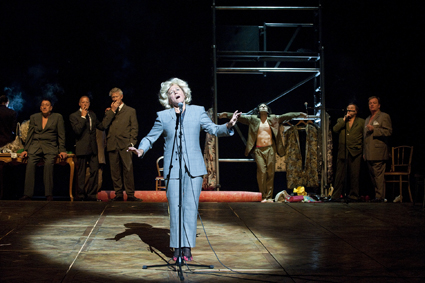
Gardenia, Les Ballets C de La B
photo Luk Monsaert
Gardenia, Les Ballets C de La B
There’s sometimes an element of pathos to drag.
I think Les Ballets C de la B has inverted that kind of paradigm. It’s about discovering the beauty within. So where a lot of drag does sort of end up marooned on the reef of pathos and rarely moves beyond it, this definitely breaks through that and in the end I think we are really exhilarated from the journey that these people have made, not in the Priscilla pop way. The thing about Priscilla is that those guys aren’t actually drag queens—they’re actors pretending. These guys in Gardenia are the real thing.
The music is just gorgeous. Most of all it’s an interesting work, but is it dance? Well I’ll leave that to people to make up their own minds. There is certainly some dance in it. The young Russian in it is amazing—he’s an incredible dancer but he doesn’t even move much. We’re not aware of just how wonderful he is until about a third of the way through the show. So, Gardenia is really a piece of social observation and I think that’s always been an element of Alain Platel’s work as in La Tristeza Complice (RT24, p4) which was the first piece of his I saw—at the Adelaide Festival in 2000. That put a whole lot of people from different social and racial backgrounds onstage together, suggesting that the stage is a level playing field. I feel that over the years Platel has really distilled that social vision and that this work, about a very specific group of people, is at the same time very much of a piece with the general tenor of C de la B’s work.
The Hungarian filmmaker Kornél Mundruczó’s production, Hard to be a God, is another work in which reality and theatre appear to merge. In the interviews I’ve read he’s emphatic that the show is very real (real people, real trucks) but ultimately the artifice of theatre is still there. No one is hurt, the blood is fake but there’s a lot to be said about human trafficking and the very nature of theatre.
That’s right. The performers are actors. We mustn’t assume for a moment they’re the actual people but I’d have to say that in their willingness to really unpack the brutality of that world, these performers are doing us a great service. While we’re aware that human trafficking is a very bad thing, probably very few people probably are aware of just how bad it is, that it is insanely cruel and the people behind it are psychopaths. Their level of inhumanity is appalling. Have we learned nothing from the lessons of the 20th century or prior about the depths to which we can descend? And here’s a group of actors who are able to cope with that on stage. I’d say this is a piece of Brechtian theatre actually because while there’s this dreadful story going on it is framed by another story—an angel is sent by god to observe these people but with instructions not to get involved. And again, music is used to break up the unremitting sadness and intensity. So all of a sudden after what appears to have been the rape and murder of girl X, she’s onstage singing third harmony in a rendition of some Western pop song. Music is used in a very ironic way. There is this absolutely ironic thread that runs through the piece.
I think of the way the word ‘irony’ is used in a book like The Great War and Modern Memory (2000) by Paul Fussell. He talks about the effect of the First World War on the imagination and how, really, the only word or one of the words to describe the experience of that war is irony because it’s so counter to everything that we would expect. This is a very subversive piece of theatre.
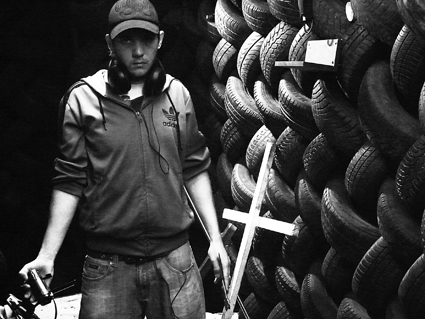
Hard to be a God
photo Márton Ágh
Hard to be a God
And the venue is the old Clipsal factory in Bowden.
Another layer of irony. The play’s set in a pantechnicon, enacted on the back of a truck. That’s, of course, where all this trade takes place, on trucks. And the other thing about Hard to be a God is that it’s also about the relationship between a criminal gang and the politics of the extreme right. So here’s something else which, again, some Australian audiences may not be totally aware of—the very nasty re-emergence of the far right happening right now.
Another work it’s good to see in the program is the Bernstein Mass, which has to be one of the great hybrid works. It’s got everything. Are you staging this as a concert or a music theatre work?
He wrote it as music theatre and that’s the way we’ll be presenting it. I don’t think it would stand up that well as a concert work actually. Bernstein is so theatrical. He describes his Mass as music theatre; he says it’s a piece for dancers, singers and musicians. Its musical span goes from work that really does lean towards his more serious symphonic composition on the one hand to things like Candide or West Side Story on the other: you’ve got to create a context in which all of that makes sense.
We’ve brought together the two major advocates for the work in terms of recent recordings. The American gospel singer Jubilant Sykes performed it with conductor Marin Alsop with the Baltimore Symphony Orchestra [Naxos CD] and the other big recording done recently was by Kristjan Järvi with the Absolute Ensemble [Chandos CD]. Sykes and Järvi have never done it together before and I think it’s quite wonderful that we’ve managed to get these two people both of whom have really championed this piece.
It is amazingly accessible and very beautiful. Some of it sounds so Broadway and other passages, like the meditation for cello, sounds like it comes from the Jewish musical tradition, but the whole coheres.
It’s selling very well. We were surprised. It’s an ecumenical work by a Jewish composer, albeit a very liberal Jewish one, based around the text of a Tridentine Mass of all things—not just a Catholic Mass but the conservative Catholic Mass. Then it’s interspersed with songs by Stephen Schwartz. This is very much a work about faith but it really is also asking what faith is. It’s being directed by Andy Packer from Slingsby, a wonderful local theatre company who do incredibly beautiful work, generally for young people. He’s been assistant director on various productions for South Australian Opera and I think he’ll do a wonderful job.
It’s good also to see The Caretaker in the program—a reminder how powerful Pinter’s work can be.
It’s the epitome of the well-made play, Keith.
Yes, but when it was first produced critics weren’t sure at all whether it was a well-made play or not. There’s no classic exposition, there are no obvious back-stories. The audience really has to work and I think that’s one of the great reasons for reviving it, to show just what supremely clever writing it is about power play, brotherly love and dependence. The form is quite amazing.
You’re right. When I called it a well-made play, I guess I was referring to the way it’s staged. It’s a very fine example of very fine English actors dealing with a classic English text directed by an inveterate English director.
You also have Sydney Theatre Company’s Indigenous work Bloodland (see p32) and a new work from Sydney’s Force Majeure, Never Did Me Any Harm.
Never Did Me Any Harm will be unveiled at the Sydney Festival. We co-commissioned it with the Sydney and Melbourne Festivals. It’s inspired by The Slap—I’m reluctant to say “based on” as there’s so much about Christos Tsiolkas’ novel around at the moment. Kate Champion is a really important maker of dance theatre. We also co-commissioned Bloodland. As you know, I’m very interested in and have a fair bit to do with Indigenous work. I think it’s essential for Australian festivals to invest in it. We need it. Our culture needs it and what good is a festival if it’s not getting on board?
In the works you’ve asked me about, there is a kind of through-line that’s about where art stands in relation to various contemporary issues. Art needs to be seen at these times as attacking causes full frontally in a way that the audience can really get. If art is too obscurantist, then it’s going to put up some kind of smokescreen between it and the audience. While sure, there’s art that depends to a certain extent on obscure language and its delivery system, I think the work I’ve chosen for this festival is very contemporary, it’s very dangerous work to some degree. But there should be no doubt from an audience point of view about what they’re seeing. And then they’re in a position to make a considered judgement about it. People need to feel like they haven’t been left outside the discussion.
Adelaide Festival, March 2-18, www.adelaidefestival.com.au
RealTime issue #106 Dec-Jan 2011 pg. 12-13
© Keith Gallasch; for permission to reproduce apply to realtime@realtimearts.net
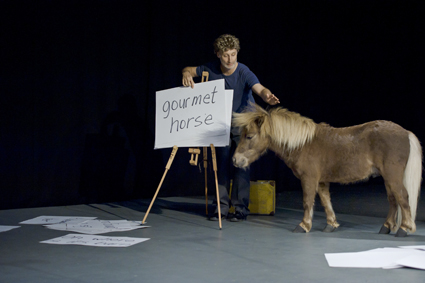
Steve Sheehan, A Little Horseplay
photo Gary Cockburn
Steve Sheehan, A Little Horseplay
WHAT IS A FESTIVAL? WHAT IS AN IDEA? WHAT IS POPULAR? ADELAIDE’S INAUGURAL FESTIVAL OF UNPOPULAR CULTURE, A KIND OF DO-IT-YOURSELF ADJUNCT TO THE ADELAIDE FESTIVAL OF IDEAS, EASILY TRIGGERS SUCH QUESTIONS.
The festival is intended as a showcase of discussion, art, film and performance which has no home in the mainstream cultural milieu. This is, of course, a problematic remit at a time when the mainstream is not easily defined and when the culturally subversive is always being aggressively co-opted by outside interests. It is perhaps just as well then that the festival persistently offsets its own brief through self-deprecation and knowing indifference.
Like its tagline “We Shall See,” everything about the Festival of Unpopular Culture, down to its indecorous acronym, is coolly sardonic, squarely aimed at 20-somethings and arch ironists. The printed program itself is instructive, full of hand-drawn images and text and unfinished, jokey guest biographies. The foreword by the festival’s Creative Director Stan Mahoney simply reads: “Send help.” Whether these represent an authentic challenge to the discourses of ‘mainstream’ cultural festivals or are just self-indulgent in-jokes is difficult to say. This is, after all, a festival in its infancy—though infinitely closer in spirit to adolescence: shambolic, oppositional, coyly idealistic.
j-square and friends: unsilence the silenced
Described as a “cross-lingual writing lab,” Unsilence the Silenced saw J-Square—a loose collective of Adelaide-based new migrant and ‘outsider’ artists—take over the best part of a floor of the Adelaide College of the Arts building, the designated hub of the Festival of Unpopular Culture. It is a show that may once have been described as a happening, perhaps now, in less vivid times, as a performance event. In one part of the open, grey-walled space, projected text appears on a large screen as it is being typed while in another an artist splatters a vast canvas with paint, twigs having replaced brushes, a red clown nose seeming to mollify the painter’s vanity—another self-effacing ruse in a festival filled with them.
The soundtrack—a throbbing, mostly discordant fusion of electric bass and guitar and hip-hop-ish vocalisations—initially jarred but the enduring effect was hypnotic rather than braying. The text perhaps interested me the least, its too-literal engagement with the nature of ideas (“Without ideas, all acts are blind. Ideas and actions are twins. Without one the other is gone”) at odds with the stimulating slipperiness of meaning present elsewhere. It also served ultimately to underline a kind of niggling feeling with which I left Unsilence the Silenced, a sense that the strangeness of the event was everywhere compromised by the intrusion of the familiar, the text framed by the instantly recognisable schemes of Microsoft Word, the event itself ending disconcertingly abruptly as the building’s security staff appeared, the audience ushered out amidst uncertain courtesies from J-Square members. It was a peculiarly numbing climax to what had been an evening rich with expression and potential; perfectly unpopular.
milk theatre collective: alice + peter grow up
Alice (Ashton Malcolm) and Peter (Sebastian Freeman) are already onstage when the small audience files into the Format Collective’s claustrophobic basement theatre. The actors themselves look like an audience of two: seated, blank-faced, expectant. They are, however, swiftly corralled into action by a commanding female voiceover whose task, it seems, is to propel these indolent young people into adulthood. They are expected to dress like grownups (Alice chooses black business clothes, Peter cycling shorts and a loud shirt), go on dinner dates together, make office small talk and discuss important issues without excessive inebriation. Needless to say, the apathetic Alice and the gormless but congenial Peter do not find these enforced routes to adult success and respectability easy and it all ends in hopeless abandonment amidst a pillow fight which is partly flirtatious but mostly childlike. I wanted to give myself over to this moment, to delight in Alice and Peter’s apparent rejection of the adult world and all its suffocating social constructs but there was something a bit tentative about this conclusion and, indeed, about the show more broadly which left me unable to fully engage with it. I couldn’t quite work out who or what were the intended objects of its satire: disciplinarian instructional guides, the perceived narcissism of generations X and Y, the foibles of inner-city yuppies? Like its protagonists, Alice + Peter Grow Up is immature but full of promise: Nescha Jelk’s direction is already adroit but further dramaturgy by playwright Sarah Dunn is required if this work in progress is to come of age.
steve sheehan: a little horseplay
A Little Horseplay is also a work in progress, having enjoyed a second stage of creative development following an initial showing at the 2011 Adelaide Fringe Festival. Written, directed and mostly performed by Steve Sheehan, A Little Horseplay is a playful exploration of the ridiculous, an attempt to mine internal rather than external sources of comedy. It is a show which bears little superficial correlation to any recognisable world of the real, inhabiting instead a kind of psychic, Dadaist space in which the comedy is not derived from gags but rather dreamlike juxtapositions of the sublime and the banal: classical music and bad jokes, opera and fly-swatting, a real miniature horse and a joke shop horse-head mask. An array of elaborate and bizarre props—including a suspended cage which transforms into a dress and a kamikaze bird which provides an unexpected denouement to one of Norma Knight’s strange and lovely arias—enhances the show’s air of endless possibility.
If A Little Horseplay bears any relationship to more conventional comic forms, then it is to the charged, teasing spaces that separate jokes from their punch lines. It is a show almost wholly devoid of such lines; those which do arise are disconnected, neutralising rather than climactic; melancholic rather than mirthful. This is minimalist or, as Sheehan puts it, “ambient” comedy and it works to unsettle our relationship with what is funny, to reframe the avant-garde as farce without sacrificing its essential alienness.
The Festival of Unpopular Culture, creative director Stan Mahoney; Unsilence the Silenced, FUC Hub, Adelaide College of the Arts, Oct 13; Alice + Peter Grow Up: Format Zine Shop, Oct 8-15; A Little Horseplay, Adelaide College of the Arts, Oct 15-16
RealTime issue #106 Dec-Jan 2011 pg. 16
© Ben Brooker; for permission to reproduce apply to realtime@realtimearts.net
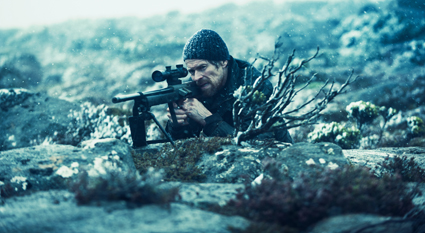
Willem Dafoe, The Hunter
JULIA LEIGH’S DEBUT NOVEL RELATED A WRENCHING PARABLE UNFOLDING IN SIMPLE, CRYSTALLINE PROSE. IT NETTED HER A GENEROUS BASKET OF AWARDS WHILE EARNING HER FANS IN FRANK MOORHOUSE AND DON DELILLO, NOTABLES WHO WERE SUBSEQUENTLY JOINED IN THEIR PRAISE BY TONI MORRISON AND JM COETZEE ON THE RELEASE OF HER EERIE SECOND EFFORT, DISQUIET.
Indeed, Coetzee’s thoughts on the latter—“[it is] so infused with the practices of film that, while each scene is fully and even vividly realised in words, it also translates quite naturally into film”—are equally applicable to The Hunter, Leigh’s coolly impersonal third-person voice in the novel mimicking the all-seeing eye of the camera, the story developing through smoothly contained cinematic chunks.
Although Leigh has since moved into filmmaking in her own right (see Sleeping Beauty, see review), the author has remained outside the adaptation process of her first novel, the film instead being steered by director Daniel Nettheim, whose television work on shows such as Love Is A Four Letter Word and All Saints seems to have prepared him well for the challenges of feature direction. Shooting from Alice Addison’s screenplay (whose credentials include several episodes of My Place, based on Nadia Wheatley’s award-winning book, as well as the Cate Shortland-directed 2006 police procedural The Silence), Nettheim has produced a smoothly mesmerising film that absorbs us without ever quite becoming gripping.
An American mercenary, operating under the name Martin David (Willem Dafoe), is given an assignment by a shadowy biotech company, Red Leaf: travel to Tasmania and find the last Thylacine, or Tasmanian Tiger, kill it, then harvest its blood, skin and reproductive organs to be used for undisclosed research. Operating under the cover of “researching [Tasmanian] devils for the university,” Martin settles into the ramshackle house of Lucy Armstrong (Frances O’Connor), bereft after the disappearance of her husband, and her two children, the beguilingly foul-mouthed Sass (Morgana Davis) and silently watchful Bike (Finn Woodlock), using it as his launchpad into the bush. With Lucy in a self-medicated stupor, Martin is forced to negotiate with the children whose assistance seems dependent on his promise to search for their father, though his interest in them sharpens as he realises that the unspeaking boy may have sighted the elusive Thylacine.
Nettheim has heightened the bitter tensions between conservationists and forestry workers, a stand-off that also formed a backdrop to the novel: in a loggers’ pub a sticker has been amended to read “Save Our Native Jobs,” Martin finds his car with its windows smashed and “go home greenie scum” smeared across the bonnet in faeces after his initial excursion into the wilderness, while the filmmakers apparently used activists’ 2010 blockade of the Upper Florentine as a ready-made set. Martin is steered between the faultlines of Tasmanian society by Jack Mindy (Sam Neill), a rough-spun local who turns standoffish as Martin’s potential as rival for Lucy’s affections becomes apparent.
Although Nettheim has suggested that his treatment of the political forces at work within the state doesn’t take sides, the occasional shot of bark being stripped from a tree trunk like a body being flayed cannot help but have a strong political resonance. Indeed, neither can the 360 degree panoramic helicopter shots of Dafoe trudging through the spectacular landscape of the central Tasmanian plateau. While such footage allows the land to speak for itself, it also emphasises the character’s isolation within it, highlighting the tension that lies at the story’s core: between those who see the world and the creatures that inhabit it as a resource to be utilised for the material ‘progress’ of humanity and those who view it as holding an inherent value and right to exist in itself.
It’s in the way this struggle plays out in the character of Martin that most differentiates the film from its source material. Brilliantly cast as the bland, craggy everyman, Dafoe seems to completely inhabit the role, predatory eyes hinting at a coldly utilitarian intelligence. Martin moves through a staggeringly beautiful landscape with profound disinterest, his mind completely focused on his task, constructing snares and traps for the creature with meticulous patience. Each action unfolds with an unerringly ruthless logic: in one scene the hunter guts a wallaby only to throw the body away once a particular organ has been conserved as bait. The possibility of love with Lucy is similarly sacrificed, Martin maintaining the fiction that the children’s father is simply ‘missing’ for as long as it suits the needs of his mission.
This notwithstanding, the demands that commercial cinema have placed on the plot seem to have fundamentally altered the emphasis of the narrative. Unlike the novel, in which Leigh allows her character’s callous and implacable nature to remain ascendant through to a sublimely bleak conclusion, Nettheim and Addison subtly transform the narrative from a story of the consequences of exerting dominance over nature to that of a man becoming aware of his ethical responsibility towards the natural world. While other alterations to the narrative—such as injecting additional tension by heightening the animosity with the loggers and the hidden presence of Red Leaf—result in strong cinema, this larger change sits uneasily with the material, a fact compounded both by the deeply ambiguous resolution that the filmmakers have given their version of the narrative, but also by the cloyingly saccharine coda that manages to undercut all that has gone before.
Anna Krien concluded her superb 2010 overview of the Tasmanian forestry debate, Into The Woods, musing on Edward O Wilson’s vision of the “Age of Loneliness” that will surely follow the Holocene Extinction Event through which we are currently living: “a planet inhabited by us and not much else…no apocalypse, no doom, no gates of hell, no wrath of god or mass hysteria, only sadness. I wonder if perhaps the Age of Loneliness has already begun, its effects far more complicated than we realise.” A similar melancholy pervades The Hunter, settling in the hollows of Dafoe’s ravaged face, the stillness of the trees. Narrative niggles notwithstanding, Nettheim's film is an important contribution to Australian cinema.
The Hunter, director Daniel Nettheim, novel Julia Leigh, screenplay Alice Addison, producer Vincent Sheehan, director of photography Robert Humphreys, editor Roland Galois
RealTime issue #106 Dec-Jan 2011 pg. 17
© Oliver Downes; for permission to reproduce apply to realtime@realtimearts.net
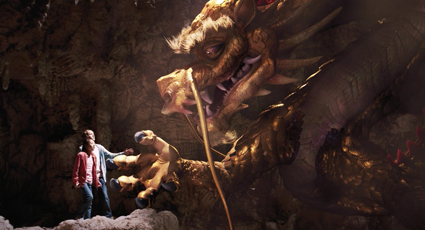
The Dragon Pearl
OZASIA FESTIVAL TIME CAME AND WENT AGAIN IN ADELAIDE, PROVIDING ITS ANNUAL OPPORTUNITY TO BEMOAN THE MARGINALISATION OF ASIAN CINEMA IN AUSTRALIA. BUT WAIT! THIS YEAR PROVIDES SOME ADDITIONAL SPICE WITH THE APPEARANCE OF THE FIRST TWO FEATURES UNDER THE AUSTRALIA-CHINA CO-PRODUCTION TREATY AND THE FORMATION OF THE AUSTRALIA-CHINA SCREEN ALLIANCE AS A MEANS OF PROMOTING FUTURE COLLABORATIONS. THINGS SEEM TO BE SHAKING IN WAYS THAT GO BEYOND THE USUAL LIP SERVICE PAID TO AUSTRALIA’S ASIAN FUTURE WHILE WE’RE ALL AT THE ENDLESS STREAM OF EUROPEAN FILM FESTIVALS THAT FLOOD ART CINEMAS THESE DAYS.
The film program at OzAsia might have been lightly publicised but it still constituted about half of the festival’s sessions. It kicked off with Mario Andreacchio’s China co-production, The Dragon Pearl. Andreacchio is one of those marginalised figures in Australian cinema who is frankly interested in establishing commercial filmmaking. The Dragon Pearl goes straight to the question: how can Australia work with China to make commercial cinema?
Andreacchio’s answer is a children’s film with a cast drawn from internationally known Australasians (Sam Neill), well known mainlanders (Wang Ji) and a Hong Konger (Jordan Chan, who some might remember from the Young and Dangerous films). Add the production facilities of the mammoth Hengdian Studios and CGI from Australian companies such as Rising Sun and you’ve got a Spielbergian adventure that literalises Australian-Chinese co-operation through the figures of two kids who use their complementary talents to restore a lost treasure to a dragon.
On the surface, it is an enjoyable spunky-kids-with-bikes movie, but I wonder if Andreacchio has not also made the boldest piece of Australian political cinema this year. The question of how Australia can manage its relationship with China is clearly of immense importance at present. This film suggests the need for Australians to stop acting like they are still Little Britain and move beyond their lack of sympathy for Asia as a place in which cows are slaughtered inhumanely or refugees are mistreated. The Aussie kid has to get over acting like a big sook because of his parents’ divorce and pay attention to the transformative power of his new Asian context. The young Chinese heroine has undoubted powers and the boy has to find a way to respect that and tailor his talents around it. There is a global aspect to this too, as sinister Americans (or at least, an Australian affecting a Yankee accent) are hovering, intent on stealing the treasure.
All of this is in keeping with Andreacchio’s views on the need to move quickly to set up co-productions in China. With China’s massively expanding cinema (its box office went up 64% last year!) Chinese media production is taking off and Andreacchio warns that we have a small window of opportunity to establish a foothold. For Andreacchio and his Chinese partners, the question of an international cinema that does not include Hollywood is a particularly salient one. China is looking increasingly like the centre of a regional film industry, but whether that regional grouping includes Australia remains a matter of conjecture.
Some of these insights were established during an OzAsia panel discussion that paired Andreacchio with veteran Brian Trenchard-Smith, skyped in from Los Angeles. Trenchard-Smith is another pioneer from the margins of Australian cinema. He directed the 1974 Australia-Hong Kong action co-pro The Man From Hong Kong (which also screened at OzAsia). Trenchard-Smith now looks like a visionary for his early enthusiasm for Hong Kong martial arts and his attempt to build a bridge from Australia to a vibrant commercial cinema. This collaboration was similarly framed within a star system that combined local stars (Wang Yu and George Lazenby) who had enough global recognition to get the project across the line.
The Man From Hong Kong deliriously proposes that a surfeit of mindless violence might just be the currency of co-operation, and that the two film industries might complement each other with the Chinese martial arts specialisation and the Australian fixation on automobile destruction. Andreacchio also explained his film as an attempt at bridging genres in the two countries. He is a maker of family films, but that genre is unknown in China where older people don’t go to movies with their children and the cinema audience is overwhelmingly in the 18 to 25 demographic. Hence, in China The Dragon Pearl foregrounded its small martial arts component and the presence of its Cantopop star in the cast.
The Dragon Pearl represents the massive increase in scale that becomes a possibility opened up by Chinese co-production. Its $18.5 million budget dwarfs most local production, but this enabled it to open on 3,500 screens in China. Back home, the film opened only in Adelaide on a handful of prints. It appears that Australia remains the weak point in Andreacchio’s co-production scheme.
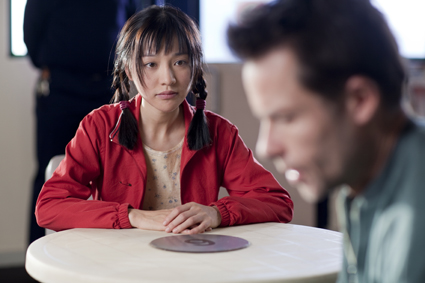
33 Postcards
Pauline Chan was a line producer on The Dragon Pearl while preparing her own 33 Postcards, which screened this year at the Sydney and Melbourne film festivals. This is a smaller film that resides more comfortably within an Australian tradition of the actor-driven cinema of quality. An astonishingly innocent young Chinese orphan girl comes to Sydney to find her Australian aid sponsor, only to discover that he is a convicted criminal (Guy Pearce) addicted to method acting.
While the film attempts to debunk the paternalistic basis from which it begins, it never really succeeds. There are disquieting similarities to another co-pro, 2008’s Children of the Silk Road where the Chinese function primarily as children who have to be saved by benevolent westerners. But let’s throw another couple of recent titles into the mix: the deeply conservative Mao’s Last Dancer, which proposed that China equals repression and the west equals expression, and Tomorrow When the War Began, which took to the bank the fantasy that the cast of Home & Away are our best hope against an Asian invasion.
I can’t help feeling that Mario Andreacchio has a more realistic attitude in understanding that Australians have no natural position of superiority in our region and that China will increasingly deal with us from a position of strength. Australian filmmakers would be well advised to give this some serious aesthetic thought and work out their own strategies to profit from that strength.
OzAsia on Screen, OzAsia Festival, Piccadilly and Mercury Cinemas, Adelaide, Sept 2-17
RealTime issue #106 Dec-Jan 2011 pg. 18
© Mike Walsh; for permission to reproduce apply to realtime@realtimearts.net
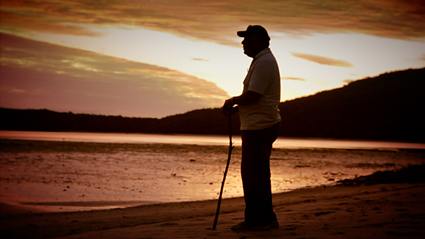
Fantome Island
TWO YEARS AFTER ITS DRASTIC REMODELLING, THE 2011 BRISBANE INTERNATIONAL FESTIVAL CAPITALISED ON WHAT HAS HISTORICALLY BEEN ONE OF ITS GREATEST STRENGTHS—LOCAL AUDIENCES’ THIRST FOR DOCUMENTARY CINEMA—WITH A WELL-PROMOTED EXTENSION OF THE NON-FICTION PROGRAM. REBRANDED AS BIFFDOCS, THE DOCUMENTARY SMORGASBORD INCLUDED LOCAL AND INTERNATIONAL FARE INCLUDING UNFLINCHING EXPOSÉS, CONFRONTING CONFESSIONS AND AFFECTIONATE PORTRAITS, AND OFFERED A NEW COMPETITIVE PRIZE FOR BEST DOCUMENTARY AT THE FESTIVAL’S CONCLUSION.
fantome island
Queensland filmmaker Sean Gilligan’s first feature-length documentary, Fantome Island, interlaces thoughtful interview material with meticulous archival research to bring to light the extraordinary tale of Queensland’s forgotten leper colony. North-east off the coast of Townsville, the Fantome Island leprosarium and its Aboriginal inhabitants were shrouded in secrecy by the state health authorities. The film tracks the journey back to the island by a survivor, Joe Eggmolesse, whose articulate reflections—evidently extracted from hours of interview—are skillfully used to bind and humanise the story.
Gilligan’s achievement is to critically highlight an important new chapter in a now well-known story: the disproportionate suffering of Indigenous people, as much from introduced infectious diseases as from the historical erasure of the particularity of their experience. Fantome Island reverses that tendency with tenderness, insight, and most importantly, richly imaginative detail (a feature shared by another Indigenous-themed doco at the festival, Daniel James Marsden’s 2011, The Clouds Have Stories: The Art of the Torres Strait Islands). While there are incontrovertible links with stolen generation policies, it’s not hard to see in Fantome Island’s central narrative of forcible removal of the unfit by authorities to a remote island prison something of a metaphor for the founding of the nation itself. Fantome Island is the kind of profoundly humane documentary experience that resonates with a rigorous awareness of the social conditions from which it arises.
uma lulik
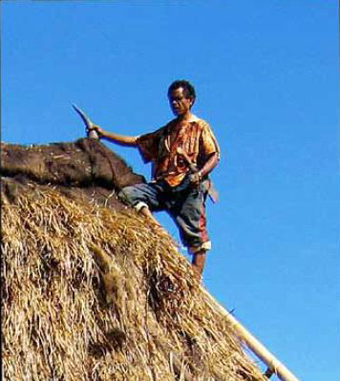
Uma Lulik
Another significant event at BIFF 2011 was the screening of Uma Lulik, the first documentary entirely made in East Timor by an East Timorese filmmaker, Victor De Sousa. It is hard to understate the significance of the Uma Lulik, or Sacred House, in Timor Leste consciousness. As the eternal resting place of family spirits, a place where the living gather to remember and honour their dead, the spirit house occupies a central position in the community. Every 10 years, the community rebuilds the spirit house’s physical structure, in the process maintaining, fortifying and renewing their spiritual connection both to forebears and the land in which all are embedded.
Over the course of Uma Lulik, we follow the remaking of a spirit house, beginning with palm-fringed jungle daybreak, through the fashioning of building materials to erection of the structure. As it documents this communal act of devotion, the film provides us with access to the Timorese sensibility to do with the dead—not as departed but as ever-present, woven through and very much dwelling within the community, resident in the divine structure of the spirit house. This story of the divine—as De Sousa’s poetic text at the opening puts it, “the story they have told me”—is communicated as much through the seemingly prosaic acts of chopping wood or binding eaves as it is through mourning rituals and collective ecstatic song.
the trouble with st mary’s
That mainstay of documentary production, the maverick figure, featured heavily in the BIFFDOCS program, with a number of stories about rebels and trouble-makers benefiting from the feature-length format’s enhanced opportunity for reflection. Local firebrand priest Peter Kennedy, the 72-year-old insubordinate sacked by the Catholic Church in 2009, was the subject of a searching examination by the formidable documentarian Peter Hegedus in The Trouble With St Mary’s. Observing Kennedy and his 1000-strong flock as they come to grips with their exile, Hegedus’ typically intelligent consideration delves into the man and the practices—alteration of ritual processes, allowing women to preach, blessing gay couples and uncompromising commitment to social justice causes—that so infuriated the church orthodoxy. This conscientiously balanced film offers a subtle diagnosis of the role of the progressive South Brisbane suburb of West End as the crucible of the trouble with St Mary’s church.
heroes, legends, rebels
Two films about powerful women stood out: Leila Doolan’s Bernadette: Notes on a Political Journey, about legendary Irish political activist Bernadette Devlin, and A Bitter Taste of Freedom, about the assassination of Russian journalist Anna Politkovskaya. Acclaimed filmmaker Marina Goldovskaya pieced together the final years of her friend, showing her to be by turns fearful of and defiant towards the corrupt Russian authorities into whose activities she clearly probed too deeply.
A hellraiser of a different kind, country music showman Chad Morgan, was the subject of the film I’m Not Dead Yet. Janine Hosking’s portrait documents how the buck-toothed Morgan has attained legendary cult status as much for his bawdy banter between numbers as his dipsomaniacal exploits, both of which are well-documented throughout. The relaxed Sunday afternoon screening time for this film unfortunately clashed with another tribute to an Australian rebel, the retrospective of Sydney experimental film and surf movies guru Albie Thoms. The screening included Thoms’ the cheerfully libertine 1963 film experiment, It Droppeth as the Gentle Rain, a compact selection from the independent Ubu Films collective he co-founded in 1965, and a rare opportunity to view his 1979 post-counter-culture surf movie, Palm Beach. While ostensibly a narrative feature about Sydney surf miscreants, Palm Beach evinces its maker’s experimental theatre heritage with a complexly layered sound montage and compelling adlibbed performances from a cast of mostly non-professional actors, surfers and a pre-stardom Bryan Brown and Julie McGregor.
biffdocs winner: kim ki-duk’s arirang
The 2011 festival offered both ‘traditional’ festival films and fun alternatives (notably, the recreation of a drive-in cinema complete with sentimental family fare and shlocky B-movies). In what is one of the most literal examples of ‘art cinema’, Lech Majewski’s The Mill and the Cross brought a Bruegel painting to life with scrupulous period detail and tasteful CGI, and festival audiences were treated to an opportunity to see the final work of late, great auteur Raul Ruiz, the lavish epic, Mysteries of Lisbon. However, it was South Korean auteur Kim Ki-duk’s Arirang, winner of the BIFFDOCS prize, which perhaps most summed up the festival experience. Kim retreated to a remote country house with only his nervy cat for company following the harrowing experience of shooting his 2008 film, Dream, during which one of his actresses nearly died.
Arirang documents, mostly in close-up, the director’s many moods and thoughts about life, filmmaking and death, with a soundtrack provided by the director crooning the popular Korean folk song of the title. The intense self-reflexivity of these interviews is strongly reminiscent of Werner Herzog’s films, as are the director’s existential ruminations on filmmaking (“I want to confess myself as a director and a human being,” he says at one point). Along with some astute observations on the politics of contemporary international art cinema (he notes that official recognition at home tends to be catalysed by awards won abroad), Kim’s self-interrogation is shot through with his imagining of a persistent knocking sound at the door. While some critics have read this as mere paranoid fantasy, Arirang’s phantom knock could also symbolise the attuned antennae of both filmmakers and film festivals as they respond to, and make manifest, the cultural energies of the latent and the unexpressed.
Brisbane International Film Festival 2011, Nov 3-13, www.biff.com.au
RealTime issue #106 Dec-Jan 2011 pg. 20
© Danni Zuvela; for permission to reproduce apply to realtime@realtimearts.net
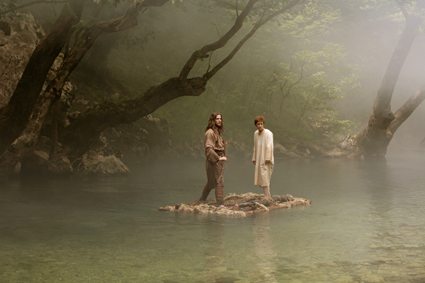
Black Field
A NEW WAVE OF FILMMAKERS AT THIS YEAR’S GREEK FILM FESTIVAL TACKLED SUBJECTS THAT WERE OFTEN AT ODDS WITH TRADITIONAL GREEK CULTURE. THEIR WORKS DISPLAYED CHARACTERISTICS OF REMODERNISM, THE MOVEMENT DEVELOPED BY US PAINTER AND FILMMAKER JESSE RICHARDS IN 2000 WHICH ADVOCATES A MORE CONTEMPLATIVE STYLE OF CINEMA, AVOIDING CONVENTIONAL NARRATIVE STRUCTURE.
Three directors at this year’s festival—Vardis Marinakis, Yannis Economides and Athina Rachel Tsangari—allow events to unfold slowly through an accumulation of quiet moments, making a feature of repetition and dwelling in long takes on their characters’ physical environments. This contributes to a sense of frustration and mundanity in films like Economides’ Knifer and Tsangari’s Attenberg and of transcendent beauty in Marinakis’ Black Field. Two films discussed in this article engage with ancient cultures and emerge full of hope, while the others are studies in modern dislocation and emptiness, their depiction of Greek society less than cheering. Whether dark or light, however, it was heartening to see evidence of thought-provoking, sophisticated contemporary Greek film, despite the country’s current financial woes.
black field
Most distinctive in Marinakis’ Black Field is its creation of an immersive atmosphere that is simultaneously ancient and timeless, something perhaps more attainable in Greece with its still pervasive sense of the Byzantine, the medieval. Set in 1654, during Greece’s long period under the Ottoman Empire, it opens in a mountain monastery where a pious young nun, Anthi, leads a life of spartan ritual. One day a wounded rider collapses outside and is taken captive by the nuns; he is a janissary—one of the many Greek men taken as children to become soldiers in the Ottoman army and converted to Islam.
Anthi finds herself becoming attached to the soldier, something further complicated by the fact that she is really a boy, hidden since infancy among the nuns in order to avoid meeting the same fate as the janissary. As her religious obedience begins to be challenged by growing sexual tension, Anthi’s inner conflict unfolds through seamlessly edited lyrical imagery. Rendered in a palette of greys, the monastery through which the black-shrouded figures move has a stony monumentality that mimics its mountainous surroundings. In her bare cell Anthi lies like a sculpture or, in one of the film’s sudden moments of violence, slashes her inner thigh with a jagged piece of glass in mortification of the flesh. Restrained in his own cell, illuminated by a flickering lantern, the injured janissary is depicted in the manner of a Baroque painting of the dead Christ.
In verdant contrast, the forest to which the pair eventually escape is a glowing prelapsarian world—a place of absolute freedom. The whole film is suffused with an almost visionary quality: an otherworldly sense of the sacred, not limited to a Christian interpretation of the word, conveyed through long, contemplative takes, a paucity of dialogue and an emphasis on the elemental. While its homoerotic theme is to a degree subversive in this religious context, it’s undercut by the fact that a female actor (the remarkable Sophia Georgovassili) plays Anthi, thus rendering the prolonged final sex scene less challenging to conservative audiences, though this departure from realism by no means deprives the film of its power.
knifer
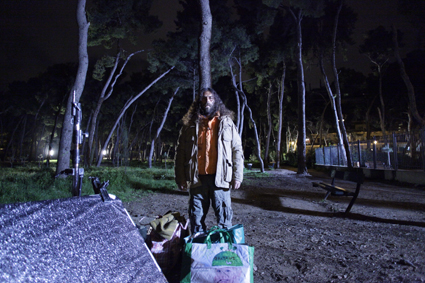
Knifer
“I see Athens as my personal hell,” says Knifer director and co-writer Yannis Economides in an interview on the film’s website (www.knifer.gr). “The reality we are experiencing has not yet been expressed through a contemporary perspective. We are holding onto readymade mythologies. I want to talk about the society in which I live, the people I know, a society in decadence heading towards a dead end.” The result is Knifer, a drawn-out excursion into the banal seaminess of some lives. The film’s central character, Nikos (Stathis Stamoulakatos), is a fat 30-ish good-for-nothing who agrees to move from northern Greece to Athens in order to watch over his crass uncle’s guard dogs. Economides forces the viewer to participate in his protagonist’s bored isolation, introducing scene after lengthy scene of Nikos indulging in unpleasant personal habits, or sitting alone in a range of bars and cafes surrounded by others’ trivial conversation.
Scenes of mundanity are dwelt upon, while the film’s most violent moment passes by quickly; immediately after a murder occurs, the camera lingers in a single excruciating take on Nikos in his hotel room, munching his expressionless way through an entire packet of potato chips. Sex in Knifer is mechanistic and awkward with an edge of the grotesque, a characteristic shared by Athina Rachel Tsangari’s Attenberg, another festival film with emptiness at its heart (albeit with a more appealing protagonist). Stylishly shot in black and white, Knifer drives home its point unambiguously and often searingly, but occasionally risks exhausting its audience’s patience.
the nymphs of hindu kush
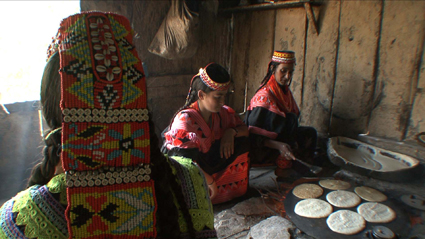
The Nymphs of Hindu Kush
In a different category from Black Field and Knifer, Anneta Papathenasiou’s The Nymphs of Hindu Kush is a documentary focusing on the mountain-dwelling Kalasha tribe of north-west Pakistan. This agrarian community of 4,000 people, who some believe are the descendents of Alexander the Great (though there is no concrete evidence) have maintained their ancient customs and polytheistic religion surrounded by a population of 165 million Muslims. The documentary is wide-ranging, giving an overview of Kalasha life through many interviews and rare footage of ceremonial occasions, but Papathanasiou’s real focus is on the Kalasha women, who seem to enjoy a degree of autonomy greater than that afforded their Muslim countrywomen. Even so, they are constrained by traditional expectations that they will devote their lives to toiling long hours in the fields as well as tending to family at home.
It’s therefore startling to discover the younger generation of Kalasha women are undergoing a sudden transformation: while still strongly attached to their culture, they nurse ambitions for careers in social work, medicine and teaching. This radical shift is to a significant degree the doing of the Greek Volunteers, a Greek NGO that started working to improve health and education in the region, as well as to preserve Kalasha culture, in 1995. As well as building a new school to replace the previous substandard building, the group provided educational scholarships for Kalasha children otherwise too poor to pursue their studies. Thus Shamim Bibi, a young woman whose engaging presence dominates the documentary, was able to study for a social work PhD in Islamabad that she hopes will enable her to improve health and educational infrastructure in Kalasha.
The documentary abruptly changes tack when Athanasios Lerounis, president of the Greek Volunteers, is kidnapped from Kalasha by the Taliban in 2009. All Greeks working in Kalasha including Papathanasiou and her film crew are forced to leave the area—a Pakistani crew continues filming. With her benefactors gone, Shamim’s future hangs in the balance, as does the welfare of her people. Though the unplanned cliffhanger of Lerounis’s kidnapping is an ugly reminder of contemporary conflict, The Nymphs of Hindu Kush is above all a portrait of a remarkable, little-known culture. It also draws attention to a lesser-known aspect of Greek life—a positive one at that.
Black Field will be showing at the 22nd Melbourne Queer Film Festival, March 15-25, 2012
18th Greek Film Festival, Palace Cinemas, Melbourne Oct 12-30; Sydney Oct 13-30; Adelaide Oct 6-9; Brisbane Oct 27-30
RealTime issue #106 Dec-Jan 2011 pg. 21
© Katerina Sakkas; for permission to reproduce apply to realtime@realtimearts.net
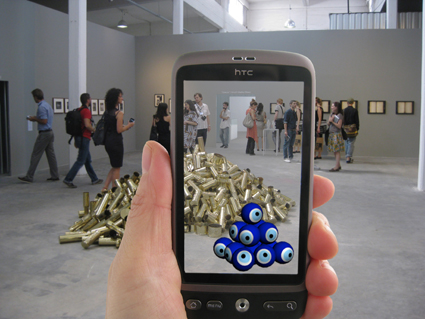
Captured (cannon), Tamiko Thiel, 2011
ALONG THE STEEP, TWISTING COBBLED LANEWAYS AND MAJOR THOROUGHFARES OF ISTANBUL ALIKE, PLAYFUL KITTENS RUN AMOK WHILE THEIR ELDERS LAZILY RECLINE ACROSS DOORSTEPS OR SPRAWL UNSELFCONSCIOUSLY ON STORE MERCHANDISE. THIS SPECIAL STATUS OF STRAY CATS IN ISTANBUL, LOVED AND FED BY LOCALS AND PASSERSBY, PROTECTED AND PROVIDED WITH VETERINARY CARE BY THE STATE, ILLUSTRATES A JUNCTURE OF THE EASTERN AND WESTERN WORLDS—MUSLIM IDEALS OF TOLERANCE MIXED WITH WESTERN-INFLUENCED URBAN BELIEF IN ANIMAL RIGHTS.
Istanbul is a city of not only multiple overlaying levels of social, religious and financial complexity but also of horizontal strata. The senses can be overwhelmed at street level by the cacophony of the immediate. From below it is almost impossible to tell that there is another layer of activity on the rooftop bars and restaurants. However if you ascend by small elevators, breezy views of concrete high rises, glittering mosaics of domed mosques and Mediterranean ambience stretch out before you. This complexity was reflected in the many subjective experiences of ISEA Istanbul—from the immediately seen to the intriguing and ultimately more interesting invisible layers and levels of the event.
symposium
The Symposium, with its impossible to reconcile multiple parallel presentation sessions, was not well attended despite ISEA2011 having 1,350 local and international participants. Some suggested that the venue at Sabanci Center in Levent, accessed by most delegates via several modes of transport and entered through machine gun guarded security points, did not provide a space for easy discussion. The majority of the discourse, fuelled by Tweets, Flickr sets, armchair Facebook commentary and spirited mailing list attacks and defences, centred not so much on art or philosophy, but on organisational models, structure, finances and issues of cultural difference.
The contemporality of many overlaying and intersecting levels of public and private modes of interaction was neatly surveyed by USA-based curator Christiane Paul in her keynote on the shift to network cultures. Today, what used to be thought of as virtual and immaterial (ie online and mediated environments) are ubiquitous and self-performed platforms promoting distributed identity and collectivity. Paul outlined how Mixed Reality experience in gaming, exemplified by groups such as Blast Theory (UK) and Augmented Reality (AR) interaction, predominantly in advertising, are becoming the norm.
the art
And then there was the art. ISEA being co-located in Istanbul and overlapping with the 12th Istanbul Biennial proved an overwhelming lure for a large number of Australian practitioners, academics and writers. That the ISEA exhibitions were part of the Official Parallel Program of the Biennial and the publication of Conference proceedings and inclusion in a special issue of the Leonardo Electronic Almanac (LEA), contributed to this interest. Italian academic Lanfranco Aceti, the ISEA Artistic Director and Conference Chair, proposed that the synergy with the Biennial would provide fruitful exchanges between media arts and fine arts communities, however the members of Australia’s fine arts communities I encountered at the Biennial events were nowhere to be seen at ISEA.
My most synergistic art experiences came under the banner of Invisible Istanbul—a collaboration between media artist Tamiko Thiel (US) and young Istanbul architectural and urban designers Cem Kozar and Isil Ünal of PATTU. Invisible Istanbul uses Augmented Reality to overlay virtual artworks via GPS positioning onto the physical sites around the Biennial. In other words it was an AR Intervention into the Biennale. Any viewer could see several different, unregulated site-specific artworks by launching content on their smartphones or tablet PCs. This mediated layer of visuality provides an arena for dialogue between artists not previously accessible. As Thiel states “The difference is that with AR technology, participation is the decision of the artist, not the curator.”
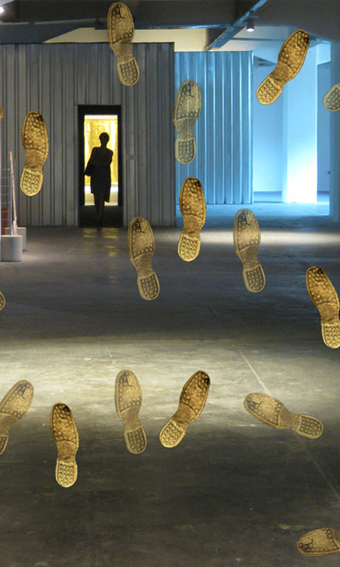
Captured (cannon), Tamiko Thiel, 2011
Situated in Tophane on the former site of the Imperial munitions factory and barracks, Thiel’s Captured Images powerfully overlayed simple objects simultaneously into the contemporary art of the Biennial and its historical space, bringing the relationship between art and politics to the fore. Her Capture (for Hrant) honours assassinated journalist Hrant Dink, an advocate for Turkish-Armenian reconciliation and human and minority rights in Turkey. It is one of the very few works in ISEA that actually references any local or political events, with iconic images of a murdered Hrant’s shoe soles, sourced from broadcast images of his death, visually embedded into the articulated metal displays of the Biennale.
In other works Thiel juxtaposes virtual pencils against discarded armament shells; compares cannon ball production with touristic evil eye amulets; and intertwines swirling ephemeral tweets and hash tags against the clean neon texts of the Biennial.
Another AR work Urban Dynamics, created by PATTU, departs from the Tophane compound to explore the nearby neighbourhoods of Karaköy and Galata. The future and the past of the city are seen in planes and layers through a new set of AR eyes, revealing what has shaped the city and its people from the old docks, beer houses and brothels to the world of haute couture and café society.
Geographical, physical and virtual data spaces truly merged at this ISEA: Manifest.AR inhabited the Kasa Gallery repositioning artworks from their Venice Biennial intervention Orada DegIil; Troy Innocent conducted Neomaflux AR art walks in the Beyoglu neighbourhood; and Andrew Burrell demonstrated care for virtual life forms from The Institute For Advanced Augmentiform Development and Release on the streets around Taksim. Many delegates attended ISEA workshops on AR and VR, as clearly recent developments in soft and hardware development offer a seductive and much richer mediated experience via the current generation of personal devices.
The other main art venue, Cumhuriyet Gallery in Taksim Square, adjoining the major pedestrian thoroughfare of Istiklal Caddesi, was a perfectly positioned and beautifully restored building of rambling colonnades and soft curving spaces. Unfortunately it was not a venue that easily housed electronic art or network connections, and was closed on several occasions when riot police occupied the Square to thwart student protesters and teachers striking for higher wages. Over-crowded schedules, signage issues and long distances between venues, meant many never to be repeated experiences slipped silently under most participants’ radar.
Two such were provided by Richard Castelli (France), director of Epidemic (www.epidemic.net/fr) and producer of much of the most interesting electronic media art and theatre globally. In Istanbul Castelli curated the Madde-Isik 2 (Matter-Light 2) exhibition which included world premieres of the kinetic Assistante Sociale by Jean Michel Bruyère and Kurt Hentschläger’s HIVE, installed over the five floors of Borusan Muzik Evi. A forum for select international cultural operators at ISEA titled “Who Understands Media Art?” clearly gave the message to stop seeing ourselves as different. Castelli’s private guided tours in Per-ili Kösk, the head-quar-ters and con-tem-po-rary art mu-seum of Boru-san Hold-ings, elegantly illustrated capital investment in new art practices within corporate culture.
The disparity between resources for ISEA artists and Castelli’s artists could not have been clearer. Many artists at Istanbul, as is often a feature at any ISEA, were frustrated by installation difficulties. Customs hold-ups compromised the Kathy Clelland curated exhibition Signs of Life: Robot Incubator with Mari Velonaki’s new work in progress Diamandini being delayed, while Kirsty Boyle’s Tree Ceremony, involving a robot interacting with a tree, failed to arrive at all. Meanwhile small robot works brought by the artists, like Boyle’s fragments and John Tonkin’s nervous robots, tumbled and turned in the exhibition space as carefree as Istanbul kittens.
foregoing complexity
ISEA veterans know what to expect and how to work within these resourcing parameters, showing easily transportable and installable works. The curatorium of Sean Cubitt, Vince Dziekan and Paul Thomas cheekily presented The World is Everything That is The Case, art works that were actually housed in suitcases—and not to the detriment of the works. Meditation Wall, the Karen Casey installation (in collaboration with Harry Sokol and Tim Cole) of digital patterns influenced by the artist’s brainwaves, received good international press. Much of the success for the events was due to the tireless and cheerful negotiations of Istanbul-based ISEA Program Director Özden Sahin, who provided help to those caught in cultural and bureaucratic issues, smoothing the way for many.
This ongoing aspect of ISEA is a double-edged sword. While always providing an unprecedented opportunity to extend the scope of international electronic artworks which are rarely seen together in any country, the ISEA exhibitions can fall down through lack of continuous organisational infrastructure. Major artworks often rely on individual artists being able to fund their own exhibition, hence more complex works are forgone for the easy install. The host city’s local arts community and general public do not see the best representation of media arts that they could, hence the shows become hermetic, reaching only a small audience.
isea 2013 australia—the challenge
What lessons can Australia learn before we host ISEA 2013 in Sydney? The last time we hosted this event was TISEA in 1993. It was a pivotal point in media arts history, however financially disastrous for all organisations involved. Hopefully, 20 years later, issues of adequate resourcing and support from major funders and institutions have been addressed. Most importantly ISEA needs to be vital and relevant to the local arts community, leaving us with additional resources, rather than depleted. Can we tolerate another forum for internationals who drop in and out of the country swirling only in their own vacuum-packed culture?
Sean Cubitt opened ISEA by discussing how our standardised technological forms of spreadsheets, databases and geographical information systems have irrevocably altered our understanding of, and relationship to, both time and space. Given the predominant use of this technology is in the management of people, commerce and politics, he suggested that we, as artists and creatives, look for both older and new alternatives to the grids from within which to operate. Perhaps the same can be said for our institutional and festival practices. In order to rebuild or reuse forms which can cut across outmoded structures, we must re-visit, re-examine and re-visualise what it is that we value in our artistic communities in Australia and worldwide.
the informal isea
One successful form at ISEA was an on-the-fly daily discussion forum. Curated by Stephen Kovats, the Lounge@Nuru_Ziya provided a responsive informal program each evening of specific topics fuelled by fresh mint lemonade, local fruits and wines, in a stylish boutique hotel and gallery venue. By the third evening’s Lounge, Terra Virtualis Augmentio, discussing the entwinement of the virtual in everyday materiality and launching the Australian Journal of Virtual Art, its popularity blew out the venue completely. Coinciding with an impromptu -empyre- mailing list meeting, crowds milled outside closing down the narrow street. The Lounge served its purpose in bringing disparate groups of ISEA attendees together, who dispersed in different groupings to local restaurants and bars to engage in face-to-face dialogue.
It seems that informal, interstitial events—where art, information sharing and debate happen in ambiguous moments and spaces—provide a positive way forward. They are sometimes uncomfortable, a little chaotic, often confused; however their loose structure leaves openings for multiple outcomes, rather than tired and predictable ones. But can there be any formula for success when an event is an evolving and growing entity—one aspect that nails it as others spin out of control?
Will future events be more anarchic and energetic—spaces of rational oblivion or controlled frustration? We may not have to worry as Anita Fontaine and Geoffrey Lillemon’s Rainbow X Apocalypse (Australia), a video installation downstairs in the Nuru Ziya gallery, reminds us of the doomsday prophecy that 2012 is the final year of human existence. By creating an afterlife for avatars in the Metaverse, a videogame-esque heaven in which our souls live on for eternity, Fontaine asks a more broadly relevant question. “Is escape into a digital reality the only way forward for the human conscience?…In the face of this looming dystopia, what do we choose? Absolute death or virtual reality?”
at the crossroads
We really are at crossroads with ISEA and many festivals and institutions around the world of similar vintage. The space for many art practices and debates today has shifted into social spaces and out of the gallery. On the virtual and electronic plane many visible and invisible layers compete to inform, direct and augment audiences in ways that previously have not been viable. The new worlds move in invisible data flows, visceral and intuitive vectors, as we develop and nurture subtle sensing organs, both biological and electronic, to detect and experience where they can take us.
Despite its many issues, and after the memory of boats on the Bosphorus, cocktails, parties and bathhouses fade, ISEA Istanbul had depth and presence. The call to prayer ringing across the city at regular intervals deeply resonated within my body and mind. Having a prayer mat in my hotel room (instead of a bible) was deeply encouraging on a global level. It tells me that we do not lack vision and inclusion in our communities, and that there is an alternative to re-presenting outmoded forms. I look forward to an Australian ISEA that will integrate the gems of tradition with experimental formats, in a sustainable mix that inspires and reinvigorates our local arts sectors.
ISEA2011 Istanbul, Sept 14- 21
RealTime issue #106 Dec-Jan 2011 pg. 22
© Melinda Rackham; for permission to reproduce apply to realtime@realtimearts.net
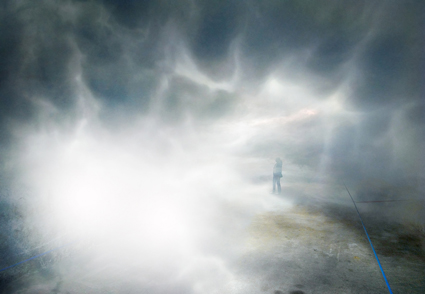
ZEE, Kurt Hentschläger
REWIRE, HELD IN LIVERPOOL IN SEPTEMBER THIS YEAR, WAS THE FOURTH INSTALMENT OF THE MEDIA ARTS HISTORIES CONFERENCES ESTABLISHED BY OLIVER GRAU IN 2005 UNDER THE TITLE RE:FRESH. LIKE RE:PLACE (2007) AND RE:LIVE (2009), THE REWIRE CONFERENCE BROUGHT TOGETHER ARTISTS, ACADEMICS AND CURATORS FROM A WIDE ARRAY OF MEDIA ART BACKGROUNDS TO EXAMINE, DEBATE AND ARGUE ABOUT THE PAST, PRESENT AND FUTURE OF WHAT MANY STILL (STRANGELY) FEEL ARE MARGINAL ART PRACTICES.
As with most academic conferences these days, parallel sessions ensured that any one participant could only sample a portion of the papers on offer. This means that even attendance at the conference provides only a partial view. I’ll try and explicate that view here.
What one gets from being lucky enough to be present (even partially so) is a sense of the state of play in the field of media art histories. Perhaps having just come, like many others at Rewire, from ISEA in Istanbul I’ll admit to feeling fairly attuned to a feeling of anxiety about what the future of the past of media art might be. In a recent article for this magazine (RT104), I noted that one gets a sense that media art practices have begun to be incorporated into more mainstream contemporary arts practices. This is reflected in the subsumption of the category ‘media art’ in education and funding regimes into broader categories of art that reflect how, for example, artists are working with media technologies today. This is then echoed in a sense of urgency, which I felt exhibited itself at Rewire, in relation to how media art maintains an identity as a specific and historical set of practices and outcomes that need to be preserved.
The whole conference series is itself set up for precisely this purpose. This year’s conference took this one step further by formulating and attempting to endorse an international declaration on the need to establish global, networked structures to preserve the recent past of media art history before it is too late. The declaration points out that, “As a result of rapid changes in technology, many major works made even 10 years ago can no longer be shown or are disappearing without a trace. If this situation is not addressed, we face losing an art form that is a central part of our post-industrial digital culture. To date, systematic global preservation and documentation campaigns do not exist.”
It goes on to list a key set of goals that such a campaign might aim to achieve including; recognising and building upon existing knowledge and resources; providing and fostering channels of communication; enabling the international research community to create/upload/access data to be shared; encouraging peer exchange and addressing the new challenges of Media Art; developing scientific technologies for documentation and preservation of Media Art; providing inspiration and resources for curators, artists, scholars, educators and audiences; supporting the Media Art History network, its conference series, text repositories and scientific publications; and promotion of new ways of understanding media art, science, technology and its histories. The declaration has since been posted online and has been endorsed by a long and distinguished list of signatories (www.mediaarthistory.org).
The necessity of ensuring that media art history is preserved and the challenges that this preservation presents to us was also articulated through our exposure, as conference delegates, to some extraordinary media art works. Rewire was chaired by Mike Stubbs, former senior curator at ACMI in Melbourne and now CEO of FACT (Foundation for Art and Creative Technology) based in Liverpool. Consequently, the conference coincided (and collaboratively hosted activities) with this year’s Abandon Normal Devices (AND) event, a regional festival of new cinema and digital culture held in and around Liverpool.
The festival included works such as Kurt Hentschläger’s extraordinary ZEE. Described by Claudia Hart as “the world as viewed by a dying robot clone from the inside of a Turner landscape painting,” ZEE is an installation made from fog, light and sound. Installed in a small, enclosed space, the viewer is immersed in the work for a period of 12 minutes during which time the artist claims to be trying to induce in them a particular kind of sensory overload. After lining up to enter the work and signing a detailed (and slightly scary) medical indemnity form, the viewer is led, along with about eight others, into a room where they are left to experience the work. Upon exiting, many viewers were then approached to articulate the experience to a waiting camera crew. ZEE exemplifies the problems articulated above. How does one ‘preserve’ such a work given that the ‘work’ is a product of audience affect as much as it is a thing in itself? Clearly, Hentschläger is mindful of this as the immediate documentation of the ‘affect effect’ in the form of witness statements testifies.
UK telematics artist Paul Sermon spoke to this very point at Rewire stating that because of the transitory nature of his art he is much more interested in preserving the audience’s response than worrying about the tricky task of making his work last. Finding an adequate way for this to happen, one that also preserves the feeling of experiencing his art, is a real concern for him. For Sermon, the curatorial imperative of making the work reproducible (and hence archivable) is not his first priority.
The conference is itself one mode of preservation of a certain historical trajectory in media art practice. That there was a need to articulate this further in an international declaration which reiterated the need to establish global, networked structures to preserve the recent past of media art history suggests that the conference itself is not sufficient to achieve this aim. I think this is certainly true. The difficulty with conferences in general at present is that there is so much emphasis on academic credentialism—so much so that most Australian academics struggle these days to attend events that are not tied to DEEWR [Department of Education, Employment & Workplace Relations] outcomes—that a genuine conference where one is encouraged, in the true sense of the word, to compare, consult, deliberate and talk over is a rare event indeed. Parallel sessions with papers grouped under conspicuously vague headings such as Philosophies (of what, one might ask) means that attendees, when not rushing from room to room, are left puzzled as to what connections can be made between say a paper titled “Disintegration, Translation, Temporality” and another titled “Polar roses, code and crochet lace: Media non-specificity in craft-based textile forms.” This is not, I should stress, the fault of either the organisers or the presenters.
I would go so far as to argue that it is endemic of academic conferences in general. For that reason, most of the real conferring happens over a beer at dinner or afternoon tea. In the case of Rewire, joint events with the cinema and digital culture festival Abandon Normal Devices allowed delegates a chance to experience events and activities together that the conference format itself made more not less difficult. Perhaps one part of the project to preserve media art histories needs to focus on just this question. How can the precious times when those whose knowledge and memories of media art come together be most effectively used as a time for genuine discussion, debate and decision-making and how can that be preserved? I can’t claim to have the answer to that question but I certainly think it is one that is worth considering.
Rewire: Fourth International Conference on the Histories of Media Art, Science and Technology, host FACT (Foundation for Art and Creative Technology), Sept 28-Oct 1; Abandon Normal Devices (AND) video and arts festival presented in partnership with FACT, Cornerhouse (Manchester) and folly (Lancaster), FACT, Liverpool, UK, Sept 29-Oct 2
RealTime issue #106 Dec-Jan 2011 pg. 23
© Lisa Gye; for permission to reproduce apply to realtime@realtimearts.net
AUSTRALIA’S INTERNATIONALLY RECOGNISED SHORT FILM FESTIVAL, FLICKERFEST, COMMENCES JANUARY 6, SCREENING 100 WORKS—”THE MOST INNOVATIVE, PROVOCATIVE AND ENTERTAINING SHORT FILMS” SELECTED FROM A RECORD 2,173 ENTRIES.
The 2012 festival features international and Australian short films, short documentaries and Greenflicks—films focused on environmental issues. A new addition is Flickerup, “a competition open to student filmmakers from primary to high school age, or filmmakers under 18 years of age from across Australia.”
Competition is a strong component of the festival, not least because the Flickerfest Award for Best Film and the Yoram Gross Award for Best Animation are Academy Award Accredited. Four films from the 2011 program went on to be nominated for Oscars, including The Lost Thing (directors Andrew Ruhemann, Shaun Taun, Australia), which won the Academy Award for Best Animated Short Film and the God of Love (Luke Matheny, US) which won the Academy Award for Best Live Action Short Film.
The 2012 Flickerfest international program includes French director Thomas Cailey’s 25-minute comedy Paris Shanghai which attracted audience awards in France and Pjotr Sapegin’s 13-minute animation The Last Norwegian Troll (Norway) about the challenge of having to preserve something you don’t like (Best Narrative Short, Ottawa Festival, Best Animated Short, Fantastic Festival, Las Vegas).
Australian films include writer-director Zak Hilditch and producer Liz Kearney’s apocalyptic drama, Transmission, focused on a stressed father and daughter relationship in the Western Australian desert; Rodd Rathjen’s comedy The Stranger (which had its first screenings in the 2011 Revelation and Melbourne International Film Festivals); Robert Stephenson’s animation Paris Lakes, described in the Annecy International Animation Festival’s Politically Incorrect program as “A promotion for a new suburb packed with the latest amenities and faux European tastes to satisfy the Australian appetite for easy living”; Nash Edgerton’s Bear, which screened at the 2011 Cannes Film Festival, co-written by Edgerton and David Michod (Animal Kingdom) and including Warwick Thornton (Samson and Delilah) in the cast; and University of Newcastle Lecturer in Communications Jane Shadbolt’s animation, The Cartographer, a film about the limits of mapping which has already won two of the inaugural Australian Production Design Guild Awards.
Flickerfest’s Short Film Showcases include Short Bites of Horror, World of Wacky Animation and From the Oscars—with the Oscars Shorts & Animation Governor, Jon Bloom, showing the best of the Academy Award winning shorts. Post-festival the best from the 2012 Flickerfest will tour to an astonishing 34 cities and regional centres, from Byron Bay to Broome. RT
Flickerfest, 21st Australian International Short Film Festival, Bondi Pavillion, Sydney, Jan 6-15, touring nationally Jan-May, flickerfest.com.au
RealTime issue #106 Dec-Jan 2011 pg. 20
© RealTime ; for permission to reproduce apply to realtime@realtimearts.net




































































